Abstract
Background
Miscarriage occurs in 10% to 15% of pregnancies. The traditional treatment, after miscarriage, has been to perform surgery to remove any remaining placental tissues in the uterus ('evacuation of uterus'). However, medical treatments, or expectant care (no treatment), may also be effective, safe, and acceptable.
Objectives
To assess the effectiveness, safety, and acceptability of any medical treatment for incomplete miscarriage (before 24 weeks).
Search methods
We searched Cochrane Pregnancy and Childbirth's Trials Register (13 May 2016) and reference lists of retrieved papers.
Selection criteria
We included randomised controlled trials comparing medical treatment with expectant care or surgery, or alternative methods of medical treatment. We excluded quasi‐randomised trials.
Data collection and analysis
Two review authors independently assessed the studies for inclusion, assessed risk of bias, and carried out data extraction. Data entry was checked. We assessed the quality of the evidence using the GRADE approach.
Main results
We included 24 studies (5577 women). There were no trials specifically of miscarriage treatment after 13 weeks' gestation.
Three trials involving 335 women compared misoprostol treatment (all vaginally administered) with expectant care. There was no difference in complete miscarriage (average risk ratio (RR) 1.23, 95% confidence interval (CI) 0.72 to 2.10; 2 studies, 150 women, random‐effects; very low‐quality evidence), or in the need for surgical evacuation (average RR 0.62, 95% CI 0.17 to 2.26; 2 studies, 308 women, random‐effects; low‐quality evidence). There were few data on 'deaths or serious complications'. For unplanned surgical intervention, we did not identify any difference between misoprostol and expectant care (average RR 0.62, 95% CI 0.17 to 2.26; 2 studies, 308 women, random‐effects; low‐quality evidence).
Sixteen trials involving 4044 women addressed the comparison of misoprostol (7 studies used oral administration, 6 studies used vaginal, 2 studies sublingual, 1 study combined vaginal + oral) with surgical evacuation. There was a slightly lower incidence of complete miscarriage with misoprostol (average RR 0.96, 95% CI 0.94 to 0.98; 15 studies, 3862 women, random‐effects; very low‐quality evidence) but with success rate high for both methods. Overall, there were fewer surgical evacuations with misoprostol (average RR 0.05, 95% CI 0.02 to 0.11; 13 studies, 3070 women, random‐effects; very low‐quality evidence) but more unplanned procedures (average RR 5.03, 95% CI 2.71 to 9.35; 11 studies, 2690 women, random‐effects; low‐quality evidence). There were few data on 'deaths or serious complications'. Nausea was more common with misoprostol (average RR 2.50, 95% CI 1.53 to 4.09; 11 studies, 3015 women, random‐effects; low‐quality evidence). We did not identify any difference in women's satisfaction between misoprostol and surgery (average RR 1.00, 95% CI 0.99 to 1.00; 9 studies, 3349 women, random‐effects; moderate‐quality evidence). More women had vomiting and diarrhoea with misoprostol compared with surgery (vomiting: average RR 1.97, 95% CI 1.36 to 2.85; 10 studies, 2977 women, random‐effects; moderate‐quality evidence; diarrhoea: average RR 4.82, 95% CI 1.09 to 21.32; 4 studies, 757 women, random‐effects; moderate‐quality evidence).
Five trials compared different routes of administration, or doses, or both, of misoprostol. There was no clear evidence of one regimen being superior to another.
Limited evidence suggests that women generally seem satisfied with their care. Long‐term follow‐up from one included study identified no difference in subsequent fertility between the three approaches.
Authors' conclusions
The available evidence suggests that medical treatment, with misoprostol, and expectant care are both acceptable alternatives to routine surgical evacuation given the availability of health service resources to support all three approaches. Further studies, including long‐term follow‐up, are clearly needed to confirm these findings. There is an urgent need for studies on women who miscarry at more than 13 weeks' gestation.
Keywords: Female; Humans; Pregnancy; Watchful Waiting; Abortifacient Agents, Nonsteroidal; Abortifacient Agents, Nonsteroidal/administration & dosage; Abortifacient Agents, Nonsteroidal/adverse effects; Abortion, Incomplete; Abortion, Incomplete/therapy; Administration, Intravaginal; Administration, Oral; Diarrhea; Diarrhea/chemically induced; Extraction, Obstetrical; Extraction, Obstetrical/methods; Gestational Age; Misoprostol; Misoprostol/administration & dosage; Misoprostol/adverse effects; Nausea; Nausea/chemically induced; Pregnancy Trimester, First; Randomized Controlled Trials as Topic; Vomiting; Vomiting/chemically induced
Plain language summary
Medical treatments for incomplete miscarriage
What is the issue?
Miscarriage is when a pregnant woman loses her baby before the baby would be considered able to survive outside the womb, i.e. before 24 weeks' gestation. Miscarriage occurs in about 10% to 15% of pregnancies and the signs are bleeding, usually with some abdominal pain and cramping. The traditional management of miscarriage was surgery but this Cochrane Review asks if medical treatments can be another management option for the woman.
Why is this important?
The cause of miscarriage is often unknown, but most are likely to be due to abnormalities in the baby’s chromosomes. Women experiencing miscarriage may be quite distressed, and there can be feelings of emptiness, guilt, and failure. Fathers can also be affected emotionally. Traditionally, surgery (curettage or vacuum aspiration) has been the treatment used to remove any retained tissue and it is quick to perform. It has now been suggested that medical treatments (usually misoprostol) may be as effective and may carry less risk of infection.
What evidence did we find?
We searched for evidence on 13 May 2016 and identified 24 studies involving 5577 women, and all these studies were of women at less than 13 weeks' gestation. There were a number of different ways of giving the drugs and so there are limited data for each comparison.
Overall, the review found no real difference in the success between misoprostol and waiting for spontaneous miscarriage (expectant care), nor between misoprostol and surgery. The overall success rate of treatment (misoprostol and surgery) was over 80% and sometimes as high as 99%, and one study identified no difference in subsequent fertility between methods of medication, surgery or expectant management. Vaginal misoprostol was compared with oral misoprostol in one study which found no difference in success, but there was an increase in the incidence of diarrhoea with oral misoprostol. However, women on the whole seemed happy with their care, whichever treatment they were given.
What does this mean?
The review suggests that misoprostol or waiting for spontaneous expulsion of fragments are important alternatives to surgery, but women should be offered an informed choice. Further studies are clearly needed to confirm these findings and should include long‐term follow‐up. There is an urgent need for studies on women who miscarry at more than 13 weeks' gestation.
Summary of findings
Summary of findings for the main comparison. Misoprostol compared to expectant care for incomplete miscarriage.
| Misoprostol compared to expectant care for incomplete miscarriage | ||||||
| Patient or population: incomplete miscarriage Setting: hospitals in Australia, Sweden, United Kingdom Intervention: misoprostol Comparison: expectant care | ||||||
| Outcomes | Anticipated absolute effects* (95% CI) | Relative effect (95% CI) | № of participants (studies) | Quality of the evidence (GRADE) | Comments | |
| Risk with expectant care | Risk with Misoprostol | |||||
| Complete miscarriage | Study population | RR 1.23 (0.72 to 2.10) | 150 (2 RCTs) | ⊕⊝⊝⊝ VERY LOW 1, 2, 3 | ||
| 579 per 1000 | 712 per 1000 (417 to 1000) | |||||
| Moderate | ||||||
| 687 per 1000 | 845 per 1000 (494 to 1000) | |||||
| Surgical evacuation | Study population | RR 0.62 (0.17 to 2.26) | 308 (2 RCTs) | ⊕⊕⊝⊝ LOW 1 2 | ||
| 312 per 1000 | 193 per 1000 (53 to 704) | |||||
| Moderate | ||||||
| 327 per 1000 | 202 per 1000 (56 to 738) | |||||
| Unplanned surgical intervention | Study population | RR 0.62 (0.17 to 2.26) | 308 (2 RCTs) | ⊕⊕⊝⊝ LOW 1 2 | ||
| 312 per 1000 | 193 per 1000 (53 to 704) | |||||
| Moderate | ||||||
| 327 per 1000 | 202 per 1000 (56 to 738) | |||||
| Women's views/acceptability of method | Study population | ‐ | (0 study) | ‐ | No data | |
| see comment | see comment | |||||
| Nausea | Study population | ‐ | (0 study) | ‐ | No data | |
| see comment | see comment | |||||
| Vomiting | Study population | ‐ | (0 study) | ‐ | No data | |
| see comment | see comment | |||||
| Diarrhoea | Study population | ‐ | (0 study) | ‐ | No data | |
| see comment | see comment | |||||
| *The risk in the intervention group (and its 95% confidence interval) is based on the assumed risk in the comparison group and the relative effect of the intervention (and its 95% CI). CI: confidence interval; RCT: randomised controlled trial; RR: risk ratio. | ||||||
| GRADE Working Group grades of evidence High‐quality: We are very confident that the true effect lies close to that of the estimate of the effect. Moderate‐quality: We are moderately confident in the effect estimate: The true effect is likely to be close to the estimate of the effect, but there is a possibility that it is substantially different. Low‐quality: Our confidence in the effect estimate is limited: The true effect may be substantially different from the estimate of the effect. Very low‐quality: We have very little confidence in the effect estimate: The true effect is likely to be substantially different from the estimate of effect. | ||||||
1 One study blinded (placebo‐controlled), but the other unblinded. 2 High levels of heterogeneity. 3 Only two trials, including a total of 150 women.
Summary of findings 2. Misoprostol compared to surgery for incomplete miscarriage.
| Misoprostol compared to surgery for incomplete miscarriage | ||||||
| Patient or population: incomplete miscarriage Setting: clinics and hospitals in Australia, Burkina Faso, Egypt, Ecuador, Ghana, India, Mauritania, Mozambique, Niger, Nigeria, South Africa, Tanzania, Turkey, Uganda, USA Intervention: misoprostol Comparison: surgery | ||||||
| Outcomes | Anticipated absolute effects* (95% CI) | Relative effect (95% CI) | № of participants (studies) | Quality of the evidence (GRADE) | Comments | |
| Risk with surgery | Risk with Misoprostol | |||||
| Complete miscarriage | Study population | RR 0.96 (0.94 to 0.98) | 3862 (15 RCTs) | ⊕⊝⊝⊝ VERY LOW 1, 2, 3 | ||
| 992 per 1000 | 963 per 1000 (943 to 982) | |||||
| Moderate | ||||||
| 1000 per 1000 | 970 per 1000 (950 to 990) | |||||
| Surgical evacuation | Study population | RR 0.05 (0.02 to 0.11) | 3070 (13 RCTs) | ⊕⊝⊝⊝ VERY LOW 1, 2, 4, 5 | ||
| 985 per 1000 | 49 per 1000 (20 to 108) | |||||
| Moderate | ||||||
| 1000 per 1000 | 50 per 1000 (20 to 110) | |||||
| Unplanned surgical intervention | Study population | RR 5.03 (2.71 to 9.35) | 2690 (11 RCTs) | ⊕⊕⊝⊝ LOW 1, 6 | ||
| 8 per 1000 | 38 per 1000 (21 to 71) | |||||
| Moderate | ||||||
| 9 per 1000 | 45 per 1000 (24 to 83) | |||||
| Women's views/acceptability of method | Study population | RR 1.00 (0.99 to 1.00) | 3349 (9 RCTs) | ⊕⊕⊕⊝ MODERATE 7 | ||
| 981 per 1000 | 981 per 1000 (971 to 981) | |||||
| Moderate | ||||||
| 982 per 1000 | 982 per 1000 (972 to 982) | |||||
| Nausea | Study population | RR 2.50 (1.53 to 4.09) | 3015 (11 RCTs) | ⊕⊕⊝⊝ LOW 1, 2 | ||
| 84 per 1000 | 210 per 1000 (128 to 343) | |||||
| Moderate | ||||||
| 44 per 1000 | 110 per 1000 (67 to 179) | |||||
| Vomiting | Study population | RR 1.97 (1.36 to 2.85) | 2977 (10 RCTs) | ⊕⊕⊕⊝ MODERATE 1 | ||
| 29 per 1000 | 56 per 1000 (39 to 82) | |||||
| Moderate | ||||||
| 20 per 1000 | 39 per 1000 (27 to 56) | |||||
| Diarrhoea | Study population | RR 4.82 (1.09 to 21.32) | 757 (4 RCTs) | ⊕⊕⊕⊝ MODERATE 1 | ||
| 0 per 1000 | 0 per 1000 (0 to 0) | |||||
| *The risk in the intervention group (and its 95% confidence interval) is based on the assumed risk in the comparison group and the relative effect of the intervention (and its 95% CI). CI: confidence interval; RCT: randomised controlled trial; RR: risk ratio. | ||||||
| GRADE Working Group grades of evidence High‐quality: We are very confident that the true effect lies close to that of the estimate of the effect. Moderate‐quality: We are moderately confident in the effect estimate: The true effect is likely to be close to the estimate of the effect, but there is a possibility that it is substantially different. Low‐quality: Our confidence in the effect estimate is limited: The true effect may be substantially different from the estimate of the effect. Very low‐quality: We have very little confidence in the effect estimate: The true effect is likely to be substantially different from the estimate of effect. | ||||||
1 Lack of blinding. 2 High heterogeneity. 3 Lack of smaller studies showing a RR more than 1. 4 Wide confidence interval crossing the line of no effect and small sample size. 5 Asymmetrical funnel plot. 6 Variation of effect size regardless of the study size. 7 Downgraded for overall risk of bias (limitations in design).
Background
Description of the condition
Miscarriage is generally defined as the spontaneous loss of a pregnancy prior to 24 weeks' gestation, that is, before the fetus is usually viable outside the uterus (Shiers 2003). The clinical signs of miscarriage are vaginal bleeding, usually with abdominal pain and cramping. If the pregnancy has been expelled, the miscarriage is termed 'complete' or 'incomplete' depending on whether or not tissues are retained in the uterus. If a woman bleeds but her cervix is closed, this is described as a 'threatened miscarriage' as it is often possible for the pregnancy to continue and not to miscarry (RCOG 2006; Shiers 2003); if the pregnancy is in the uterus but the cervix is open, this is described as an 'inevitable miscarriage', i.e. it will not usually be possible to save the pregnancy and fetus. The now widespread use of ultrasound in early pregnancy, either for specific reasons (e.g. bleeding) or as a routine procedure, reveals pregnancies that are destined to inevitably miscarry, because they are 'non‐viable' (Sawyer 2007; Weeks 2001). Non‐viable pregnancies are either a 'missed miscarriage' if an embryo or fetus is present but is dead, or an 'anembryonic pregnancy' if no embryo has developed within the gestation sac.
Regardless of the type of miscarriage, the overall incidence is considered to be between 10% and 15%, although the real incidence may be greater (Shiers 2003). Most miscarriages occur within the first 12 weeks of pregnancy and are called 'early miscarriage', with those occurring after 13 weeks being known as 'late miscarriage'. The cause of miscarriage is generally unknown, but most are likely to be due to chromosomal abnormalities. The risk of miscarriage has been reported to be higher in older women, and where there are structural abnormalities of the genital tract, infection, and maternal complications such as diabetes, renal disease, and thyroid dysfunction. Also, some environmental factors have been linked with miscarriage, including alcohol and smoking (Shiers 2003). Miscarriage can sometimes lead to haemorrhage and infection, and it can be an important cause of morbidity, and even mortality, particularly in low‐income countries (Lewis 2007).
Women experiencing miscarriage may be overwhelmed by the symptoms and also quite distressed (Shiers 2003). Psychological problems can follow a miscarriage, and these can include loss of self‐esteem resulting from the woman's feeling of inability to rely on her body to give birth (Swanson 1999). Emotional responses described include those of emptiness, guilt, and failure (Swanson 1999). There can also be depression, anxiety, grief, and anger (Klier 2002; Thapar 1992). A number of other consequences, including sleep disturbance, social withdrawal, anger, and marital disturbance, may occur following miscarriage (Lok 2007). Fathers can also be affected emotionally (Klier 2002).
Description of the intervention
Traditionally, all pregnancies that had miscarried were considered by clinicians as potentially incomplete. Therefore, surgical curettage ('evacuation of the uterus') was performed routinely to remove any retained placental tissue. If no tissue was obtained, then a retrospective diagnosis of complete miscarriage was made. Surgical curettage was the 'gold standard management' for miscarriage for many years because it is quickly performed and it is possible to completely remove any retained products of conception (Ankum 2001). Histological examination of the removed tissues also allowed exclusion of trophoblastic disease, e.g. hydatidiform mole ‐ although this is quite rare. New clinical approaches have evolved to try to minimise unnecessary surgical interventions whilst aiming to maintain low rates of morbidity and mortality from miscarriage. These approaches have included ultrasound imaging to diagnose complete miscarriage and thus avoid treatment, or more conservative treatments of incomplete miscarriage, such as drug (medical) treatment or no active treatment (expectant management) (Ankum 2001; Luise 2002). Various types of medical treatment could be suitable as alternatives to routine surgical treatment for miscarriage and these include the use of prostaglandins, or other uterotonic (uterus‐contracting) drugs or anti‐hormone therapy.
How the intervention might work
a) Prostaglandins, e.g. misoprostol, prostaglandin F2alpha
Misoprostol is a synthetic prostaglandin E1 analogue and is marketed for the prevention and treatment of peptic ulcers. Recognised as a potent method for pregnancy termination (Costa 1993; Norman 1991), it is inexpensive, stable at room temperature, and has few systemic effects, although vomiting, diarrhoea, hypertension, and even potential teratogenicity (causing fetal malformation) when misoprostol fails to induce the abortion, have been reported (Fonseca 1991).
Misoprostol has been shown to be an effective myometrial stimulant of the pregnant uterus, selectively binding to EP‐2/EP‐3 prostanoid receptors and stimulating contractions, which push the products or pregnancy out. It is rapidly absorbed orally and vaginally. Vaginally‐absorbed serum levels are more prolonged, and vaginal misoprostol may have locally‐mediated effects (Zieman 1997). Misoprostol could be especially useful in low‐income countries, where transport and storage facilities are inadequate, and the availability of uterotonic agents and blood is limited. Its use in obstetrics and gynaecology has been explored, especially to induce first and second trimester abortion (Costa 1993; Norman 1991), for the induction of labour (Alfirevic 2014; Hofmeyr 2010), and for the prevention of postpartum haemorrhage (Tuncalp 2012). The stimulatory actions of misoprostol on the early pregnancy uterus could, in theory, help to expel retained tissue from the uterus after miscarriage, and provide an attractive medical alternative to surgical treatment of incomplete miscarriage (Chung 1995). It is important to distinguish between the use of misoprostol for incomplete miscarriage and its use for termination of viable pregnancies.
b) Other uterotonics, e.g. ergometrine, oxytocin
Ergometrine (extracted from the rye fungus, ergot) will promote contraction of involuntary muscles throughout the body (Hawk 1985; Kawarabayashi 1990), and oxytocin promotes strong rhythmic contractions of the uterus (Arthur 2007; Mota‐Rojas 2007). Both drugs could potentially have a role in expelling tissue after miscarriage.
c) Progesterone antagonist
A number of progesterone antagonists are now available, and these drugs will interfere with the production, or functioning, or both, of progesterone. The progesterone antagonist, mifepristone, has an established role in the termination of first and second trimester pregnancy (Jain 2002), and may also be effective in promoting expulsion of retained placental tissues following miscarriage (Tang 2006b).
Why it is important to do this review
Bleeding in early pregnancy is the most common reason for women to present to the gynaecology emergency department, and in many of these women, miscarriage will be diagnosed (Ramphal 2006). It is now clear that routine surgical evacuation of the uterus following miscarriage may not be indicated, and the subsequent risk of infection, haemorrhage, cervical damage, uterine perforation, and risks of anaesthesia may not be justified (Harris 2007). In order to optimise clinical management of this common condition, it is important to establish whether the use of medical treatment (drugs), or expectant management (no routine treatment) may offer a safer alternative for women with incomplete miscarriage, and whether there are specific circumstances where one type of treatment plan is superior to others.
We initially aimed to systematically review medical treatments for both non‐viable pregnancies and incomplete miscarriages combined. On further reflection, this seemed illogical. Non‐viable pregnancies contain viable trophoblast (placental) tissue, which produces hormones, which may in theory make these pregnancies more susceptible to anti‐hormone therapy and more resistant to uterotonic (stimulating uterine contractions) therapy than pregnancies in which (incomplete) miscarriage has already taken place. Therefore, this review focuses on the management of incomplete miscarriage. Another Cochrane Review has covered non‐viable pregnancies (Neilson 2006).
Other relevant Cochrane Reviews on the treatment of miscarriage include: 'Expectant care versus surgical treatment for miscarriage' (Nanda 2012), 'Surgical procedures for evacuating incomplete miscarriage' (Tuncalp 2010), 'Anaesthesia for evacuation of incomplete miscarriage' (Calvache 2012), and 'Follow‐up for improving psychological well being for women after a miscarriage' (Murphy 2012). There is also a series of Cochrane Reviews on the possible prevention of miscarriage (Aleman 2005; Bamigboye 2003; Empson 2005; Haas 2013; de Jong PG 2014; Wong 2014; Balogun 2016). In addition, there are Cochrane Reviews on medical and surgical interventions for induced abortions (Dodd 2010; Kulier 2011; Lohr 2008; Wildschut 2011; Say 2010).
Objectives
To assess the effectiveness, safety, and acceptability of any medical treatment for incomplete miscarriage (before 24 weeks).
Methods
Criteria for considering studies for this review
Types of studies
We only included randomised controlled trials (RCTs). Cluster‐randomised trials were eligible for inclusion, although we did not identify such trials. We excluded quasi‐RCTs and cross‐over trials. We also excluded conference proceedings and abstracts.
Types of participants
Participants were women being treated for spontaneous miscarriage (pregnancy loss at less than 24 weeks), either where there was ultrasound evidence of retained tissue (incomplete miscarriage) or where the diagnosis had been made on clinical grounds alone, and where there would be uncertainty whether the miscarriage was complete or incomplete. In communities in which termination of pregnancy was illegal or unavailable, this could have included women who had undergone unsafe abortion.
We excluded women with non‐viable pregnancies (i.e. where the embryo or fetus had died in utero, but in whom miscarriage had not yet occurred) as they are covered by another Cochrane Review (Neilson 2006).
We also excluded studies on induced abortion of a live fetus and for fetal anomaly as these are covered in other Cochrane Reviews (Dodd 2010; Kulier 2011; Lohr 2008; Wildschut 2011; Say 2010).
Types of interventions
We considered trials if they compared medical treatment of incomplete miscarriage with other methods (e.g. expectant management, placebo, or any other intervention including surgical evacuation, either curettage or vacuum aspiration). We also included comparisons between different routes of administration of drugs (e.g. oral versus vaginal), or between different drugs or doses of drug, or duration or timing of treatment, if data existed.
Types of outcome measures
Primary outcomes
Complete miscarriage (diagnosis of complete miscarriage based on findings at surgery, or ultrasound examination, or both, after a specific period, or cessation of symptoms and signs, or both).
Surgical evacuation.
Death or serious complications (e.g. uterine rupture, haemorrhage, sepsis, coagulopathy, uterine perforation, hysterectomy, organ failure, intensive care unit admission).
Secondary outcomes
Unplanned surgical intervention (i.e. a second evacuation in the surgical group but a first evacuation in the medical or expectant group).
Blood transfusion.
Haemorrhage (blood loss greater than 500 mL, or as defined by trial authors).
Blood loss.
Anaemia (haemoglobin (Hb) less than 10 g/dL, or as defined by trial authors).
Days of bleeding.
Pain relief.
Pelvic infection.
Cervical damage.
Digestive disorders (nausea or vomiting or diarrhoea).
Hypertensive disorders.
Duration of stay in hospital.
Psychological effects.
Subsequent fertility.
Women's views/acceptability of method.
Pathology of fetal/placental tissue.
Costs.
Search methods for identification of studies
The following methods section of this review is based on a standard template used by Cochrane Pregnancy and Childbirth.
Electronic searches
The Information Specialist searched Cochrane Pregnancy and Childbirth's Trials Register on 13 May 2016.
The Register is a database containing over 22,000 reports of controlled trials in the field of pregnancy and childbirth. For full search methods used to populate Pregnancy and Childbirth’s Trials Register, including the detailed search strategies for CENTRAL, MEDLINE, Embase, and CINAHL, the list of handsearched journals and conference proceedings, and the list of journals reviewed via the current awareness service, please follow this link to the editorial information about Cochrane Pregnancy and Childbirth in the Cochrane Library and select the 'Specialized Register' section from the options on the left side of the screen.
Briefly, Cochrane Pregnancy and Childbirth’s Trials Register is maintained by their Information Specialist and contains trials identified from:
monthly searches of the Cochrane Central Register of Controlled Trials (CENTRAL);
weekly searches of MEDLINE (Ovid);
weekly searches of Embase (Ovid);
monthly searches of CINAHL (EBSCO);
handsearches of 30 journals and the proceedings of major conferences;
weekly current awareness alerts for a further 44 journals plus monthly BioMed Central email alerts.
Search results are screened by two people and the full‐text of all relevant trial reports identified through the searching activities described above is reviewed. Based on the intervention described, each trial report is assigned a number that corresponds to a specific Pregnancy and Childbirth review topic (or topics), and is then added to the Register. The Information Specialist searches the Register for each review using this topic number rather than keywords. This results in a more specific search set which has been fully accounted for in the relevant review sections (Included studies; Excluded studies; Ongoing studies).
Searching other resources
We searched reference lists at the end of papers for further studies. We did not apply any language or date restrictions.
Data collection and analysis
For methods used in the previous version of this review, see Neilson 2013.
For this update, we used the following methods for assessing the 21 reports that we identified as a result of the updated search.
The following Methods section of this review is based on a standard template used by Cochrane Pregnancy and Childbirth.
Selection of studies
Two review authors (CRK, SB) independently assessed for inclusion all the potential studies we identified as a result of the search strategy. We would have resolved any disagreement through discussion or, if had been required, through consultation with a third person.
Data extraction and management
We designed a form to extract data. For eligible studies, two review authors (CRK, SB) extracted the data using the agreed form. We would have resolved any disagreement through discussion or, if had been required, through consultation with a third person. We entered data into Review Manager 5 software (RevMan 2014), and checked for accuracy.
Had any information regarding any of the above been unclear, we would have attempted to contact authors of the original reports to provide further details.
Assessment of risk of bias in included studies
Two review authors (CRK SB) independently assessed risk of bias for each study using the criteria outlined in theCochrane Handbook for Systematic Reviews of Interventions (Higgins 2011). We would have resolved any disagreement through discussion or, if had been required, through consultation with a third person.
(1) Random sequence generation (checking for possible selection bias)
We have described for each included study the method used to generate the allocation sequence in sufficient detail to allow an assessment of whether it should produce comparable groups.
We have assessed the methods as:
low risk of bias (any truly random process, e.g. random number table; computer random number generator);
high risk of bias (any non‐random process, e.g. odd or even date of birth; hospital or clinic record number);
unclear risk of bias.
(2) Allocation concealment (checking for possible selection bias)
We described for each included study the method used to conceal allocation to interventions prior to assignment and assessed whether intervention allocation could have been foreseen in advance of, or during recruitment, or changed after assignment.
We assessed the methods as:
low risk of bias (e.g. telephone or central randomisation; consecutively numbered sealed opaque envelopes);
high risk of bias (open random allocation; unsealed or non‐opaque envelopes, alternation; date of birth);
unclear risk of bias.
(3.1) Blinding of participants and personnel (checking for possible performance bias)
We described for each included study the methods used, if any, to blind study participants and personnel from knowledge of which intervention a participant received. We considered that studies were at low risk of bias if they were blinded, or if we judged that the lack of blinding was unlikely to affect results. We assessed blinding separately for different outcomes or classes of outcomes.
We assessed the methods as:
low, high, or unclear risk of bias for participants;
low, high, or unclear risk of bias for personnel.
(3.2) Blinding of outcome assessment (checking for possible detection bias)
We described for each included study the methods used, if any, to blind outcome assessors from knowledge of which intervention a participant received. We assessed blinding separately for different outcomes or classes of outcomes.
We assessed methods used to blind outcome assessment as:
low, high, or unclear risk of bias.
(4) Incomplete outcome data (checking for possible attrition bias due to the amount, nature, and handling of incomplete outcome data)
We described for each included study, and for each outcome or class of outcomes, the completeness of data, including attrition and exclusions from the analysis. We stated whether attrition and exclusions were reported and the numbers included in the analysis at each stage (compared with the total randomised participants), reasons for attrition or exclusion, where reported, and whether missing data were balanced across groups or were related to outcomes. Where sufficient information was reported, or could be supplied by the trial authors, we planned to re‐include missing data in the analyses which we undertook.
We assessed methods as:
low risk of bias (e.g. no missing outcome data; missing outcome data balanced across groups);
high risk of bias (e.g. numbers or reasons for missing data imbalanced across groups; 'as treated' analysis done with substantial departure of intervention received from that assigned at randomisation);
unclear risk of bias.
(5) Selective reporting (checking for reporting bias)
We described for each included study how we investigated the possibility of selective outcome reporting bias and what we found.
We assessed the methods as:
low risk of bias (where it is clear that all of the study’s prespecified outcomes and all expected outcomes of interest to the review have been reported);
high risk of bias (where not all the study’s prespecified outcomes have been reported; one or more reported primary outcomes were not prespecified; outcomes of interest are reported incompletely and so cannot be used; study fails to include results of a key outcome that would have been expected to have been reported);
unclear risk of bias.
(6) Other bias (checking for bias due to problems not covered by (1) to (5) above)
We described for each included study any important concerns we had about other possible sources of bias.
(7) Overall risk of bias
We made explicit judgements about whether studies were at high risk of bias, according to the criteria given in the Cochrane Handbook for Systematic Reviews of Interventions (Higgins 2011). With reference to (1) to (6) above, we planned to assess the likely magnitude and direction of the bias and whether we considered it is likely to impact on the findings. In future updates, we will explore the impact of the level of bias through undertaking sensitivity analyses ‐ see Sensitivity analysis.
Assessment of the quality of the evidence using the GRADE approach
For this update, we assessed the quality of the evidence using the GRADE approach as outlined in the GRADE Handbook in order to assess the quality of the body of evidence relating to the following outcomes for the two main comparisons: misoprostol versus expectant care and misoprostol versus surgery.
Complete miscarriage
Surgical evacuation
Unplanned surgical intervention
Women's views/acceptability of method (for misoprostol versus surgery only)
Nausea
Vomiting
Diarrhoea
We used GRADEpro Guideline Development Tool to import data from Review Manager 5 in order to create 'Summary of findings' tables (RevMan 2014). We produced a summary of the intervention effect and a measure of quality for each of the above outcomes using the GRADE approach. The GRADE approach uses five considerations (study limitations, consistency of effect, imprecision, indirectness, and publication bias) to assess the quality of the body of evidence for each outcome. The evidence can be downgraded from 'high‐quality' by one level for serious (or by two levels for very serious) limitations, depending on assessments for risk of bias, indirectness of evidence, serious inconsistency, imprecision of effect estimates, or potential publication bias.
Measures of treatment effect
Dichotomous data
For dichotomous data, we presented results as summary risk ratios (RRs) with 95% confidence intervals (CIs).
Continuous data
For continuous data, we used the mean difference (MD) if outcomes were measured in the same way between trials. We used the standardised mean difference (SMD) to combine trials that measured the same outcome, but used different methods.
Unit of analysis issues
Cluster‐randomised trials
We planned to include cluster‐randomised trials in the analyses along with individually‐randomised trials, however, we did not identify any cluster‐randomised trials. If we identify any such trials in future updates, we will adjust their sample sizes using the methods described in the Cochrane Handbook for Systematic Reviews of Interventions (Section 16.3.4) using an estimate of the intracluster correlation coefficient (ICC) derived from the trial (if possible), from a similar trial or from a study of a similar population (Higgins 2011). If we use ICCs from other sources, we will report this and conduct sensitivity analyses to investigate the effect of variation in the ICC. If we identify both cluster‐randomised trials and individually‐randomised trials, we plan to synthesise the relevant information. We will consider it reasonable to combine the results from both if there is little heterogeneity between the study designs and the interaction between the effect of intervention and the choice of randomisation unit is considered to be unlikely. We will also acknowledge heterogeneity in the randomisation unit and perform a sensitivity analysis to investigate the effects of the randomisation unit.
Cross‐over trials
These are considered inappropriate studies for this review.
Dealing with missing data
For included studies, we noted levels of attrition. In future updates, if we include more eligible studies, we will explore the impact of including studies with high levels of missing data in the overall assessment of treatment effect by using sensitivity analysis.
For all outcomes, we carried out analyses, as far as possible, on an intention‐to‐treat basis, i.e. we attempted to include all participants randomised to each group in the analyses. The denominator for each outcome in each trial was the number randomised minus any participants whose outcomes were known to be missing.
Assessment of heterogeneity
We assessed statistical heterogeneity in each meta‐analysis using the Tau², I², and Chi² statistics. We regarded heterogeneity as substantial if I² was greater than 30% and either Tau² was greater than zero, or there was a low P value (less than 0.10) in the Chi² test for heterogeneity. If we identified substantial heterogeneity (above 30%), we planned to explore it by prespecified subgroup analysis.
Assessment of reporting biases
With this update, there were several outcomes in the meta‐analysis that included 10 or more studies. Therefore, we investigated reporting biases (such as publication bias). We assessed funnel plot asymmetry visually.
Data synthesis
We carried out statistical analysis using the Review Manager 5 software (RevMan 2014). We used a fixed‐effect meta‐analysis for combining data where it was reasonable to assume that studies were estimating the same underlying treatment effect, i.e. where trials were examining the same intervention, and the trials' populations and methods were judged sufficiently similar.
If there was clinical heterogeneity sufficient to expect that the underlying treatment effects differed between trials, or if we detected substantial statistical heterogeneity, we used a random‐effects meta‐analysis to produce an overall summary if we considered an average treatment effect across trials to be clinically meaningful. We treated the random‐effects summary as the average of the range of possible treatment effects and we discuss the clinical implications of treatment effects differing between trials. If the average treatment effect was not clinically meaningful, we planned not to combine trials. If we used random‐effects analyses, we presented the results as the average treatment effect with 95% CIs, and the estimates of Tau² and I².
Subgroup analysis and investigation of heterogeneity
When we identified substantial heterogeneity, we investigated it using subgroup analyses and sensitivity analyses. We considered whether an overall summary was meaningful, and if it was, used random‐effects analysis to produce it.
For misoprostol versus expectant care, and misoprostol versus surgery, we subgrouped studies by the route of administration of misoprostol (vaginal, oral, sublingual, rectal, combined).
For the remaining comparisons, we carried out the following subgroup analyses on all outcomes.
Women less than 13 weeks’ gestation versus women between 13 and 23 weeks’ gestation versus gestation not specified.
We assessed subgroup differences by interaction tests available within Review Manager 5 (RevMan 2014). We reported the results of subgroup analyses quoting the Chi² statistic and P value, and the interaction test I² value.
Sensitivity analysis
We planned to carry out sensitivity analyses to explore the effect of trial quality assessed by concealment of allocation, high attrition rates, or both, with poor quality studies being excluded from the analyses in order to assess whether this makes any difference to the overall result. We did not carry this out due to lack of data in separate comparisons.
Results
Description of studies
See Characteristics of included studies; Characteristics of excluded studies; Characteristics of ongoing studies.
Results of the search
We identified 164 reports in the original search (September 2009) that covered medical interventions for miscarriage before 24 weeks' gestation, both for women with incomplete miscarriage and women with intrauterine fetal death. We identified 30 reports from an updated search on 23 July 2012. We identified 21 reports from an updated search on 13 May 2016.
We included 24 trials, involving 5577 women in the review (Bique 2007; Blanchard 2004; Blohm 2005; Chigbu 2012; Clevin 2001; Dabash 2010; Dao 2007; Diop 2009; Ganguly 2010; Montesinos 2011; Moodliar 2005; Ngoc 2005; Niinimaki 2006; Pang 2001; Paritakul 2010; Patua 2013; Sahin 2001; Shelley 2005; Shochet 2012; Shwekerela 2007; Taylor 2011; Trinder 2006; Weeks 2005; Zhang 2005); and two trials are ongoing (ISRCTN65305620; NCT01033903). We excluded the remaining trials (reasons listed in table of Characteristics of excluded studies).
Included studies
Twenty of the 24 included studies involved only women with incomplete miscarriage (Bique 2007; Blanchard 2004; Blohm 2005; Chigbu 2012; Clevin 2001; Dabash 2010; Dao 2007; Diop 2009; Montesinos 2011; Moodliar 2005; Ngoc 2005; Pang 2001; Paritakul 2010; Patua 2013; Sahin 2001; Shelley 2005; Shochet 2012; Shwekerela 2007; Taylor 2011; Weeks 2005). Seventeen of the studies took place in low‐income countries, mainly in Africa and Southeast Asia. Three studies included both women with incomplete miscarriage and women with an intrauterine fetal death (Niinimaki 2006; Trinder 2006; Zhang 2005). One of these studies reported the findings for incomplete miscarriage separately from those for intrauterine fetal death (Trinder 2006), and for the other two studies, the authors kindly sent us the separated data (Niinimaki 2006; Zhang 2005). One study included women with early pregnancy failure, which encompassed the anembryonic gestation, embryonic or fetal death, inevitable miscarriage, and incomplete miscarriage (Ganguly 2010). This study reported the findings for incomplete miscarriage separately from the other pregnancy failure types for the primary outcome. There are a further 12 studies that recruited both women with incomplete miscarriage and women with intrauterine fetal death, and we have tried to contact these authors for the separated data, but as yet have been unsuccessful. We have therefore excluded these studies from this review.
All of the 24 included trials addressed medical treatment for incomplete miscarriage before 13 weeks and we found no relevant studies addressing this question for women between 13 and 23 weeks' gestation.
Fourteen of the studies used ultrasound to confirm the diagnosis (Blanchard 2004; Blohm 2005; Clevin 2001; Dao 2007; Ganguly 2010; Montesinos 2011; Moodliar 2005; Ngoc 2005; Niinimaki 2006; Pang 2001; Paritakul 2010; Patua 2013; Zhang 2005). The other studies used clinical assessment for the diagnosis (Bique 2007; Chigbu 2012; Shelley 2005; Shwekerela 2007; Trinder 2006; Weeks 2005), or clinical examination supplemented by ultrasound, when necessary (Dabash 2010; Diop 2009; Shochet 2012; Taylor 2011). The trials assessed completeness of miscarriage at follow‐up, either by ultrasound or clinical assessment, and at times that varied from three days to eight weeks. We have included the specific information in the Characteristics of included studies and also at the beginning of the 'Results' section for each comparison.
Excluded studies
There are 148 excluded studies and these are listed in the reference section under 'Excluded studies'. The table Characteristics of excluded studies states the reasons for exclusion from this review. These reasons mainly include: study not randomised; study including women with non‐viable pregnancies or intrauterine fetal death only; and studies including women having termination of pregnancy. We have also excluded studies where we have been unable to contact the authors for data separated by incomplete miscarriage and intrauterine fetal death (Bagratee 2004; Demetroulis 2001; Hinshaw 1997; Johnson 1997; Louey 2000 [pers comm]; Machtinger 2004; Ngai 2001; Nielsen 1999; Shaikh 2008). Where authors have kindly responded, but have been unable to supply their data separated by incomplete miscarriage and intrauterine fetal death, we have also been compelled to exclude such studies (Chung 1999; Kong 2013; Petersen 2013).
Risk of bias in included studies
Overall, the risk of bias of studies was generally low, although in most studies it was not possible to blind participants and clinicians. It was unclear whether any of the studies were free of selective reporting bias as we did not assess the trial protocols (Figure 1).
1.

Methodological quality summary: review authors' judgements about each methodological quality item for each included study.
Allocation
We excluded studies where group allocation was not random. We considered the random sequence generation to be at low risk of bias in all studies except three (Chigbu 2012; Sahin 2001; Shochet 2012), where it was unclear. We considered allocation concealment to be at low risk of bias in all studies except six (Chigbu 2012; Clevin 2001; Ngoc 2005; Patua 2013; Sahin 2001; Shochet 2012), where it was unclear.
Blinding
We considered blinding to be at low risk of performance bias in only one study (Blohm 2005), and low risk for detection bias in three studies (Blohm 2005; Ganguly 2010; Patua 2013). There was unclear risk of performance bias in two studies (Pang 2001; Shochet 2012), and for detection bias it was unclear in four studies (Clevin 2001; Moodliar 2005; Pang 2001; Shochet 2012). For the remainder of the studies, we considered blinding to be at high risk of bias. However, for many studies we considered it impossible to blind, especially where medical treatment was being compared with surgery.
Incomplete outcome data
Loss to follow‐up and exclusions after randomisation were low in all studies except six; for three, we considered them unclear (Clevin 2001; Patua 2013; Shochet 2012), and another three, we considered to be at high risk of bias (Montesinos 2011; Pang 2001; Weeks 2005). In the Montesinos 2011 study, 16.1% of women did not return for assessment and were not included in analyses. In the Pang 2001 study, it appeared that intention‐to‐treat analysis was not used and the data could not be re‐included. In the Weeks 2005 study, there was complete follow‐up at six days, but by two weeks there was a 33% loss to follow‐up in the misoprostol group and 45% in the group having surgery. This was explained by women not returning from their communities for follow‐up.
Selective reporting
It was unclear to us whether any of the studies were free of selective reporting bias as we were unable to assess the protocols for the studies.
Other potential sources of bias
Seventeen out of the 24 studies appeared to be free of other sources of bias (Blanchard 2004; Chigbu 2012; Clevin 2001; Dabash 2010; Dao 2007; Diop 2009; Ganguly 2010; Montesinos 2011; Ngoc 2005; Niinimaki 2006; Pang 2001; Paritakul 2010; Patua 2013; Shelley 2005; Shochet 2012; Shwekerela 2007; Taylor 2011), and for the remainder, it was unclear.
Effects of interventions
All 24 studies assessed the medical treatment of incomplete miscarriage for women at less than 13 weeks' gestation. There were no studies involving women between 13 and 23 weeks' gestation, and none where gestation was not specified.
For the comparisons of misoprostol (by any route of administration versus expectant care or versus surgery), we used random‐effects meta‐analyses because of the clinical heterogeneity around route of administration. For other meta‐analyses, we used the fixed‐effect model, except where significant heterogeneity was indicated (see Assessment of heterogeneity above). Please note we did not conduct any subgroup analyses on gestation for all comparisons due to lack of data.
1. Misoprostol versus expectant care (3 studies, 335 women, Analyses 1.1 to 1.7)
For women less than 13 weeks' gestation
Three studies involving 335 women addressed this comparison for women with incomplete miscarriage (Blohm 2005; Shelley 2005; Trinder 2006). There were two further studies that involved both women with incomplete miscarriage and women with intrauterine fetal deaths, but to date we have been unable to obtain the data separated by incomplete miscarriage and intrauterine fetal death for these studies (Bagratee 2004; Ngai 2001).
Diagnosis of incomplete miscarriage and assessment of complete miscarriage after treatment were made using clinical judgement in two studies (Shelley 2005; Trinder 2006), and using ultrasound in one study (Blohm 2005). Assessment of the outcome of complete miscarriage was made at differing times in the three studies: Blohm 2005 assessed at one week and Shelley 2005 at 10 to 14 days. As Trinder 2006 assessed at eight weeks, we have not included these data (there was an assessment at two weeks, but the findings were not reported separately for women with incomplete miscarriage and women with intrauterine fetal death). We have written to the authors to seek these data.
All the studies looked at vaginal misoprostol compared with expectant care (Blohm 2005; Shelley 2005; Trinder 2006). There were no studies assessing other routes of administration.
The studies are at low risk of bias overall. However, blinding of participants and clinicians was only used in one (Blohm 2005).
We chose to use random‐effects meta‐analyses for all the outcomes in this comparison as we believe there is clinical heterogeneity as we will be potentially pooling differing routes of administration (vaginal, oral, rectal, and sublingual). We have therefore, reported the average risk ratio (RR) or mean difference (MD). Although there are currently only data from studies using vaginal misoprostol, we believe other studies will be undertaken in the future and will be added at future updates to this review. We have assessed the individual routes of administration of misoprostol for effectiveness (below, in Comparisons 3 to Comparison 8).
Primary outcomes
Complete miscarriage
Only two of the three studies assessed this outcome (Blohm 2005; Shelley 2005), with the primary outcome for the third study being infection at 14 days (Trinder 2006). We rated the quality of the evidence as very low (Table 1), mainly due to high levels of heterogeneity, a small number of women involved (n = 150), and only one of the two studies being blinded.
There was no difference identified in complete miscarriage between misoprostol and expectant care (average risk ratio (RR) 1.23, 95% confidence interval (CI) 0.72 to 2.10; 2 studies, 150 women, random‐effects (Tau² = 0.12; Chi² P = 0.02; I² = 81%)) (Analysis 1.1, very low‐quality evidence). In terms of clinical impact, the success rate with misoprostol ranged from 80% to 81% and for expectant care from 52% to 85%. The heterogeneity may result from the different times at which complete miscarriage was assessed with expectant care. One study assessed at one week and found a success rate of 52% (Blohm 2005); the other study assessed at two weeks and found a success rate of 85% (Shelley 2005).
1.1. Analysis.

Comparison 1 Misoprostol versus expectant care, Outcome 1 Complete miscarriage.
Surgical evacuation
We rated the quality of the evidence as low (Table 1), mainly due to high levels of heterogeneity and only one of the two studies being blinded. We also did not identify a difference in the need for surgical evacuation between misoprostol and expectant care (average RR 0.62, 95% CI 0.17 to 2.26; 2 studies, 308 women, random‐effects (Tau² = 0.78; Chi² P = 0.003; I² = 89%)) (Analysis 1.2, low‐quality evidence).
1.2. Analysis.
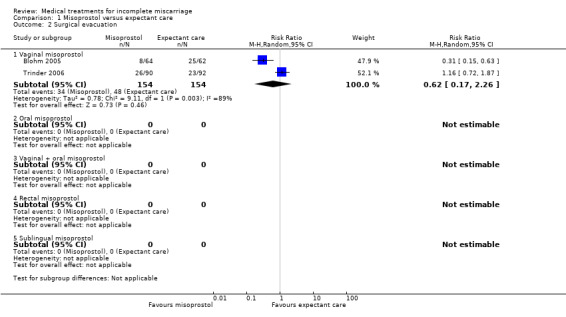
Comparison 1 Misoprostol versus expectant care, Outcome 2 Surgical evacuation.
Death or serious complication
The outcome of death or serious complication showed no difference either (RR 2.91, 95% CI 0.12 to 70.05; 1 study, 126 women) (Analysis 1.3), although the review is underpowered to assess this outcome.
1.3. Analysis.
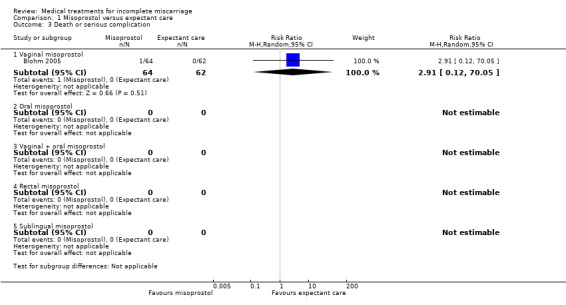
Comparison 1 Misoprostol versus expectant care, Outcome 3 Death or serious complication.
Secondary outcomes
Unplanned surgical intervention
We rated the quality of the evidence as low (Table 1), mainly due to high levels of heterogeneity and only one of the two studies being blinded. We did not identify a difference in unplanned surgical intervention between misoprostol and expectant care (average RR 0.62, 95% CI 0.17 to 2.26; 2 studies, 308 women, random‐effects (Tau² = 0.78; Chi² P = 0.003; I² = 89%)) (Analysis 1.4, low‐quality evidence).
1.4. Analysis.
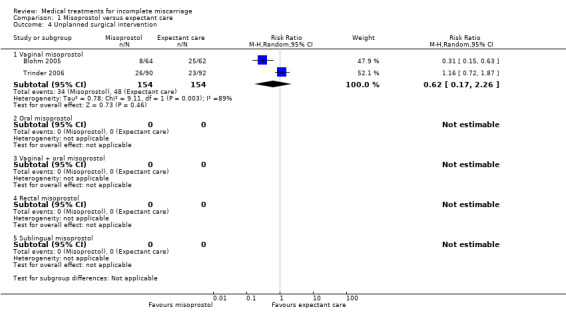
Comparison 1 Misoprostol versus expectant care, Outcome 4 Unplanned surgical intervention.
Blood transfusion
We did not identify a difference in the number of blood transfusions undertaken (RR 3.07, 95% CI 0.13 to 74.28; 3 studies, 332 women), although only one study was estimable (Analysis 1.5).
1.5. Analysis.
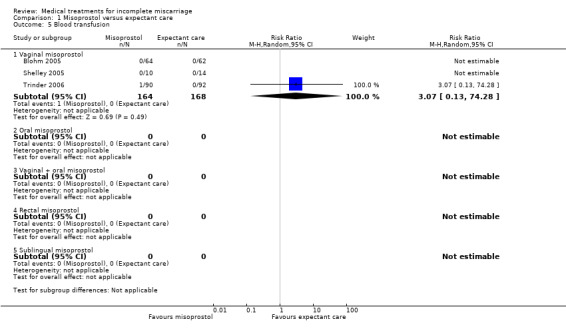
Comparison 1 Misoprostol versus expectant care, Outcome 5 Blood transfusion.
Haemorrhage
There was no information reported on haemorrhage.
Blood loss
There was no information reported on blood loss.
Anaemia
There was no information reported on anaemia.
Days of bleeding
There was no information reported on days of bleeding.
Pain relief
We did not identify a difference in pain relief (average RR 1.12, 95% CI 0.67 to 1.88; 2 studies, 308 women, random‐effects (Tau² = 0.10; Chi² P = 0.08; I² = 67%)) (Analysis 1.6).
1.6. Analysis.
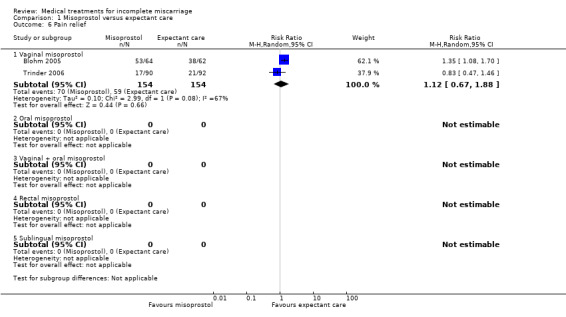
Comparison 1 Misoprostol versus expectant care, Outcome 6 Pain relief.
Pelvic infection
We did not identify a difference in pelvic infection (average RR 2.42, 95% CI 0.59 to 9.98; 3 studies, 333 women, random‐effects (Tau² = 0.00; Chi² P = 0.43, I² = 0%)) (Analysis 1.7).
1.7. Analysis.
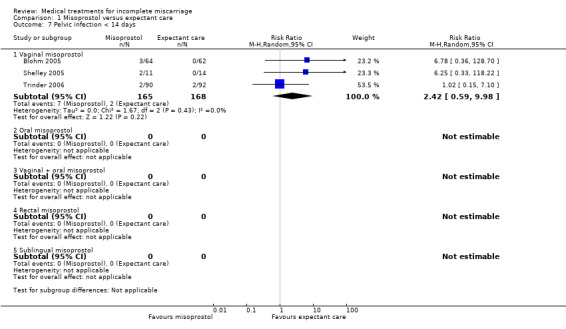
Comparison 1 Misoprostol versus expectant care, Outcome 7 Pelvic infection < 14 days.
Cervical damage
There was no information reported on cervical damage.
Digestive disorders (including nausea, vomiting, diarrhoea)
There was no information reported on digestive disorders.
Hypertensive disorders
There was no information reported on hypertensive disorders.
Duration of stay in hospital
There was no information reported on duration of stay in the hospital.
Psychological effects
There was no information reported on psychological effects.
Subsequent fertility
There was no information reported on subsequent fertility.
Women's views/acceptability of method
There was no information reported on women's views.
Pathology of fetal/placental tissue
There was no information reported on pathology of fetal/placental tissue.
Costs
There was no information reported on costs.
2. Misoprostol versus surgery (16 studies, 4044 women, Analyses 2.1 to 2.17)
For women less than 13 weeks' gestation
Sixteen studies involving 4044 women addressed this comparison for women with incomplete miscarriage at less than 13 weeks' gestation (Bique 2007; Chigbu 2012; Dabash 2010; Dao 2007; Ganguly 2010; Montesinos 2011; Moodliar 2005; Patua 2013; Sahin 2001; Shelley 2005; Shochet 2012; Shwekerela 2007; Taylor 2011; Trinder 2006; Weeks 2005; Zhang 2005). One of these studies was a comparison of misoprostol versus surgery versus expectant management (Trinder 2006), and therefore the comparison is described in the appropriate sections (here and the prior Section 1. Misoprostol versus expectant management).
The included studies were of low risk of bias overall (Figure 1), with most having adequate sequence generation and concealment allocation, although for Sahin 2001 and Shochet 2012, it was unclear. Blinding was not possible in any of the studies when comparing medical treatment with surgery. Only two studies had incomplete data and both related to the study being undertaken in rural settings where women in the community did not return for follow‐up checks (Montesinos 2011; Weeks 2005). We were unclear about the possibility of selective reporting bias as we did not assess any of the study protocols. Six of the 12 studies appeared to be free of other biases (Dabash 2010; Dao 2007; Montesinos 2011; Shelley 2005; Shwekerela 2007; Taylor 2011).
Diagnosis of incomplete miscarriage and assessment of complete miscarriage after treatment was made using clinical judgement in five studies (Bique 2007; Chigbu 2012; Shelley 2005; Shwekerela 2007; Weeks 2005), using ultrasound in eight studies (Dabash 2010; Dao 2007; Ganguly 2010; Montesinos 2011; Moodliar 2005; Patua 2013; Sahin 2001; Zhang 2005), and other studies sometimes used ultrasound. Assessment of the outcome of complete miscarriage was made at differing times in the studies: one study assessed 24 hours after the last dose of misoprostol or the surgical evacuation (Patua 2013), 11 studies assessed at one week (Bique 2007; Chigbu 2012; Dabash 2010; Dao 2007; Ganguly 2010; Montesinos 2011; Shochet 2012; Shwekerela 2007; Taylor 2011; Weeks 2005; Zhang 2005), and three studies assessed around 10 to 14 days (Moodliar 2005; Sahin 2001; Shelley 2005). Trinder 2006 assessed at eight weeks and so we have not included these data (there was an assessment at two weeks in this study, but the findings were not reported separately for women with incomplete miscarriage and women with intrauterine fetal death). We have written to the authors to seek these data.
We have chosen to use random‐effects meta‐analyses for all the outcomes in this comparison as we believe there is clinical heterogeneity as we will be potentially pooling differing routes of administration (vaginal, oral, vaginal + oral, rectal, and sublingual). Although there are currently only data from studies using vaginal misoprostol, we believe other studies will be undertaken in the future and will be added to future updates of this review. We have assessed the individual routes of administration of misoprostol for effectiveness compared with surgery below in Comparisons 7 to 11.
Primary outcomes
Complete miscarriage
We rated the quality of the evidence as very low (Table 2), mainly due to high heterogeneity, the trials being inevitably unblinded, and suspicion of publication bias. There appeared to be fewer complete miscarriages with misoprostol compared with surgery (average RR 0.96, 95% CI 0.94 to 0.98, 15 studies; 3862 women, random‐effects (Tau² = 0.00; Chi² P < 0.00001, I² = 73%)) (Analysis 2.1), although the upper CI was at 0.98. The funnel plot suggests there could be some missing studies or that there is a lack of smaller studies demonstrating a RR greater than one, so the findings need to be interpreted with caution (Figure 2). However, from the clinical perspective, the success rate was very good for both misoprostol and surgery. Misoprostol achieving between 80% and 99% success across studies, and surgery achieving between 91% and 100% success across studies. The interaction test identified no difference between the subgroups of differing routes of misoprostol administration compared with surgery for this outcome (interaction test (IT) P = 0.08, I² = 56.1%) (Analysis 2.1).
2.1. Analysis.
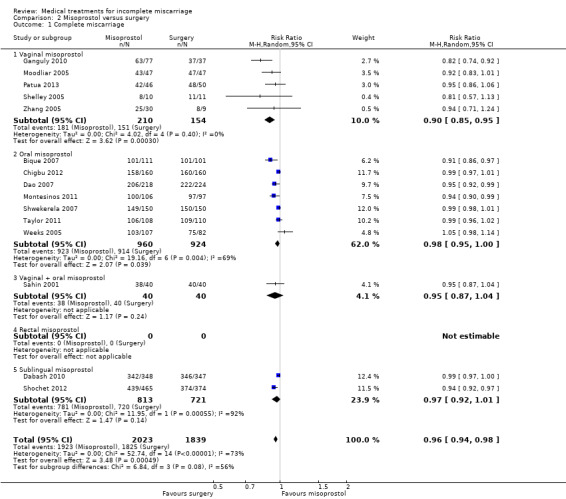
Comparison 2 Misoprostol versus surgery, Outcome 1 Complete miscarriage.
2.
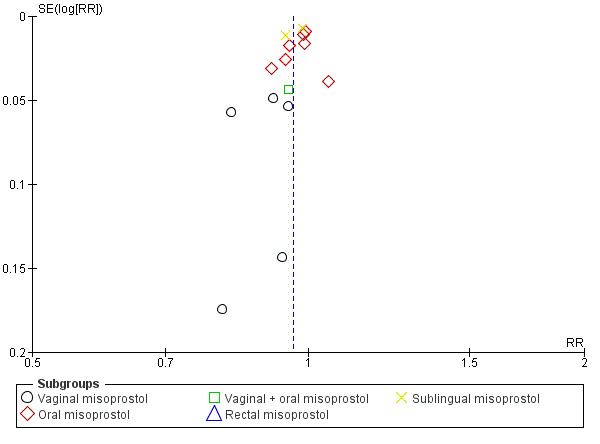
Funnel plot of comparison: 2 Misoprostol versus surgery, outcome: 2.1 Complete miscarriage.
Surgical evacuation
We rated the quality of the evidence as very low (Table 2), due to high heterogeneity, the trials being inevitably unblinded, and the possibility of publication bias. There were fewer surgical evacuations with misoprostol (average RR 0.05, 95% CI 0.02 to 0.11; 13 studies, 3070 women, random‐effects (Tau² = 1.64; Chi² P < 0.00001; I² = 92%)) (Analysis 2.2). The funnel plot is asymmetrical, suggesting that smaller studies of lower methodological quality are showing an exaggerated effect size (Figure 3). The interaction test suggested there may be differences between the subgroups of differing routes of misoprostol administration compared with surgery for this outcome (IT P = 0.002, I² = 79.8%) (Analysis 2.2). However, many of the subgroups have little or no data, and when comparing just the two main subgroups (oral misoprostol and vaginal misoprostol), there is no longer any subgroup difference.
2.2. Analysis.
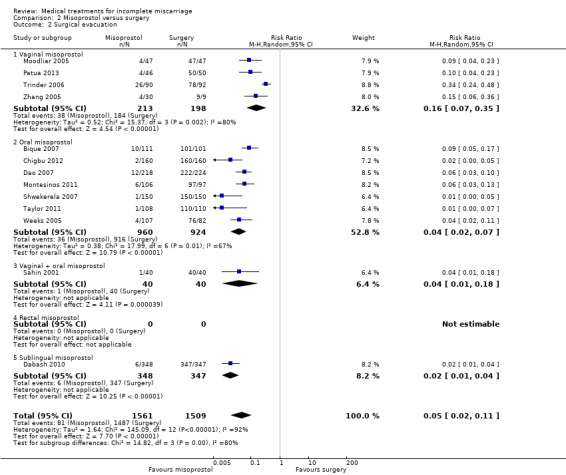
Comparison 2 Misoprostol versus surgery, Outcome 2 Surgical evacuation.
3.
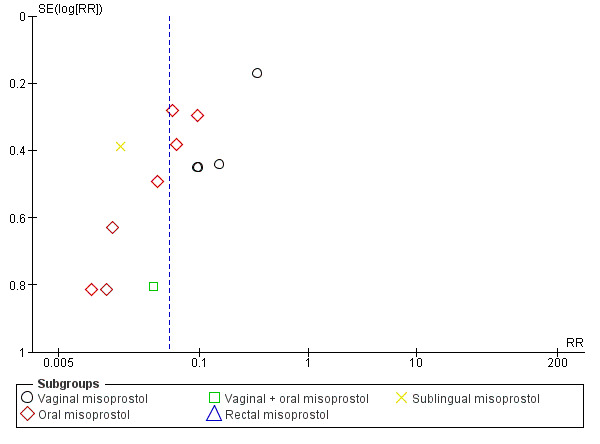
Funnel plot of comparison: 2 Misoprostol versus surgery, outcome: 2.2 Surgical evacuation.
Death or serious complication
We did not identify any difference between misoprostol and surgery (RR 1.00, 95% CI 0.04 to 22.64; 5 studies, 1248 women), but only one study was estimable, and the review is underpowered to assess this outcome (Analysis 2.3).
2.3. Analysis.
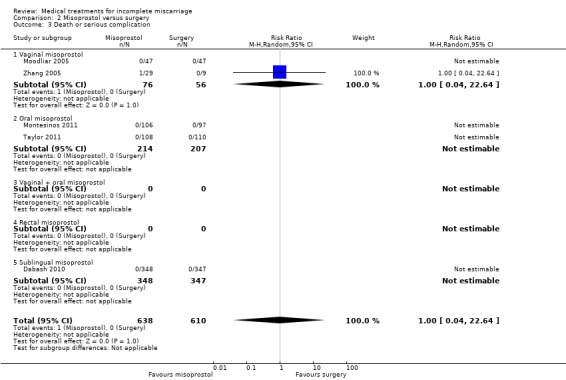
Comparison 2 Misoprostol versus surgery, Outcome 3 Death or serious complication.
Secondary outcomes
Unplanned surgical intervention
We rated the quality of the evidence as low (Table 2), due to the trials being inevitably unblinded and the potential of publication bias. There was more unplanned surgery with misoprostol (average RR 5.03, 95% CI 2.71 to 9.35; 11 studies, 2690 women, random‐effects (Tau² = 0.00; P = 0.62; Tau², I² = 0%)) (Analysis 2.4). The funnel plot displays a potential bias in that there is variation of effect estimates regardless of the study size. This leads to a consideration that there is something affecting the outcome that is not being measured, which is a form of reporting bias (Figure 4).
2.4. Analysis.
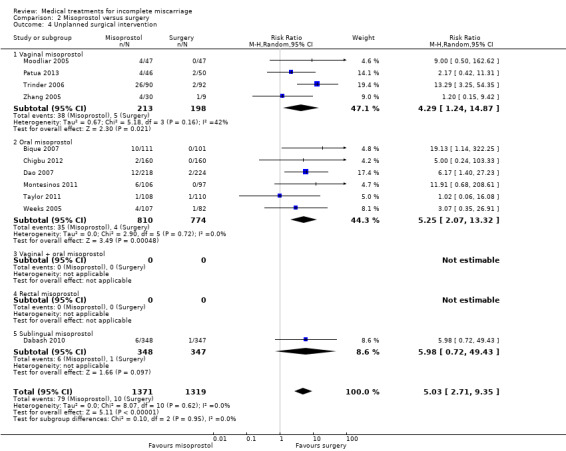
Comparison 2 Misoprostol versus surgery, Outcome 4 Unplanned surgical intervention.
4.
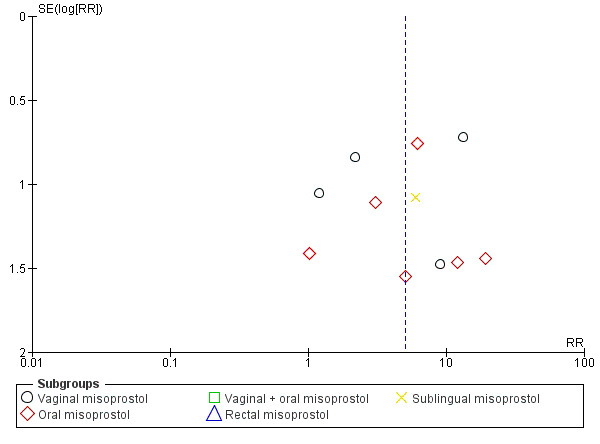
Funnel plot of comparison: 2 Misoprostol versus surgery, outcome: 2.4 Unplanned surgical intervention.
Blood transfusion
We did not identify any difference for the number of blood transfusions undertaken between misoprostol and surgery (average RR 1.73, 95% CI 0.19 to 16.08; 4 studies, 430 women (Tau² = 0.00; Chi² P = 0.62; I² = 0%)) (Analysis 2.5).
2.5. Analysis.
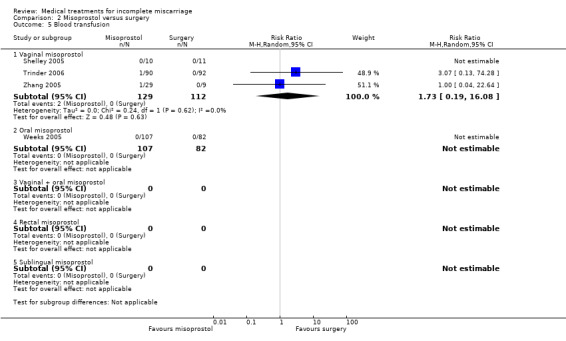
Comparison 2 Misoprostol versus surgery, Outcome 5 Blood transfusion.
Haemorrhage
There was no information reported on haemorrhage.
Blood loss
There was no information reported on blood loss.
Anaemia
Tau²
We did not identify any difference in anaemia (average RR 0.83, 95% CI 0.17 to 4.12; 2 studies, 731 women, random‐effects (Tau² = 0.18; P = 0.28; I² = 14%)) (Analysis 2.7).
2.7. Analysis.
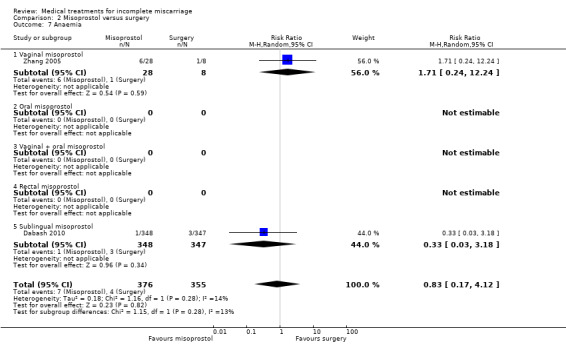
Comparison 2 Misoprostol versus surgery, Outcome 7 Anaemia.
Days of bleeding
There were more days of bleeding with misoprostol than with surgery (average mean difference (MD) 2.12, 95% CI 1.18 to 3.07; 3 studies, 211 women, random‐effects (Tau² = 0.19; Chi² P = 0.26; I² = 25%)) (Analysis 2.8). This difference was also considered clinically significant.
2.8. Analysis.
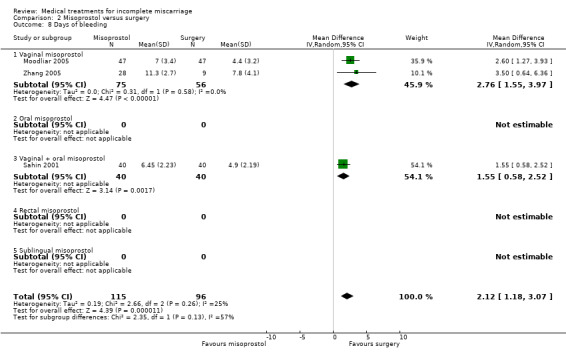
Comparison 2 Misoprostol versus surgery, Outcome 8 Days of bleeding.
Pain relief
We did not identify a difference with the use of pain relief between women who had misoprostol and women who had surgery (average RR 1.48, 95% CI 0.67 to 3.25; 4 studies, 525 women, random‐effects (Tau² = 0.50; Chi² P < 0.00001; I² = 90%)) (Analysis 2.9).
2.9. Analysis.
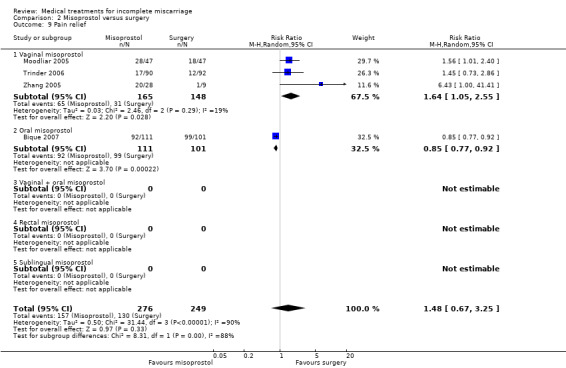
Comparison 2 Misoprostol versus surgery, Outcome 9 Pain relief.
Pelvic infection
We did not identify a difference in the incidence of pelvic infection between women who had misoprostol and those who had surgery (average RR 0.70, 95% CI 0.25 to 1.99; 7 studies, 907 women, random‐effects (Tau² = 0.00; Chi² P = 0.60; I² = 0%)) (Analysis 2.10).
2.10. Analysis.
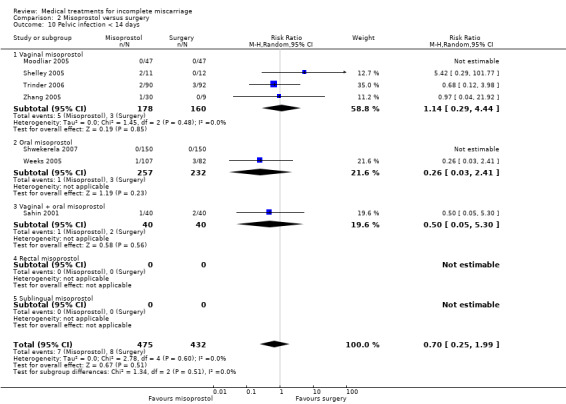
Comparison 2 Misoprostol versus surgery, Outcome 10 Pelvic infection < 14 days.
Cervical damage
We did not identify a difference in cervical damage, although only one study assessed this outcome (RR 0.07, 95% CI 0.00 to 1.25; 1 study, 189 women) (Analysis 2.11).
2.11. Analysis.
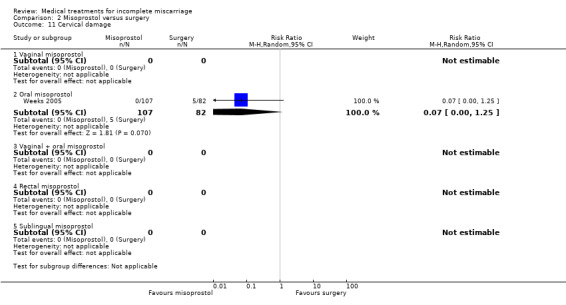
Comparison 2 Misoprostol versus surgery, Outcome 11 Cervical damage.
Digestive disorders (including nausea, vomiting, diarrhoea)
We rated the quality of the evidence for vomiting and diarrhoea as moderate (Table 2), due to the trials being inevitably unblinded. We rated the quality of the evidence for nausea specifically, as low due to trials being inevitably unblinded and high heterogeneity.
More women had nausea with misoprostol compared with surgery (average RR 2.50, 95% CI 1.53 to 4.09; 11 studies, 3015 women, random‐effects (Tau² = 0.31 Chi² P = 0.005; I² = 60%)) (Analysis 2.15, low‐quality evidence). This is likely to be clinically significant. The funnel plot does not show existence of a publication bias (Figure 5).
2.15. Analysis.
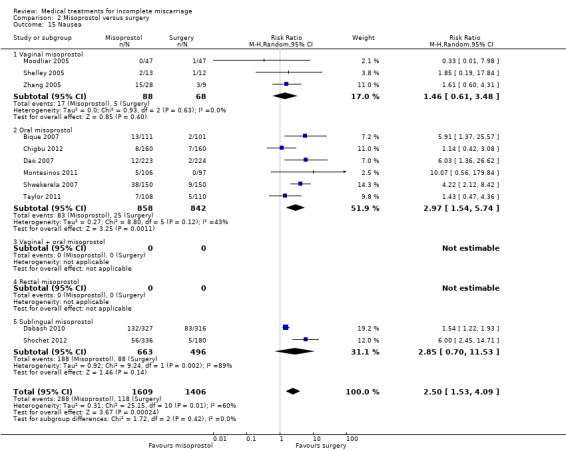
Comparison 2 Misoprostol versus surgery, Outcome 15 Nausea.
5.
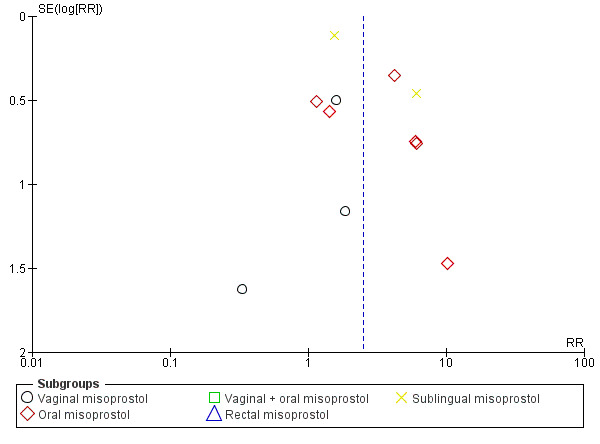
Funnel plot of comparison: 2 Misoprostol versus surgery, outcome: 2.15 Nausea.
More women had vomiting with misoprostol compared with surgery (average RR 1.97, 95% CI 1.36 to 2.85; 10 studies, 2977 women, random‐effects (Tau² = 0.00; Chi² P = 0.48; I² = 0%)) (Analysis 2.16, moderate‐quality evidence). This may be less clinically significant than the nausea. The funnel plot does not show existence of a publication bias (Figure 6).
2.16. Analysis.
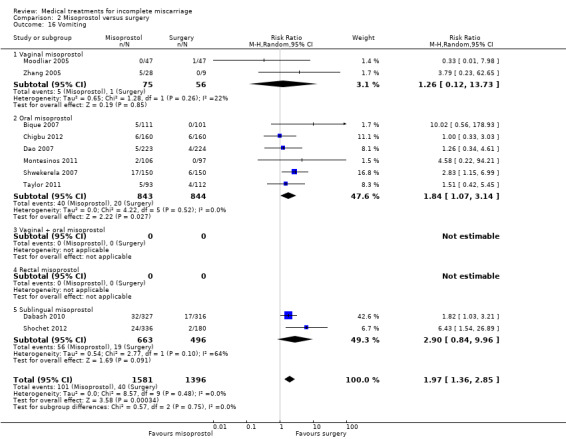
Comparison 2 Misoprostol versus surgery, Outcome 16 Vomiting.
6.
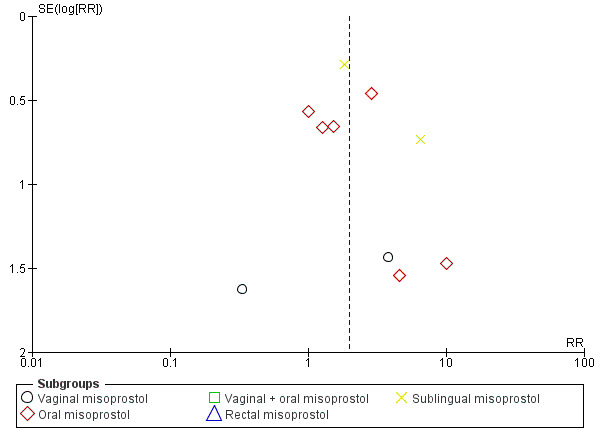
Funnel plot of comparison: 2 Misoprostol versus surgery, outcome: 2.16 Vomiting.
More women had diarrhoea with misoprostol compared with surgery (average RR 4.82, 95% CI 1.09 to 21.32; 4 studies, 757 women, random‐effects (Tau² = 0.00; Chi² P = 0.98; I² = 0%)) (Analysis 2.17, moderate‐quality evidence).
2.17. Analysis.
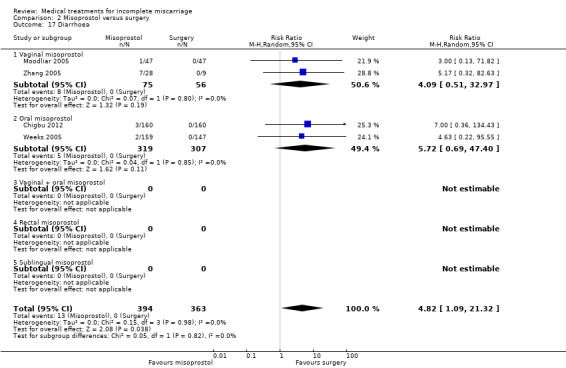
Comparison 2 Misoprostol versus surgery, Outcome 17 Diarrhoea.
Hypertensive disorders
There was no information reported on hypertensive disorders.
Duration of stay in hospital
There was no information reported on duration of stay in the hospital.
Psychological effects
There was no information reported on psychological effects.
Subsequent fertility
There was no information reported on subsequent fertility.
Women's views/acceptability of method
We rated the quality of the evidence as moderate (Table 2), due to the trials being inevitably unblinded.
We did not identify a difference in women's satisfaction between misoprostol and surgery when expressed by whether they were satisfied or not (average RR 1.00, 95% CI 0.99 to 1.00; 9 studies, 3349 women, random‐effects (Tau² = 0.00; Chi² P = 0.64; I² = 0%)) (Analysis 2.13). Women were very satisfied overall, and satisfaction with misoprostol ranged from 91% to 99% across studies, and satisfaction with surgery ranged from 95% to 100%.
2.13. Analysis.
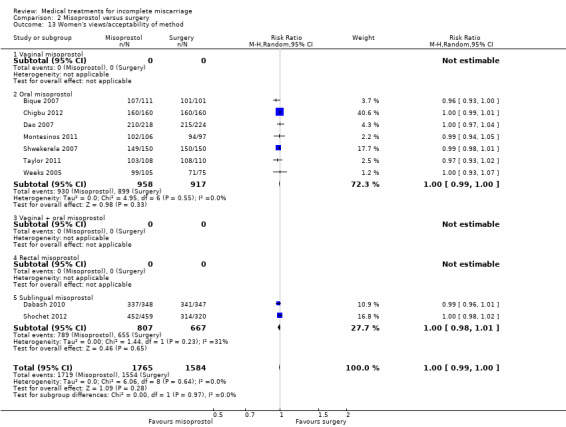
Comparison 2 Misoprostol versus surgery, Outcome 13 Women's views/acceptability of method.
When assessed using visual analogue scales, there were more women satisfied with surgery (average standardised mean difference (SMD) 1.01, 95% CI 0.01 to 2.00; 2 studies, 131 women, random‐effects (Tau² = 0.41; Chi² P = 0.03; I² = 78%)), but the difference was small and probably not clinically significant (Analysis 2.14). Taken with the findings above, it appears that overall most women are satisfied with the treatment they received.
2.14. Analysis.
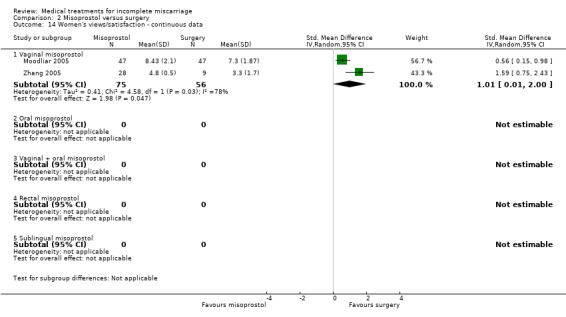
Comparison 2 Misoprostol versus surgery, Outcome 14 Women's views/satisfaction ‐ continuous data.
Pathology of fetal/placental tissue
There was no information reported on pathology of fetal/placental tissue.
Costs
There was no information reported on costs.
3. Vaginal misoprostol versus expectant care (3 studies, 335 women, Analyses 3.1 to 3.7)
For women less than 13 weeks' gestation
Three studies involving 335 women addressed this comparison for women with incomplete miscarriage (Blohm 2005; Shelley 2005; Trinder 2006). There were two further studies that involved both women with incomplete miscarriage and women with intrauterine fetal deaths, but to date we have been unable to obtain the data separated by incomplete miscarriage and intrauterine fetal death for these studies (Bagratee 2004; Ngai 2001).
The studies are of low risk of bias overall. However, blinding of participants and clinicians was only used in one (Blohm 2005), and not the other two studies (Shelley 2005; Trinder 2006).
Diagnosis of incomplete miscarriage and assessment of complete miscarriage after treatment was made using clinical judgement in two studies (Shelley 2005; Trinder 2006), and using ultrasound in the third (Blohm 2005). Assessment of the outcome of complete miscarriage was made at differing times in the three studies: Blohm 2005 assessed at one week, Shelley 2005 at 10 to 14 days, and Trinder 2006 at eight weeks (although there was an assessment at two weeks, findings were not reported separately for women with incomplete miscarriage and women with intrauterine fetal death). We have written to the authors to see if they have earlier data for incomplete miscarriage.
Primary outcomes
Complete miscarriage
Only two of the three studies assessed this outcome (Blohm 2005; Shelley 2005), with the primary outcome for the third study being infection at 14 days (Trinder 2006).
We did not identify a difference in complete miscarriage between vaginal misoprostol and expectant care (average RR 1.23, 95% CI 0.72 to 2.10; 2 studies, 150 women, random‐effects (Tau² = 0.12; Chi² P = 0.02; I² = 81%)) (Analysis 3.1). From the clinical perspective, the success rate with vaginal misoprostol ranged from 80% to 81% and for expectant care from 52% to 85%. The heterogeneity may result from the different times at which complete miscarriage was assessed with expectant care. One study assessed at one week and found a success rate of 52% (Blohm 2005), and the other study assessed at 10 to 14 days and found a success rate of 85% (Shelley 2005).
3.1. Analysis.
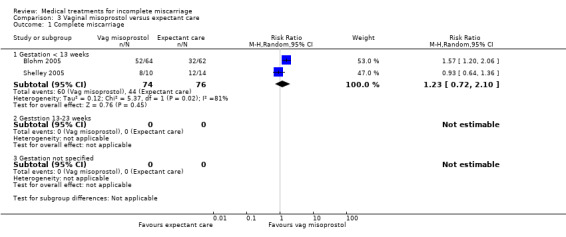
Comparison 3 Vaginal misoprostol versus expectant care, Outcome 1 Complete miscarriage.
Surgical evacuation
We also did not identify a difference in the need for surgical evacuation between vaginal misoprostol and expectant care (average RR 0.62, 95% CI 0.17 to 2.26; 2 studies, 308 women, random‐effects (Tau² = 0.78; Chi² P = 0.003; I² = 89%)) (Analysis 3.2).
3.2. Analysis.
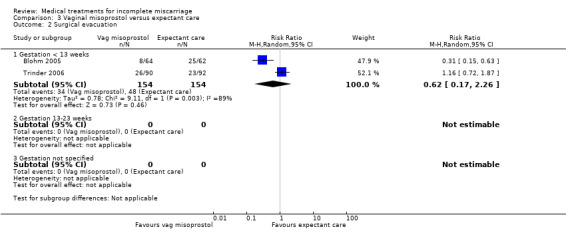
Comparison 3 Vaginal misoprostol versus expectant care, Outcome 2 Surgical evacuation.
Death or serious complication
The outcome of death or serious complication showed no difference (RR 2.91, 95% CI 0.12 to 70.05; 1 study, 126 women), although the review is underpowered to assess this outcome (Analysis 3.3).
3.3. Analysis.
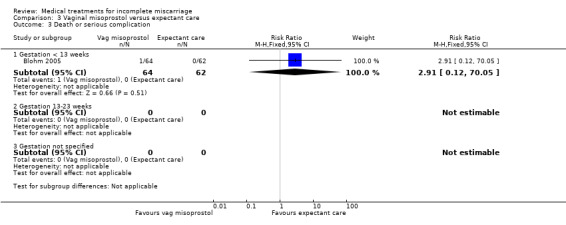
Comparison 3 Vaginal misoprostol versus expectant care, Outcome 3 Death or serious complication.
Secondary outcomes
Unplanned surgical intervention
We did not identify a difference in unplanned surgical interventions between vaginal misoprostol and expectant care (average RR 0.62, 95% CI 0.17 to 2.26; 2 studies, 308 women, random‐effects (Tau² = 0.78; Chi² P = 0.003; I² = 89%)) (Analysis 3.4).
3.4. Analysis.
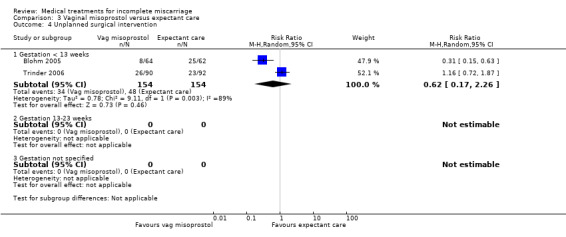
Comparison 3 Vaginal misoprostol versus expectant care, Outcome 4 Unplanned surgical intervention.
Blood transfusion
We did not identify a difference in the number of blood transfusions undertaken (RR 3.07, 95% CI 0.13 to 74.28; 3 studies, 332 women), although only one study was estimable (Analysis 3.5).
3.5. Analysis.
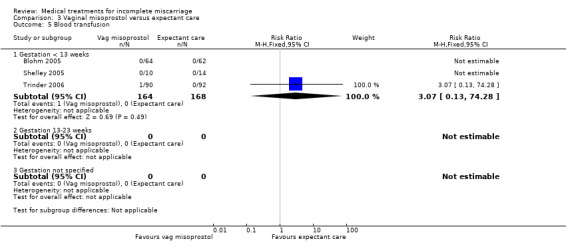
Comparison 3 Vaginal misoprostol versus expectant care, Outcome 5 Blood transfusion.
Haemorrhage
There was no information reported on haemorrhage.
Blood loss
There was no information reported on blood loss.
Anaemia
There was no information reported on anaemia.
Days of bleeding
There was no information reported on days of bleeding.
Pain relief
We did not identify a difference in pain relief (average RR 1.12, 95% CI 0.67 to 1.88; 2 studies, 308 women, random‐effects (Tau² = 0.10; Chi² P = 0.08; I² = 67%)) (Analysis 3.6).
3.6. Analysis.
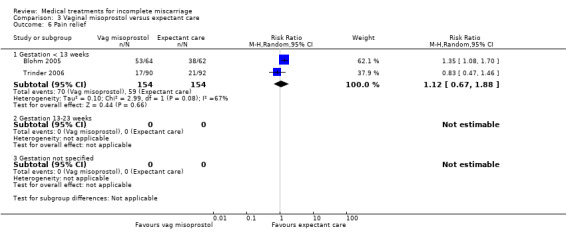
Comparison 3 Vaginal misoprostol versus expectant care, Outcome 6 Pain relief.
Pelvic infection
We did not identify a difference in pelvic infection (RR 2.81, 95% CI 0.77 to 10.33; 3 studies, 333 women) (Analysis 3.7).
3.7. Analysis.
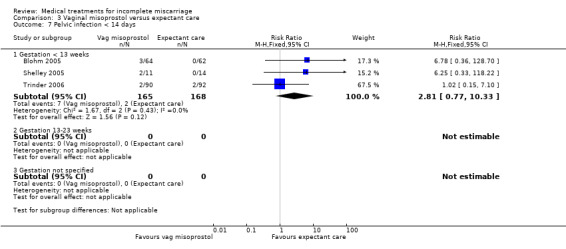
Comparison 3 Vaginal misoprostol versus expectant care, Outcome 7 Pelvic infection < 14 days.
Cervical damage
There was no information reported on cervical damage.
Digestive disorders (including nausea, vomiting, diarrhoea)
There was no information reported on digestive disorders.
Hypertensive disorders
There was no information reported on hypertensive disorders.
Duration of stay in hospital
There was no information reported on duration of stay in the hospital.
Psychological effects
There was no information reported on psychological effects.
Subsequent fertility
There was no information reported on subsequent fertility.
Women's views/acceptability of method
There was no information reported on women's views.
Pathology of fetal/placental tissue
There was no information reported on pathology of fetal/placental tissue.
Costs
There was no information reported on costs.
4. Vaginal misoprostol versus surgery (6 studies, 549 women, Analyses 4.1 to 4.13)
For women less than 13 weeks' gestation
Six studies involving 549 women addressed this comparison for women with incomplete miscarriage (Ganguly 2010; Moodliar 2005; Patua 2013; Shelley 2005; Trinder 2006;.Zhang 2005). Two further studies involved both women with incomplete miscarriage and women with intrauterine fetal deaths, but to date we have been unable to obtain the data separated by incomplete miscarriage and intrauterine fetal death for these studies, and so we have excluded these studies (Demetroulis 2001; Louey 2000 [pers comm]).
The studies were of low risk of bias overall (Figure 1). However, the nature of the intervention and comparison meant it was not possible to blind participants or clinicians, and it was mostly unclear whether the studies had selective reporting bias, or other biases.
Diagnosis of incomplete miscarriage and assessment of complete miscarriage after treatment was made using clinical judgement in two studies (Shelley 2005; Trinder 2006), and using ultrasound in four studies (Ganguly 2010; Moodliar 2005; Patua 2013; Zhang 2005). Assessment of the outcome of complete miscarriage was made at differing times in the studies: Patua 2013 assessed 24 hours after the last dose of misoprostol or surgical evacuation; Ganguly 2010 assessed at day 3 and day 8 for misoprostol, and day 2 and day 8 for surgical evacuation; Zhang 2005 assessed at three days; Shelley 2005 at 10 to 14 days; Moodliar 2005 at two weeks; and Trinder 2006 at eight weeks (although there was an assessment at two weeks, findings were not reported separately for women with incomplete miscarriage and women with intrauterine fetal death). We have written to the authors to seek these data.
Primary outcomes
Complete miscarriage
Fewer women had complete miscarriage with vaginal misoprostol compared with surgery (RR 0.89, 95% CI 0.84 to 0.95; 5 studies, 364 women) (Analysis 4.1). However, from the clinical perspective the success rate was high in both groups, vaginal misoprostol ranged from 80% to 91% and for surgery from 89% to 100%.
4.1. Analysis.
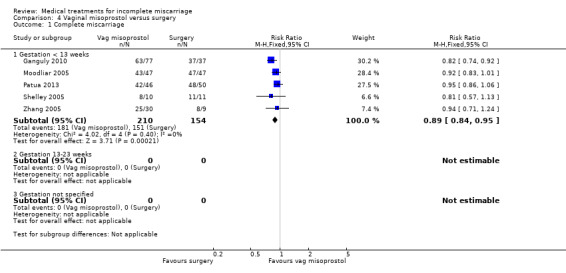
Comparison 4 Vaginal misoprostol versus surgery, Outcome 1 Complete miscarriage.
Surgical evacuation
Fewer women had surgical evacuation with vaginal misoprostol compared with women who were given surgery straight away (average RR 0.16, 95% CI 0.07 to 0.35; 4 studies, 411 women, random‐effects (Tau² = 0.52; Chi² P = 0.002; I² = 80%)) (Analysis 4.2). This finding was perhaps not surprising as the comparison group was surgical intervention, but it is an important outcome to assess as clinical management would be to use surgery if misoprostol failed. This reduction in the use of surgery with vaginal misoprostol helps to confirm the success of this intervention. The reasons for the heterogeneity were unclear.
4.2. Analysis.
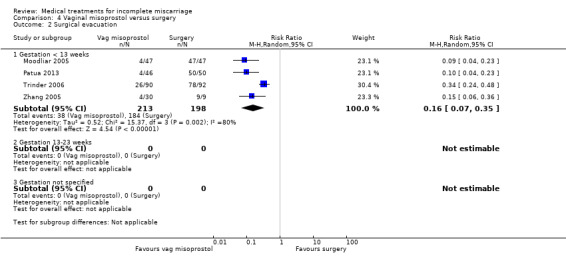
Comparison 4 Vaginal misoprostol versus surgery, Outcome 2 Surgical evacuation.
Death or serious complication
We did not identify a difference in the composite outcome of death or serious complications (RR 1.00, 95% CI 0.04 to 22.64; 2 studies, 132 women, (although only one was estimable); however, the review is underpowered to assess this outcome (Analysis 4.3).
4.3. Analysis.
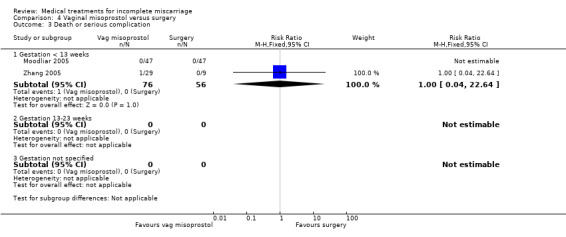
Comparison 4 Vaginal misoprostol versus surgery, Outcome 3 Death or serious complication.
Secondary outcomes
Unplanned surgical intervention
In the vaginal misoprostol group, there was a higher incidence of unplanned surgical intervention (average RR 4.29, 95% CI 1.24 to 14.87; 4 studies, 411 women (Tau² = 0.67; Chi² P = 0.16; I² = 42%)) (Analysis 4.4). Again, this finding is unsurprising, as surgery is the comparative intervention and one would anticipate that few additional operations would be required if surgery was successful.
4.4. Analysis.
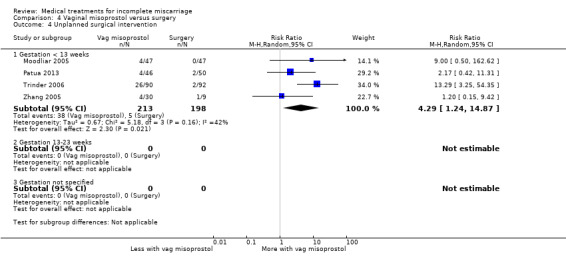
Comparison 4 Vaginal misoprostol versus surgery, Outcome 4 Unplanned surgical intervention.
Blood transfusion
We did not identify a difference in the number of blood transfusions undertaken (RR 1.82, 95% CI 0.21 to 15.70; 3 studies, 241 women) (Analysis 4.5).
4.5. Analysis.
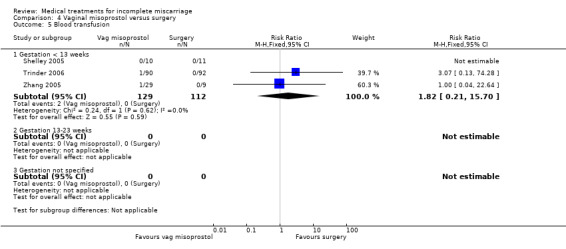
Comparison 4 Vaginal misoprostol versus surgery, Outcome 5 Blood transfusion.
Haemorrhage
There was no information reported on haemorrhage.
Blood loss
There was no information reported on blood loss.
Anaemia
We did not identify a difference in anaemia (RR 1.71, 95% CI 0.24 to 12.24; 1 study, 36 women) (Analysis 4.6).
4.6. Analysis.
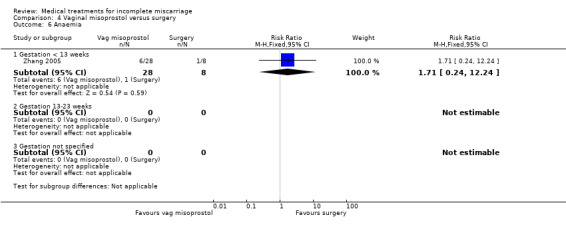
Comparison 4 Vaginal misoprostol versus surgery, Outcome 6 Anaemia.
Days of bleeding
Women treated with vaginal misoprostol had more days of bleeding than women treated with surgery (MD 2.76, 95% CI 1.55 to 3.97; 2 studies, 131 women) (Analysis 4.7).
4.7. Analysis.
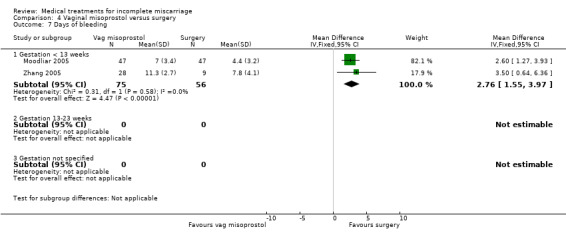
Comparison 4 Vaginal misoprostol versus surgery, Outcome 7 Days of bleeding.
Pain relief
Women treated with vaginal misoprostol used more pain relief than women treated with surgery (RR 1.75, 95% CI 1.21 to 2.54; 3 studies, 313 women) (Analysis 4.8).
4.8. Analysis.
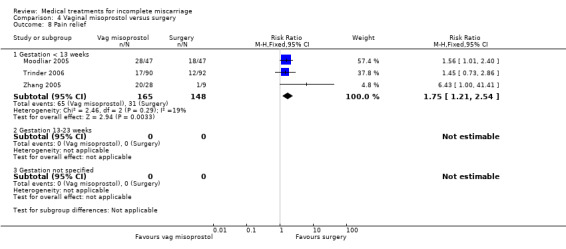
Comparison 4 Vaginal misoprostol versus surgery, Outcome 8 Pain relief.
Pelvic infection
We did not identify a difference in pelvic infection (RR 1.27, 95% CI 0.37 to 4.42; 4 studies, 338 women) (Analysis 4.9).
4.9. Analysis.
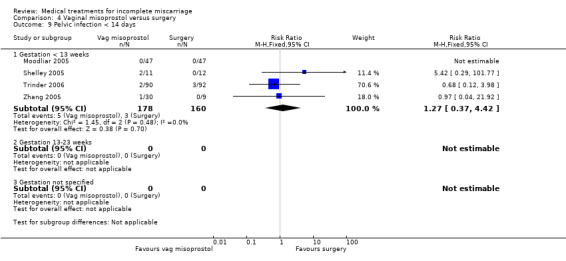
Comparison 4 Vaginal misoprostol versus surgery, Outcome 9 Pelvic infection < 14 days.
Cervical damage
There was no information reported on cervical damage.
Digestive disorders (including nausea, vomiting, diarrhoea)
We did not identify a difference in the number of women with nausea (RR 1.37, 95% CI 0.58 to 3.22; 3 studies, 156 women) (Analysis 7.24), vomiting (RR 1.48, 95% CI 0.25 to 8.93; 2 studies, 131 women) (Analysis 7.25), or diarrhoea (RR 4.30, 95% CI 0.52 to 35.36; 2 studies, 131 women) (Analysis 7.26).
Hypertensive disorders
There was no information reported on hypertensive disorders.
Duration of stay in hospital
There was no information reported on duration of stay in the hospital.
Psychological effects
There was no information reported on psychological effects.
Subsequent fertility
There was no information reported on subsequent fertility.
Women's views/acceptability of method
Women were more satisfied with surgery (average SMD 1.01, 95% CI 0.01 to 2.00; 2 studies, 131 women, random‐effects (Tau² = 0.41; Chi² P = 0.03; I² = 78%)), but the difference was small and based on just two small studies (Analysis 4.10). Reasons for the heterogeneity were unclear.
4.10. Analysis.
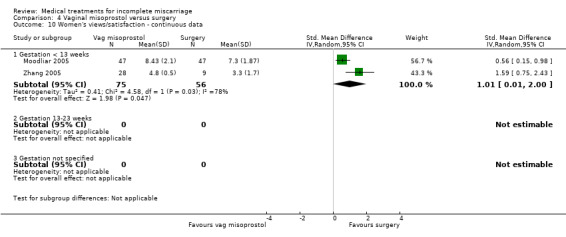
Comparison 4 Vaginal misoprostol versus surgery, Outcome 10 Women's views/satisfaction ‐ continuous data.
Pathology of fetal/placental tissue
There was no information reported on pathology of fetal/placental tissue.
Costs
There was no information reported on costs.
5. Oral misoprostol versus surgery (7 studies, 1884 women, Analyses 5.1 to 5.11)
For women less than 13 weeks' gestation
Seven studies involving 1884 women addressed this comparison for women with incomplete miscarriage (Bique 2007; Chigbu 2012; Dao 2007; Montesinos 2011; Shwekerela 2007; Taylor 2011; Weeks 2005). We identified a further study involving both women with incomplete miscarriage and women with intrauterine fetal deaths, but the authors, although they were able to supply additional data, were unable to separate outcomes by women with incomplete miscarriage and women with intrauterine death and so we excluded this study (Chung 1999).
The included studies were of low risk of bias overall (Figure 1), with all having adequate sequence generation and concealment allocation. Blinding was not possible when comparing medical treatment with surgery. Four of the studies had little loss to follow‐up and exclusions after randomisation (Bique 2007; Chigbu 2012; Dao 2007; Shwekerela 2007). However, one study, although it had no loss to follow‐up at six days, had considerable loss to follow‐up at one to two weeks (33% in the misoprostol group and 45% in the group having surgery) which was not similar between the groups (Weeks 2005). This seemed to arise from women returning home to their communities and not coming back for follow‐up appointments, and this was fully discussed by the authors (Weeks 2005). Sensitivity analysis was not undertaken because outcomes at six days did not appear to be subject to bias.
Diagnosis of incomplete miscarriage and assessment of complete miscarriage after treatment was made using clinical judgement in four studies (Bique 2007; Chigbu 2012; Shwekerela 2007; Weeks 2005), and using ultrasound, if necessary, in three studies (Dao 2007; Montesinos 2011; Taylor 2011). Assessment of the outcome of complete miscarriage was made at seven days in all seven studies (Bique 2007; Chigbu 2012; Dao 2007; Montesinos 2011; Shwekerela 2007; Taylor 2011; Weeks 2005).
Primary outcomes
Complete miscarriage
There was no difference identified in the number of complete miscarriages with oral misoprostol compared with surgery (average RR 0.98, 95% CI 0.95 to 1.00; 7 studies, 1884 women, random‐effects (Tau² = 0.00; Chi2 = 0.004; I2 = 69%)) (Analysis 5.1). In addition, in terms of clinical impact, the success rate was high in both groups, for oral misoprostol it ranged from 91% to 99% and surgery ranged from 91% to 100%.
5.1. Analysis.
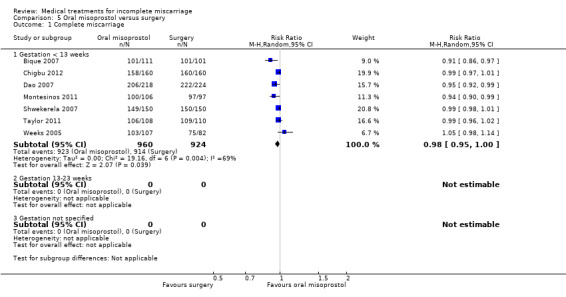
Comparison 5 Oral misoprostol versus surgery, Outcome 1 Complete miscarriage.
Surgical evacuation
Fewer women had surgical evacuation with oral misoprostol (average RR 0.04, 95% CI 0.02 to 0.07; 7 studies, 1884 women, random‐effects (Tau² = 0.38. Chi² P = 0.006; I² = 67%)) (Analysis 5.2). The reasons for the heterogeneity were unclear.
5.2. Analysis.
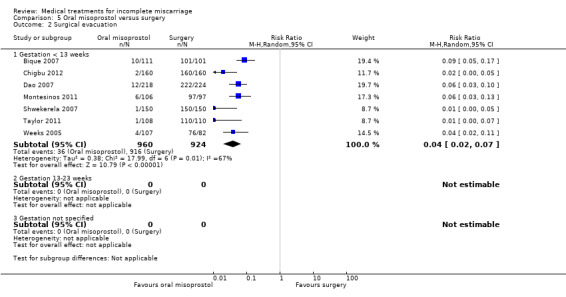
Comparison 5 Oral misoprostol versus surgery, Outcome 2 Surgical evacuation.
Death or serious complication
There were no data for this outcome.
Secondary outcomes
Unplanned surgical intervention
There were more women needing unplanned surgical intervention in the oral misoprostol group (RR 6.27, 95% CI 2.57 to 15.31; 6 studies, 1584 women) (Analysis 5.3).
5.3. Analysis.
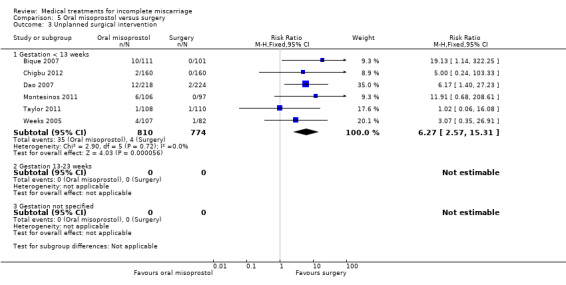
Comparison 5 Oral misoprostol versus surgery, Outcome 3 Unplanned surgical intervention.
Blood transfusion
It was not possible to produce a RR with the data (Analysis 5.4).
5.4. Analysis.
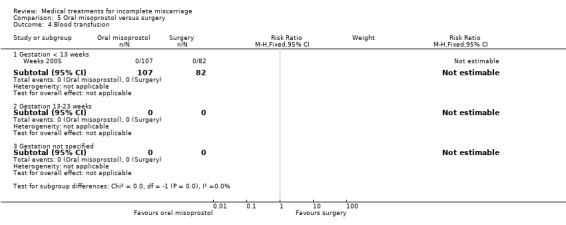
Comparison 5 Oral misoprostol versus surgery, Outcome 4 Blood transfusion.
Haemorrhage
There was no information reported on haemorrhage.
Blood loss
There was no information reported on blood loss.
Anaemia
There was no information reported on anaemia.
Days of bleeding
There was no information reported on days of bleeding.
Pain relief
There was less pain relief required with oral misoprostol than with surgery (RR 0.85, 95% CI 0.77 to 0.92; 1 study, 212 women), but the difference was small and most women used pain relief whether they had misoprostol or surgery (Analysis 5.5).
5.5. Analysis.
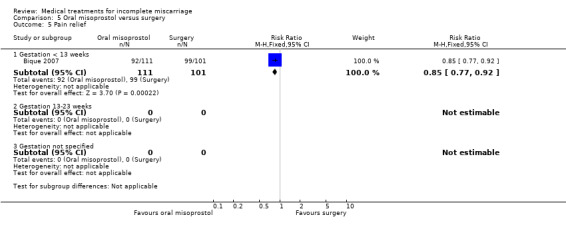
Comparison 5 Oral misoprostol versus surgery, Outcome 5 Pain relief.
Pelvic infection
We did not identify a difference in pelvic infection (RR 0.26, 95% CI 0.03 to 2.41; 2 studies, 489 women) (Analysis 5.6).
5.6. Analysis.
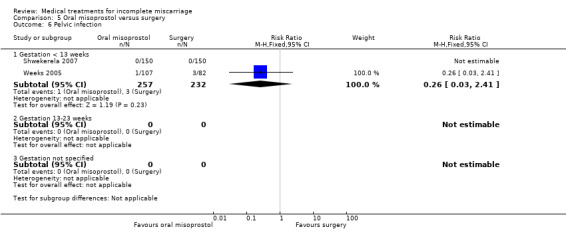
Comparison 5 Oral misoprostol versus surgery, Outcome 6 Pelvic infection.
Cervical damage
We did not identify a difference in cervical damage (RR 0.07, 95% CI 0.00 to 1.25; 1 study, 189 women) (Analysis 5.7).
5.7. Analysis.
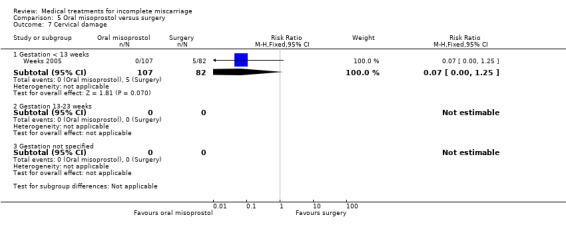
Comparison 5 Oral misoprostol versus surgery, Outcome 7 Cervical damage.
Digestive disorders
More women experienced nausea (RR 3.24, 95% CI 2.10 to 4.98; 6 studies, 1700 women) (Analysis 5.9), and vomiting (RR 1.99, 95% CI 1.18 to 3.34; 6 studies, 1687 women) with oral misoprostol compared with surgery (Analysis 5.10), but we did not identify a difference in the incidence of diarrhoea (RR 5.79, 95% CI 0.70 to 47.64; 2 studies, 626 women) (Analysis 5.11).
5.9. Analysis.
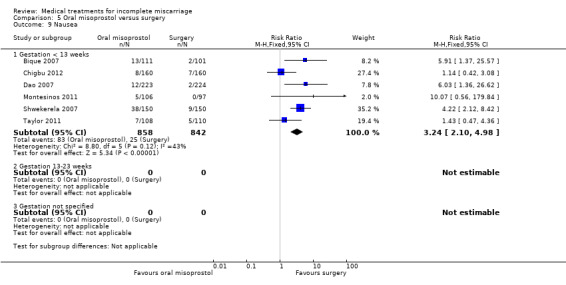
Comparison 5 Oral misoprostol versus surgery, Outcome 9 Nausea.
5.10. Analysis.
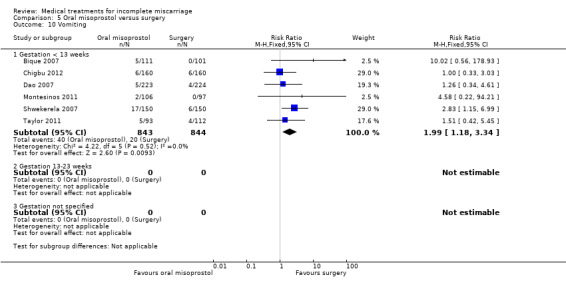
Comparison 5 Oral misoprostol versus surgery, Outcome 10 Vomiting.
5.11. Analysis.
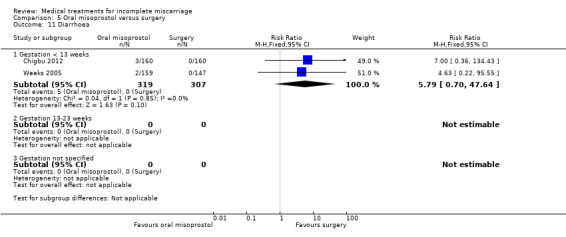
Comparison 5 Oral misoprostol versus surgery, Outcome 11 Diarrhoea.
Hypertensive disorders
There was no information reported on hypertensive disorders.
Duration of stay in hospital
There was no information reported on duration of stay in the hospital.
Psychological effects
There was no information reported on psychological effects.
Subsequent fertility
There was no information reported on subsequent fertility.
Women's views/acceptability of method
We did not identify a difference in women's satisfaction (RR 0.99, 95% CI 0.98 to 1.01; 7 studies, 1875 women) (Analysis 5.8).
5.8. Analysis.
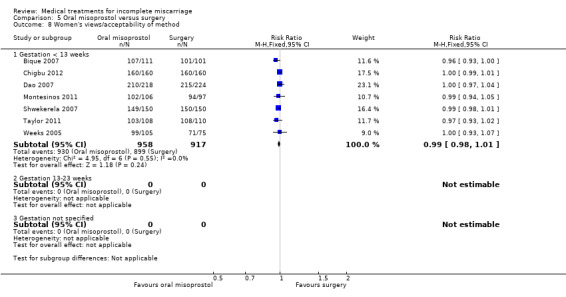
Comparison 5 Oral misoprostol versus surgery, Outcome 8 Women's views/acceptability of method.
Pathology of fetal/placental tissue
There was no information reported on pathology of fetal/placental tissue.
Costs
There was no information reported on costs.
6. Vaginal plus oral misoprostol versus surgery (1 study, 80 women, Analyses 6.1 to 6.4)
For women less than 13 weeks' gestation
One study involving 80 women assessed this comparison (Sahin 2001).
The study was at high risk of bias with uncertainty around sequence generation, allocation concealment, selective reporting bias, and other potential biases, and it was not possible to blind participants and clinicians.
Assessment of incomplete miscarriage was undertaken using ultrasound and assessment of outcomes was undertaken at 10 days.
Primary outcomes
Complete miscarriage
There was no difference identified in incomplete miscarriage (RR 0.95, 95% CI 0.87 to 1.04; 1 study, 80 women) (Analysis 6.1). In clinical terms, the success in this one study was 95% with medical treatment and 100% with surgery.
6.1. Analysis.
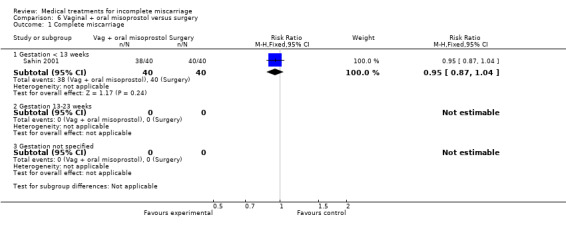
Comparison 6 Vaginal + oral misoprostol versus surgery, Outcome 1 Complete miscarriage.
Surgical evacuation
There was less need for surgical evacuation with misoprostol than with surgery (RR 0.04, 95% CI 0.01 to 0.18; 1 study, 80 women) (Analysis 6.2).
6.2. Analysis.
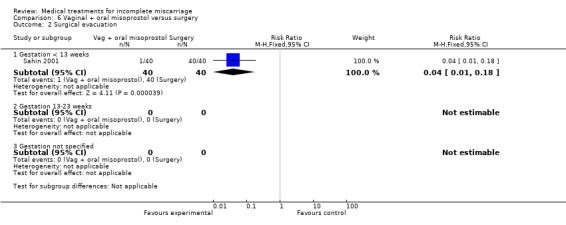
Comparison 6 Vaginal + oral misoprostol versus surgery, Outcome 2 Surgical evacuation.
Death or serious complication
Not reported.
Secondary outcomes
Unplanned surgical intervention
There was no information reported on unplanned surgical intervention.
Blood transfusion
There was no information reported on blood transfusion.
Haemorrhage
There was no information reported on haemorrhage.
Blood loss
There was no information reported on blood loss.
Anaemia
There was no information reported on anaemia.
Days of bleeding
There were fewer days of bleeding with surgery compared with vaginal plus oral misoprostol (MD 1.55, 95% CI 0.58 to 2.52; 1 study, 80 women) (Analysis 6.3).
6.3. Analysis.
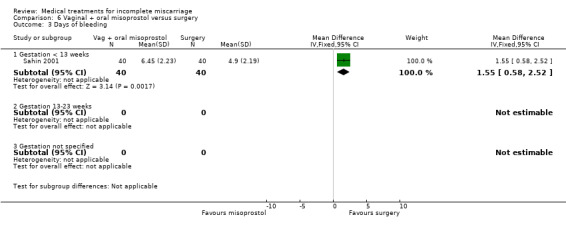
Comparison 6 Vaginal + oral misoprostol versus surgery, Outcome 3 Days of bleeding.
Pain relief
There was no information reported on pain relief.
Pelvic infection
We did not identify a difference in pelvic infection (RR 0.50, 95% CI 0.05 to 5.30; 1 study, 80 women) (Analysis 6.4).
6.4. Analysis.
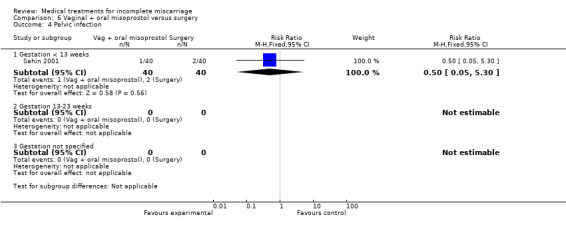
Comparison 6 Vaginal + oral misoprostol versus surgery, Outcome 4 Pelvic infection.
Cervical damage
There was no information reported on cervical damage.
Digestive disorders (including nausea, vomiting, diarrhoea)
There was no information reported on digestive disorders.
Hypertensive disorders
There was no information reported on hypertensive disorders.
Duration of stay in hospital
There was no information reported on duration of stay in the hospital.
Psychological effects
There was no information reported on psychological effects.
Subsequent fertility
There was no information reported on subsequent fertility.
Women's views/acceptability of method
There was no information reported on women's views.
Pathology of fetal/placental tissue
There was no information reported on pathology of fetal/placental tissue.
Costs
There was no information reported on costs.
7. Sublingual misoprostol versus surgery (2 studies, 1534 women, Analyses 7.1 to 7.8)
For women less than 13 weeks' gestation
Two studies involving 1534 women addressed this comparison for women with incomplete miscarriage (Dabash 2010; Shochet 2012).
Dabash 2010 was of low risk of bias overall (Figure 1), having adequate sequence generation and concealment allocation. Blinding was not possible when comparing medical treatment with surgery. However, for the second study (Shochet 2012), it was unclear how sequence generation and allocation concealment were conducted.
Diagnosis of incomplete miscarriage and assessment of complete miscarriage after treatment was made using clinical judgement and use of ultrasound, as needed, in both studies. Assessment of the outcome of complete miscarriage was made at one week follow‐up in both studies.
Primary outcomes
Complete miscarriage
There was no difference identified in the number of complete miscarriages (RR 0.96, 95% CI 0.95 to 0.98; 2 studies, 1534 women) (Analysis 7.1), with the success rate being 94% to 98% with sublingual misoprostol and 99% to 100% with surgery.
7.1. Analysis.
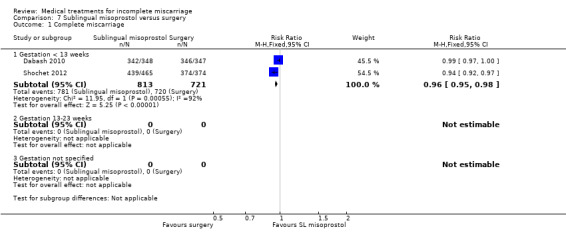
Comparison 7 Sublingual misoprostol versus surgery, Outcome 1 Complete miscarriage.
Surgical evacuation
There was less need for surgical evacuation with misoprostol than with surgery (RR 0.02, 95% CI 0.01 to 0.04; 1 study, 695 women) (Analysis 7.2).
7.2. Analysis.
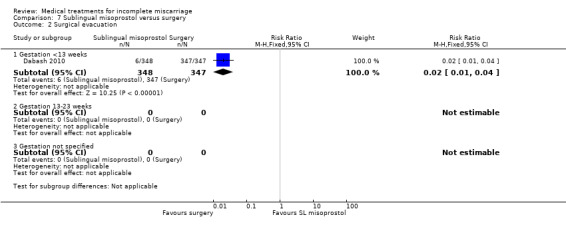
Comparison 7 Sublingual misoprostol versus surgery, Outcome 2 Surgical evacuation.
Death or serious complications
Not reported.
Secondary outcomes
Unplanned surgical intervention
In the sublingual misoprostol group, there was a higher incidence of unplanned surgical intervention (average RR 5.98, 95% CI 0.72 to 49.43; 1 study, 695 women) (Analysis 7.3). Again, this finding is unsurprising, as surgery is the comparative intervention and one would anticipate that few additional operations would be required if surgery was successful.
7.3. Analysis.
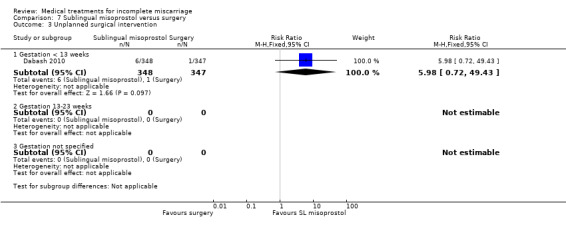
Comparison 7 Sublingual misoprostol versus surgery, Outcome 3 Unplanned surgical intervention.
Blood transfusion
There was no information reported on blood transfusion.
Haemorrhage
There was no information reported on haemorrhage.
Blood loss
There was no information reported on blood loss.
Anaemia
We did not identify a difference in anaemia (RR 0.33, 95% CI 0.03 to 3.18; 1 study, 695 women) (Analysis 7.4).
7.4. Analysis.
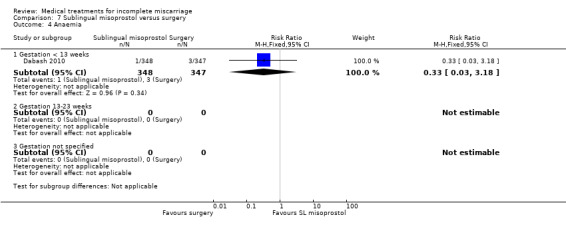
Comparison 7 Sublingual misoprostol versus surgery, Outcome 4 Anaemia.
Days of bleeding
There was no information reported on days of bleeding.
Pain relief
There was no information reported on pain relief.
Pelvic infection
There was no information reported on pelvic infection
Cerivcal damage
There was no information reported on cervical damage.
Digestive disorders
Women in the misoprostol group were more likely to experience gastrointestinal issues compared to the women in the surgery group (RR 3.90, 95%CI 1.81 to 8.42; 1 study, 516 women) (Analysis 7.5). More women experienced nausea in the misoprostol group (RR 1.86, 95% CI 1.48 to 2.32; 2 studies, 1159 women) (Analysis 7.7), and vomiting (RR 2.42, 95% CI 1.43 to 4.10; 2 studies, 1159 women) (Analysis 7.8).
7.5. Analysis.
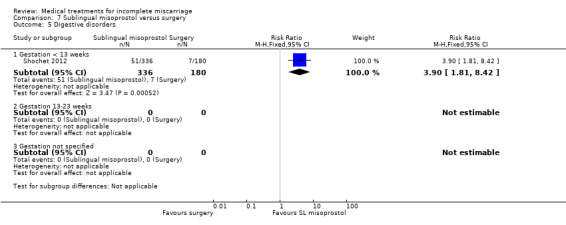
Comparison 7 Sublingual misoprostol versus surgery, Outcome 5 Digestive disorders.
7.7. Analysis.
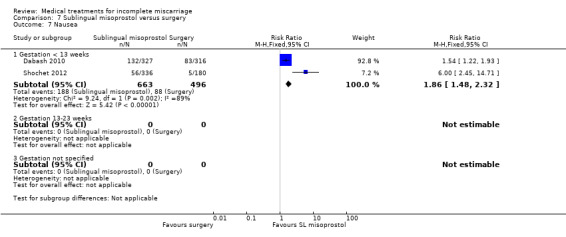
Comparison 7 Sublingual misoprostol versus surgery, Outcome 7 Nausea.
7.8. Analysis.
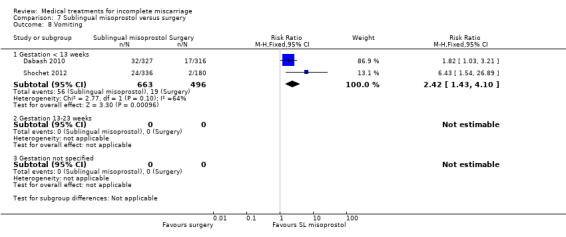
Comparison 7 Sublingual misoprostol versus surgery, Outcome 8 Vomiting.
Hypertensive disorders
There was no information reported on hypertensive disorders.
Duration of stay in hospital
There was no information reported on duration of stay in the hospital.
Psychological effects
There was no information reported on psychological effects.
Subsequent fertility
There was no information reported on subsequent fertility.
Women's views/acceptability of method
We did not identify a difference in women's satisfaction towards their method (RR 0.99, 95% CI 0.98 to 1.01; 2 studies, 1474 women) (Analysis 7.6).
7.6. Analysis.
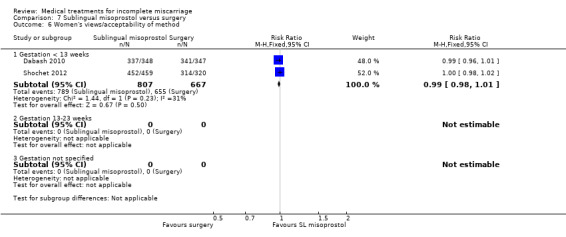
Comparison 7 Sublingual misoprostol versus surgery, Outcome 6 Women's views/acceptability of method.
Pathology of fetal/placental tissue
There was no information reported on pathology of fetal/placental tissue.
Costs
There was no information reported on costs.
8. Vaginal misoprostol versus oral misoprostol (1 study, 201 women, Analyses 8.1 to 8.7)
For women less than 13 weeks' gestation
One study involving 201 women addressed this comparison for women with incomplete miscarriage (Pang 2001). One further study involved both women with incomplete miscarriage and women with intrauterine fetal deaths, but to date we have been unable to obtain the data separated by incomplete miscarriage and intrauterine fetal death for this study, and so we have excluded it from this review (Machtinger 2004).
The risk of bias in Pang 2001 was at low risk in terms of having adequate sequence generation and concealment allocation, and appeared to be free of other potential sources of bias, however, it was not clear whether participants, clinicians and assessors were blinded to the intervention given (Figure 1).
Assessment of incomplete miscarriage was undertaken using ultrasound and assessment of outcomes was undertaken at one day after treatment.
Primary outcomes
Complete miscarriage
We did not identify a difference in the number of complete miscarriages (RR 0.94, 95% CI 0.76 to 1.16; 1 study, 198 women) (Analysis 8.1), with the success rate being 61% with vaginal misoprostol and 65% with oral misoprostol, both assessed on day one.
8.1. Analysis.
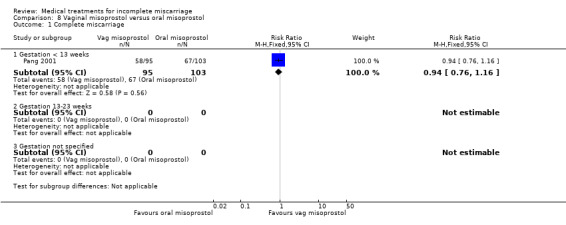
Comparison 8 Vaginal misoprostol versus oral misoprostol, Outcome 1 Complete miscarriage.
Surgical evacuation
We did not identify a difference in surgical evacuation (RR 1.11, 95% CI 0.77 to 1.60; 1 study, 198 women) (Analysis 8.2).
8.2. Analysis.
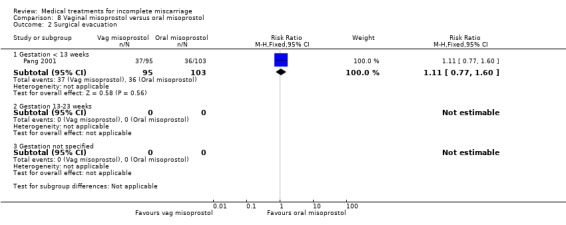
Comparison 8 Vaginal misoprostol versus oral misoprostol, Outcome 2 Surgical evacuation.
Death or serious complications
Not reported.
Secondary outcomes
Unplanned surgical intervention
We did not identify a difference in unplanned surgical intervention (RR 0.36, 95% CI 0.01 to 8.80; 1 study, 186 women) (Analysis 8.3).
8.3. Analysis.
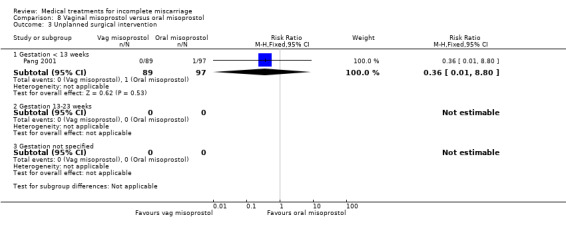
Comparison 8 Vaginal misoprostol versus oral misoprostol, Outcome 3 Unplanned surgical intervention.
Blood transfusion
There was no information reported on blood transfusion.
Haemorrhage
There was no information reported on haemorrhage.
Blood loss
There was no information reported on blood loss.
Anaemia
There was no information reported on anaemia.
Days of bleeding
There as no information reported on days of bleeding.
Pain relief
We did not identify a difference in pain relief (RR 1.43, 95% CI 0.93 to 2.17; 1 study, 186 women) (Analysis 8.4).
8.4. Analysis.
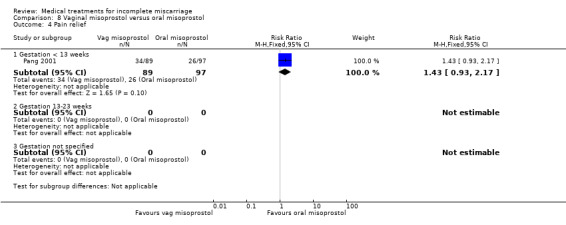
Comparison 8 Vaginal misoprostol versus oral misoprostol, Outcome 4 Pain relief.
Pelvic infection
There was no information reported on pelvic infection
Cerivcal damage
There was no information reported on cervical damage.
Digestive disorders
We did not identify any differences in the number of women experiencing nausea (RR 0.63, 95% CI 0.26 to 1.54; 1 study involving 198 women) (Analysis 8.5), and vomiting (RR 0.36, 95% CI 0.07 to 1.75; 1 study, 198 women) (Analysis 8.6).
8.5. Analysis.
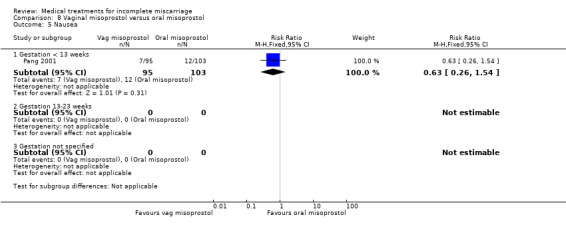
Comparison 8 Vaginal misoprostol versus oral misoprostol, Outcome 5 Nausea.
8.6. Analysis.
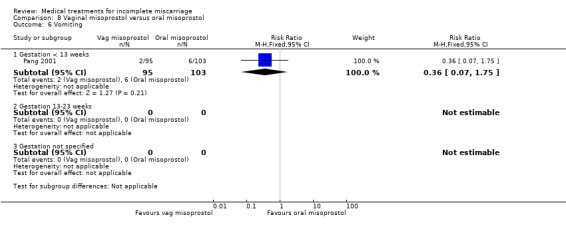
Comparison 8 Vaginal misoprostol versus oral misoprostol, Outcome 6 Vomiting.
There was a reduction in the incidence of diarrhoea for women using vaginal misoprostol compared with oral misoprostol (RR 0.21, 95% CI 0.12 to 0.36; 1 study, 198 women) (Analysis 8.7).
8.7. Analysis.
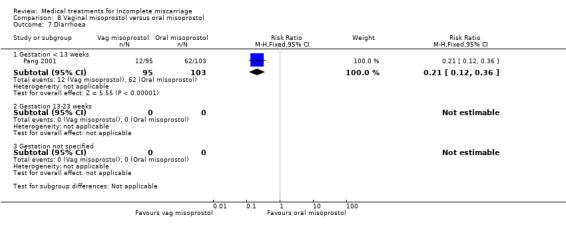
Comparison 8 Vaginal misoprostol versus oral misoprostol, Outcome 7 Diarrhoea.
Hypertensive disorders
There was no information reported on hypertensive disorders.
Duration of stay in hospital
There was no information reported on duration of stay in the hospital.
Psychological effects
There was no information reported on psychological effects.
Subsequent fertility
There was no information reported on subsequent fertility.
Women's views/acceptability of method
There was no information reported on women's views.
Pathology of fetal/placental tissue
There was no information reported on pathology of fetal/placental tissue.
Costs
There was no information reported on costs.
9. Oral misoprostol 600 ug versus oral misoprostol 1200 ug (2 studies, 469 women, Analyses 9.1 to 9.8)
For women less than 13 weeks' gestation
Two studies involving 469 women addressed this comparison for women with incomplete miscarriage (Blanchard 2004; Ngoc 2005).
Blanchard 2004 was on the whole at low risk of bias, with adequate sequence generation, concealment of allocation, low loss to follow‐up, and other sources of bias were not apparent. However, there was no blinding of participants, clinicians and assessors, and it was unclear whether there was selective reporting bias. Ngoc 2005 was similar, but it was unclear whether there was adequate allocation concealment (Figure 1).
Primary outcomes
Complete miscarriage
We did not identify a difference in complete miscarriage (RR 1.00, 95% CI 0.93 to 1.07; 2 studies, 464 women) (Analysis 9.1).
9.1. Analysis.
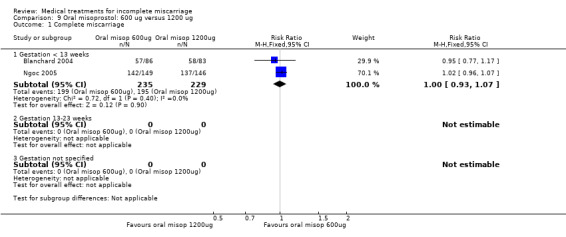
Comparison 9 Oral misoprostol: 600 ug versus 1200 ug, Outcome 1 Complete miscarriage.
Surgical evacuation
We did not identify a difference in surgical evacuation (RR 0.76, 95% CI 0.29 to 1.99; 1 study, 295 women) (Analysis 9.2). The success rate with the single 600 ug dose ranged from 66% to 95%, and the success rate with the repeat 600 ug dose (total 1200 ug) ranged from 67% to 94%.
9.2. Analysis.
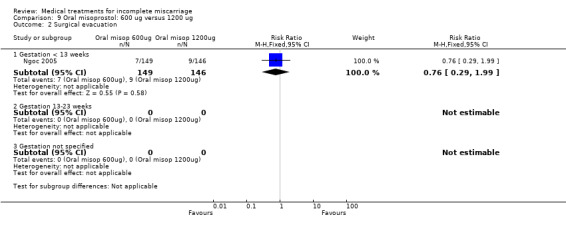
Comparison 9 Oral misoprostol: 600 ug versus 1200 ug, Outcome 2 Surgical evacuation.
Death or serious complication
One study provided data (Ngoc 2005), but it was not possible to produce a RR (Analysis 9.3).
9.3. Analysis.
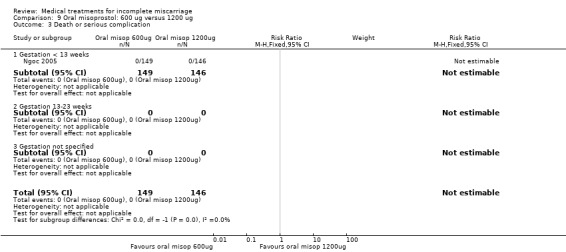
Comparison 9 Oral misoprostol: 600 ug versus 1200 ug, Outcome 3 Death or serious complication.
Secondary outcomes
Unplanned surgical intervention
We did not identify a difference in the number of unplanned surgical interventions (RR 0.76, 95% CI 0.29 to 1.99; 1 study, 295 women) (Analysis 9.4).
9.4. Analysis.
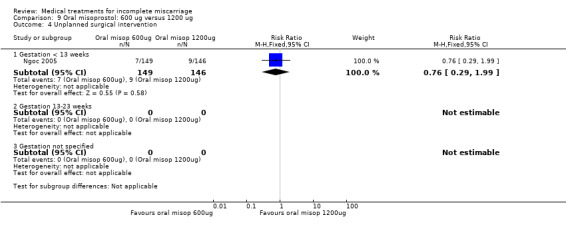
Comparison 9 Oral misoprostol: 600 ug versus 1200 ug, Outcome 4 Unplanned surgical intervention.
Blood transfusion
There was no information reported on blood transfusion.
Haemorrhage
There was no information reported on haemorrhage.
Blood loss
There was no information reported on blood loss.
Anaemia
There was no information reported on anaemia.
Days of bleeding
There was no information reported on days of bleeding.
Pain relief
There was no information reported on pain relief.
Pelvic infection
There was no information reported on pelvic infection.
Cervical damage
There was no information reported on cervical damage.
Digestive disorders
We did not identify a difference between the two doses of oral misoprostol for nausea (average RR 1.19, 95% CI 0.57 to 2.46; 2 studies, 463 women, random‐effects (Tau² = 0.19; Chi² P = 0.07; I² = 70%)) (Analysis 9.6), or vomiting (RR 1.01, 95% CI 0.60 to 1.72; 2 studies, 463 women) (Analysis 9.7).
9.6. Analysis.
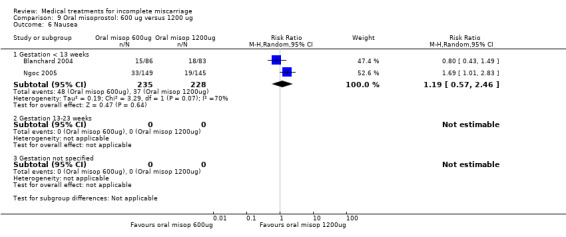
Comparison 9 Oral misoprostol: 600 ug versus 1200 ug, Outcome 6 Nausea.
9.7. Analysis.
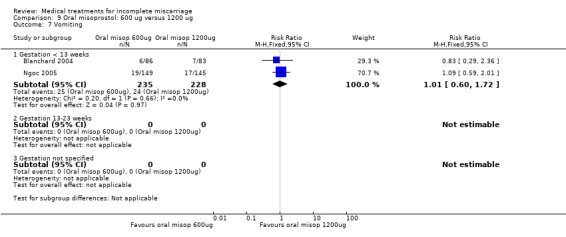
Comparison 9 Oral misoprostol: 600 ug versus 1200 ug, Outcome 7 Vomiting.
There was a reduction in the incidence of diarrhoea for women allocated to one dose of misoprostol (RR 0.73, 95% CI 0.55 to 0.97; 1 study, 294 women) (Analysis 9.8). The CI and the data being from one small study, makes the clinical significance unclear.
9.8. Analysis.
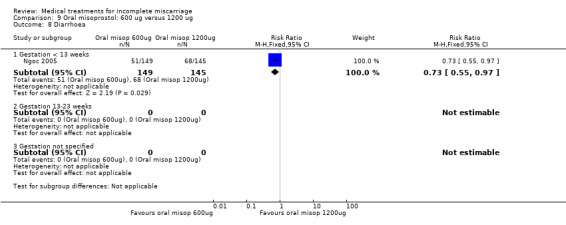
Comparison 9 Oral misoprostol: 600 ug versus 1200 ug, Outcome 8 Diarrhoea.
Hypertensive disorders
There was no information reported on hypertensive disorders.
Duration of stay in hospital
There was no information reported on duration of stay in the hospital.
Psychological effects
There was no information reported on psychological effects.
Subsequent fertility
There was no information reported on subsequent fertility.
Women's views/acceptability of method
We did not identify a difference in women's satisfaction (RR 1.02, 95% CI 0.96 to 1.09; 2 studies, 460 women) (Analysis 14.5).
Pathology of fetal/placental tissue
There was no information reported on pathology of fetal/placental tissue.
Costs
There was no information reported on costs.
10. Oral mifepristone + vaginal misoprostol versus surgery (1 study, 19 women, Analyses 10.1 to 10.2)
Niinimaki 2006 included women with many kinds of miscarriage (missed abortion, anembryonic pregnancies, incomplete miscarriage) but the authors were able to send us the data split by the types of miscarriage. The study also involved women at less than 24 weeks' gestation, some of whom were less than 13 weeks and some not.
For women less than 13 weeks' gestation
For the 16 women who were less than 13 weeks' gestation, treatments were equally successful with 10/10 (100%) women in the medical group and 6/6 (100%) women in the surgical group achieving complete miscarriage. There were no additional surgical evacuations required and none of the women had pelvic infections.
For women 13 to 23 weeks' gestation
For the three women who were between 13 and 24 weeks' gestation, treatments again were equally successful with 1/1 (100%) women in the medical group and 2/2 (100%) women in the surgical group achieving complete miscarriage. There were no additional surgical evacuations required and none of the women had pelvic infections.
11. Vaginal prostaglandin E1 (gemeprost) versus surgery (1 study, 34 women, Analyses 11.1)
For women less than 13 weeks' gestation
One study involving 34 women compared vaginal prostaglandin E1 (gemeprost) with surgery (Clevin 2001). The study was of uncertain risk of bias. It had adequate sequence generation and low risk of other potential sources of bias. However, the allocation concealment was unclear, as was the completeness of the outcome data and potential for selective reporting bias. It was not possible to blind participants and clinicians.
Primary outcomes
None of the prespecified primary outcomes were reported.
Secondary outcomes
Unplanned surgical intervention
Although data were reported on this outcome it was not possible to report a RR (Analysis 11.1).
11.1. Analysis.
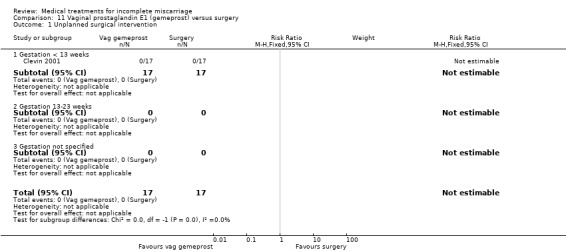
Comparison 11 Vaginal prostaglandin E1 (gemeprost) versus surgery, Outcome 1 Unplanned surgical intervention.
Blood transfusion
There was no information reported on blood transfusion.
Haemorrhage
There was no information reported on haemorrhage.
Blood loss
There was no information reported on blood loss.
Anaemia
There was no information reported on anaemia.
Days of bleeding
There was no information reported on days of bleeding.
Pain relief
There was no information reported on pain relief.
Pelvic infection
There was no information reported on pelvic infection.
Cervical damage
There was no information reported on cervical damage.
Digestive disorders
There was no information reported on digestive disorders.
Hypertensive disorders
There was no information reported on hypertensive disorders.
Duration of stay in hospital
There was no information reported on duration of stay in the hospital.
Psychological effects
There was no information reported on psychological effects.
Subsequent fertility
There was no information reported on subsequent fertility.
Women's views/acceptability of method
There was no information reported on women's views/acceptability of method.
Pathology of fetal/placental tissue
There was no information reported on pathology of fetal/placental tissue.
Costs
There was no information reported on costs.
12. Sublingual misoprostol versus oral misoprostol (2 studies, 358 women, Analyses 12.1 to 12.7)
For women less than 13 weeks' gestation
Two studies involving 358 women looked at this comparison (Diop 2009; Paritakul 2010). The studies were at low risk of bias with adequate sequence generation and allocation concealment. However, the studies were not blinded (Figure 1).
Primary outcomes
Complete miscarriage
We found no difference between sublingual and oral misoprostol in terms of complete miscarriage (RR 0.99, 95% CI 0.94 to 1.05; 2 studies, 358 women) (Analysis 12.1).
12.1. Analysis.
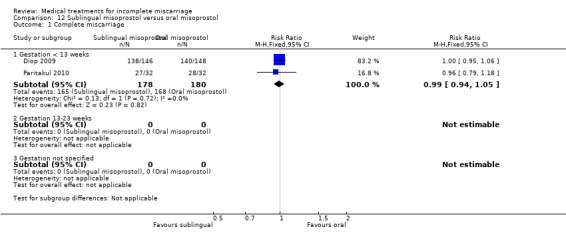
Comparison 12 Sublingual misoprostol versus oral misoprostol, Outcome 1 Complete miscarriage.
Surgical evacuation
There was also no difference in surgical evacuation between the two routes of administration of misoprostol (RR 1.01, 95% CI 0.39 to 2.63; 1 study, 294 women) (Analysis 12.2).
12.2. Analysis.
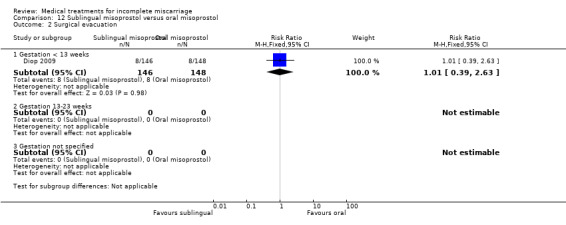
Comparison 12 Sublingual misoprostol versus oral misoprostol, Outcome 2 Surgical evacuation.
Death or serious morbidity
There were no deaths or serious morbidity amongst the women in these trials.
Secondary outcomes
Unplanned surgical intervention
There was no information reported on unplanned surgical intervention.
Blood transfusion
There was no information reported on blood transfusion.
Haemorrhage
There was no information reported on haemorrhage.
Blood loss
There was no information reported on blood loss.
Anaemia
There was no information reported on anaemia.
Days of bleeding
There was no information reported on days of bleeding.
Pain relief
There was no information reported on pain relief.
Pelvic infection
There was no information reported on pelvic infection.
Cervical damage
There was no information reported on cervical damage.
Digestive disorders
There was no difference in nausea between the two routes of administration of misoprostol (RR 0.78, 95% CI 0.49 to 1.23; 2 studies, 358 women) (Analysis 12.4)
12.4. Analysis.
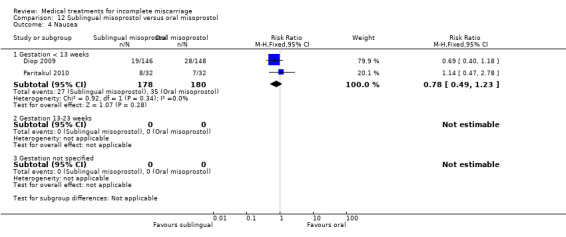
Comparison 12 Sublingual misoprostol versus oral misoprostol, Outcome 4 Nausea.
There was also no difference in vomiting between the two routes of administration of misoprostol (RR 1.01, 95% CI 0.14 to 7.10; 2 studies, 358 women) (Analysis 12.5)
12.5. Analysis.
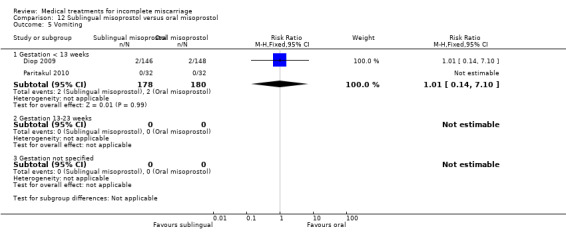
Comparison 12 Sublingual misoprostol versus oral misoprostol, Outcome 5 Vomiting.
There was also no difference in diaorrhea between the two routes of administration of misoprostol (RR 1.58, 95% CI 0.66 to 3.76; 2 studies, 358 women) (Analysis 12.6)
12.6. Analysis.
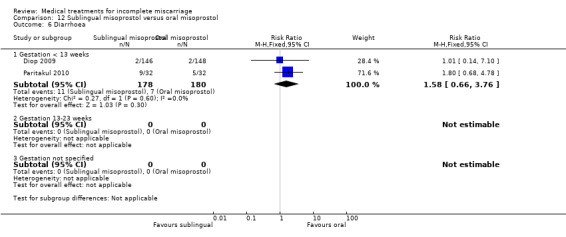
Comparison 12 Sublingual misoprostol versus oral misoprostol, Outcome 6 Diarrhoea.
Hypertensive disorders
There was no information reported on hypertensive disorders.
Duration of stay in hospital
There was no information reported on duration of stay in the hospital.
Psychological effects
There was no information reported on psychological effects.
Subsequent fertility
There was no information reported on subsequent fertility.
Women's views/acceptability of method
We did not identify a difference between the two routes of administration of misoprostol for this outcome. (RR 0.99, 95% CI 0.95 to 1.03; 2 studies, 358 women) (Analysis 12.7)
12.7. Analysis.

Comparison 12 Sublingual misoprostol versus oral misoprostol, Outcome 7 Women's views/acceptability of method.
Pathology of fetal/placental tissue
There was no information reported on pathology of fetal/placental tissue.
Costs
There was no information reported on costs.
Oral misoprostol versus expectant care (no studies)
There were no studies that addressed this comparison.
Rectal misoprostol versus expectant care (no studies)
There were no studies that addressed this comparison.
Sublingual misoprostol versus expectant care (no studies)
There were no studies that addressed this comparison.
Rectal misoprostol versus surgery (no studies)
There were no studies that addressed this comparison.
Rectal misoprostol versus oral misoprostol (no studies)
There were no studies that addressed this comparison.
Discussion
Virtually all the studies we identified involved women less than 13 weeks' pregnant; there was one study that included three women greater than 13 weeks' pregnant (Niinimaki 2006). Misoprostol was the drug studied most frequently and it was assessed against expectant care and surgery, and the possible routes of administration were vaginal, oral, vaginal plus oral, sublingual, and rectal.
Summary of main results
The limited data available for all these comparisons can be summarised as follows.
Misoprostol compared with expectant care (Comparison 1): we did not identify any differences between misoprostol and expectant care, although the review was underpowered to assess this comparison with only three studies involving 335 women. Vaginal misoprostol was the only route of administration used in these comparisons and further studies would be needed to be sure of the findings.
Misoprostol compared with surgery (Comparison 2): misoprostol appeared slightly less effective than surgery, but the difference was probably not clinically relevant, with the success rate for both treatments being high. There was a large reduction in surgery required when misoprostol was used. There was more blood loss with misoprostol, although cervical damage seemed less; however, this was assessed in only one study with possible risk of bias in losses to follow‐up. There was more nausea and vomiting with misoprostol (particularly oral misoprostol), but we did not identify a difference in women's satisfaction.
Vaginal misoprostol compared with expectant care (Comparison 3): we did not identify any differences between vaginal misoprostol compared with expectant care in terms of women achieving a complete miscarriage. However, in one study vaginal misoprostol was more effective than expectant care (Blohm 2005), and in the other study was equally effective (Shelley 2005). This difference seems to lie in the differing success in the expectant care group between the two studies. Complete miscarriage was 52% (32/64) in the study assessing this at one week (Blohm 2005), and 85% (12/14) in the study assessing it at two weeks (Shelley 2005). This is in contrast to the success rates with vaginal misoprostol which were 81% (52/64) and 80% (8/10), respectively. It may be, therefore, that if women are prepared to wait longer, then more might achieve spontaneous miscarriage without the use of vaginal misoprostol. However, the numbers of participants in both these studies was small. We did not identify any differences in the other outcomes assessed (surgical evacuation, death or serious complications, blood transfusions, pain relief, pelvic infection). There was no information about women's views of these two forms of care.
Vaginal misoprostol compared with surgery (Comparison 4): there was a small reduction in women achieving a complete miscarriage with vaginal misoprostol compared with surgery. However, vaginal misoprostol still showed a success rate of between 80% to 91%. There was a large reduction in the use of surgery and no difference in death or serious complications. The mean number of days of bleeding was higher with misoprostol and there was more need for pain relief. There was no difference in the other outcomes assessed (blood transfusion, anaemia, pelvic infection, nausea, vomiting, diarrhoea).
Oral misoprostol compared with surgery (Comparison 5): we did not identify a difference between oral misoprostol compared with surgery in terms of women achieving a complete miscarriage. There was a large reduction in the use of surgery, and deaths or serious complications were not reported. There was less pain relief needed with oral misoprostol, but increased nausea and vomiting. There were no difference in other outcomes assessed (pelvic infection, cervical damage, diarrhoea).
Vaginal plus oral misoprostol compared with surgery (Comparison 6): based on one study of 80 women, we did not identify any differences for complete miscarriage (success rates from 95% to 100%), days of bleeding and pelvic infection. There was a reduction in the use of surgery with medical management.
Sublingual misoprostol compared with surgery (Comparison 7): we did not identify a difference between sublingual misoprostol compared with surgery in terms of women achieving a complete miscarriage. There was a reduction in the use of surgery with medical management. There was increased nausea and vomiting with sublingual misoprostol.
Vaginal misoprostol compared with oral misoprostol (Comparison 8): we did not identify a difference between vaginal misoprostol compared with oral misoprostol in terms of women achieving a complete miscarriage or in the need for additional surgical intervention. The incidence of diarrhoea was less with vaginal misoprostol compared with the oral route, but there was no difference in other outcomes assessed (pain relief, nausea, vomiting).
600 ug oral misoprostol compared with 1200 ug oral misoprostol (Comparison 9): the only difference identified in this comparison was that more women experienced diarrhoea with the higher dose.
Sublingual misoprostol compared with oral misoprostol (Comparison 12): we did not identify a difference between the two groups.
Other comparisons: for other comparisons there were either no studies or the studies provided insufficient data.
Women's views: the only study that assessed women's views in any detail was a publication by Harwood 2008, as part of the study on vaginal misoprostol versus surgery (Zhang 2005). The 652 women in this multicentre randomised controlled trial were asked prospectively to complete a daily diary of any symptoms experienced for the two weeks after treatment. The women also completed questionnaires assessing quality of life, depression, stress, and treatment acceptability at two weeks after treatment. Although a few differences were observed in some of the individual measures, overall there was no difference in the mean scores for quality of life, although vaginal misoprostol was associated with higher levels of pain than surgery. Overall treatment acceptability was similar, and these findings can help to inform the focus of counselling for women choosing a treatment option.
Overall completeness and applicability of evidence
The review is probably underpowered to assess the effectiveness of medical treatments for incomplete miscarriage. In addition, nearly all studies were focused on women less than 13 weeks gestation and there is a need for more evidence on women more than 13 weeks gestation.
In terms of study settings, the evidence stems from both low‐income to high‐income countries. The majority of the studies took place in Africa and Southeast Asia while the remaining seven studies were in Europe and USA.
One study published by Smith 2009 but part of the MIST trial, undertook long‐term follow‐up to assess any potential impact on subsequent fertility (Trinder 2006). They concluded that the method of miscarriage management did not affect subsequent pregnancy rates with around four in five women giving birth within five years of the index miscarriage. Women can be reassured that long‐term fertility concerns need not affect their choice of miscarriage management.
Quality of the evidence
The risk of bias of studies was generally low, although it is hard to assess if there has been selective reporting bias.
We assessed the quality of evidence using GRADE for the two main comparisons (Atkins 2004): misoprostol versus expectant management and misoprostol versus surgery. The majority of the evidence was of low‐quality or very low‐quality. For the misoprostol versus expectant management, we assessed the outcome of 'complete miscarriage' as very low‐quality due to lack of blinding, heterogeneity of the studies, and the small sample size. Findings for the outcome of surgical evacuation were based on low‐quality evidence because of high risk of bias in one of the studies and high level of heterogeneity. For the misoprostol versus surgery comparison, the high risk of bias in some included studies, inconsistencies between results across studies, and suspected publication bias were the reasons for downgrading the quality of evidence for the complete miscarriage and surgical evacuation outcomes to very low. We assessed the quality of evidence for unplanned surgical intervention and nausea as low due to the high risk of bias and inconsistencies in the results. We assessed the quality of evidence for women's views, vomiting, and diarrhoea as moderate due to the lack of blinding.
Potential biases in the review process
We attempted to minimise bias by the following; two review authors assessed eligibility for inclusion and two review authors carried out data extraction and assessed risk of bias. Data entry into Review Manager 5 was undertaken by one review author and checked by another (RevMan 2014). However, many of these steps involve subjective assessments and thus may carry some risk of bias.
Agreements and disagreements with other studies or reviews
We are unaware of other reviews on this topic. Our conclusions seem to agree with most of those of the included studies that women can be offered a choice of treatments because differences are small and not of major consequence. Women may have particular preferences as to the adverse effects they wish to try to avoid and this is likely to influence their choice of treatment.
Authors' conclusions
Implications for practice.
Although it would be critical to have more data, the current evidence suggests there appears to be no major differences, other than avoiding surgery, between misoprostol, expectant care, and surgery in the treatment of incomplete miscarriage for women of less than 13 weeks' gestation. Avoiding surgery has considerable benefits in terms of reducing adverse effects (although these were not fully assessed systematically in the included studies) and is particularly beneficial in low‐income countries. We identified some differences in nausea, vomiting, and diarrhoea with the use of misoprostol which can be taken into account when counselling women on the treatment options.
Implications for research.
There is an urgent need for studies to assess medical interventions for incomplete miscarriage for women between 13 to 24 weeks' gestation, as currently there are no trials to guide practice. Multicentre trials would seem appropriate to give sufficient size to provide sound evidence.
There is a need for more trials comparing the use of medical treatments, by the various routes, with expectant care and surgery to confirm or refute these findings for women less than 13 weeks' gestation. This should provide more evidence on the effectiveness and adverse effects, so women can be provided with better information in order to support their choices. Future trials should separate women with non‐viable pregnancies prior to miscarriage, from those with incomplete miscarriages.
Women's views and quality of life measures should be assessed alongside the clinical outcome in any future trials. These trials should be large enough to provide definitive findings and should assess the important outcomes identified in this review.
What's new
| Date | Event | Description |
|---|---|---|
| 13 May 2016 | New search has been performed | Search updated and 21 new reports were identified. Of the 21 new reports, four additional trials have been included in the review update. |
| 13 May 2016 | New citation required but conclusions have not changed | The inclusion of the four new studies has not changed the overall conclusions of the review. |
History
Protocol first published: Issue 3, 2008 Review first published: Issue 1, 2010
| Date | Event | Description |
|---|---|---|
| 7 January 2013 | New citation required but conclusions have not changed | The inclusion of five new studies has not changed the overall conclusions of the review. |
| 30 November 2012 | New search has been performed | Search updated. Thie review has been updated. Five new trials have been included (Dabash 2010, Diop 2009, Montesinos 2011, Paritakul 2010, Taylor 2011), and 21 new trials have been excluded. This updated review is now comprised of 20 included studies (involving 4208 women), 135 excluded studies, one ongoing study (Yu 2000a) and one other study that is awaiting classification (ISRCTN65305620). The methods text has been updated and we have added a 'Summary of findings' table. |
| 23 July 2012 | Amended | Search updated. Thirty reports added to Studies awaiting classification. |
Acknowledgements
Jorgen Boettiger for the translation of the Clevin 2001 paper and Maria Paz de Andres for the translation of Rivero‐Lopez 1998.
This project was supported by the National Institute for Health Research (NIHR), via Cochrane Infrastructure funding to Cochrane Pregnancy and Childbirth. The views and opinions expressed therein are those of the authors and do not necessarily reflect those of the Systematic Reviews Programme, NIHR, National Health Service (NHS) or the Department of Health.
The World Health Organization, Sharmani Barnard, James P Neilson, Martha Hickey, Juan C Vazquez, and Lixia Dou retain copyright and all other rights in their respective contributions to the manuscript of this Cochrane Review as submitted for publication.
We thank Gill Gyte for her contribution as an author on previous versions of this review.
Data and analyses
Comparison 1. Misoprostol versus expectant care.
| Outcome or subgroup title | No. of studies | No. of participants | Statistical method | Effect size |
|---|---|---|---|---|
| 1 Complete miscarriage | 2 | Risk Ratio (M‐H, Random, 95% CI) | Subtotals only | |
| 1.1 Vaginal misoprostol | 2 | 150 | Risk Ratio (M‐H, Random, 95% CI) | 1.23 [0.72, 2.10] |
| 1.2 Oral misoprostol | 0 | 0 | Risk Ratio (M‐H, Random, 95% CI) | 0.0 [0.0, 0.0] |
| 1.3 Vaginal + oral misoprostol | 0 | 0 | Risk Ratio (M‐H, Random, 95% CI) | 0.0 [0.0, 0.0] |
| 1.4 Rectal misoprostol | 0 | 0 | Risk Ratio (M‐H, Random, 95% CI) | 0.0 [0.0, 0.0] |
| 1.5 Sublingual misoprostol | 0 | 0 | Risk Ratio (M‐H, Random, 95% CI) | 0.0 [0.0, 0.0] |
| 2 Surgical evacuation | 2 | Risk Ratio (M‐H, Random, 95% CI) | Subtotals only | |
| 2.1 Vaginal misoprostol | 2 | 308 | Risk Ratio (M‐H, Random, 95% CI) | 0.62 [0.17, 2.26] |
| 2.2 Oral misoprostol | 0 | 0 | Risk Ratio (M‐H, Random, 95% CI) | 0.0 [0.0, 0.0] |
| 2.3 Vaginal + oral misoprostol | 0 | 0 | Risk Ratio (M‐H, Random, 95% CI) | 0.0 [0.0, 0.0] |
| 2.4 Rectal misoprostol | 0 | 0 | Risk Ratio (M‐H, Random, 95% CI) | 0.0 [0.0, 0.0] |
| 2.5 Sublingual misoprostol | 0 | 0 | Risk Ratio (M‐H, Random, 95% CI) | 0.0 [0.0, 0.0] |
| 3 Death or serious complication | 1 | Risk Ratio (M‐H, Random, 95% CI) | Subtotals only | |
| 3.1 Vaginal misoprostol | 1 | 126 | Risk Ratio (M‐H, Random, 95% CI) | 2.91 [0.12, 70.05] |
| 3.2 Oral misoprostol | 0 | 0 | Risk Ratio (M‐H, Random, 95% CI) | 0.0 [0.0, 0.0] |
| 3.3 Vaginal + oral misoprostol | 0 | 0 | Risk Ratio (M‐H, Random, 95% CI) | 0.0 [0.0, 0.0] |
| 3.4 Rectal misoprostol | 0 | 0 | Risk Ratio (M‐H, Random, 95% CI) | 0.0 [0.0, 0.0] |
| 3.5 Sublingual misoprostol | 0 | 0 | Risk Ratio (M‐H, Random, 95% CI) | 0.0 [0.0, 0.0] |
| 4 Unplanned surgical intervention | 2 | Risk Ratio (M‐H, Random, 95% CI) | Subtotals only | |
| 4.1 Vaginal misoprostol | 2 | 308 | Risk Ratio (M‐H, Random, 95% CI) | 0.62 [0.17, 2.26] |
| 4.2 Oral misoprostol | 0 | 0 | Risk Ratio (M‐H, Random, 95% CI) | 0.0 [0.0, 0.0] |
| 4.3 Vaginal + oral misoprostol | 0 | 0 | Risk Ratio (M‐H, Random, 95% CI) | 0.0 [0.0, 0.0] |
| 4.4 Rectal misoprostol | 0 | 0 | Risk Ratio (M‐H, Random, 95% CI) | 0.0 [0.0, 0.0] |
| 4.5 Sublingual misoprostol | 0 | 0 | Risk Ratio (M‐H, Random, 95% CI) | 0.0 [0.0, 0.0] |
| 5 Blood transfusion | 3 | Risk Ratio (M‐H, Random, 95% CI) | Subtotals only | |
| 5.1 Vaginal misoprostol | 3 | 332 | Risk Ratio (M‐H, Random, 95% CI) | 3.07 [0.13, 74.28] |
| 5.2 Oral misoprostol | 0 | 0 | Risk Ratio (M‐H, Random, 95% CI) | 0.0 [0.0, 0.0] |
| 5.3 Vaginal + oral misoprostol | 0 | 0 | Risk Ratio (M‐H, Random, 95% CI) | 0.0 [0.0, 0.0] |
| 5.4 Rectal misoprostol | 0 | 0 | Risk Ratio (M‐H, Random, 95% CI) | 0.0 [0.0, 0.0] |
| 5.5 Sublingual misoprostol | 0 | 0 | Risk Ratio (M‐H, Random, 95% CI) | 0.0 [0.0, 0.0] |
| 6 Pain relief | 2 | Risk Ratio (M‐H, Random, 95% CI) | Subtotals only | |
| 6.1 Vaginal misoprostol | 2 | 308 | Risk Ratio (M‐H, Random, 95% CI) | 1.12 [0.67, 1.88] |
| 6.2 Oral misoprostol | 0 | 0 | Risk Ratio (M‐H, Random, 95% CI) | 0.0 [0.0, 0.0] |
| 6.3 Vaginal + oral misoprostol | 0 | 0 | Risk Ratio (M‐H, Random, 95% CI) | 0.0 [0.0, 0.0] |
| 6.4 Rectal misoprostol | 0 | 0 | Risk Ratio (M‐H, Random, 95% CI) | 0.0 [0.0, 0.0] |
| 6.5 Sublingual misoprostol | 0 | 0 | Risk Ratio (M‐H, Random, 95% CI) | 0.0 [0.0, 0.0] |
| 7 Pelvic infection < 14 days | 3 | Risk Ratio (M‐H, Random, 95% CI) | Subtotals only | |
| 7.1 Vaginal misoprostol | 3 | 333 | Risk Ratio (M‐H, Random, 95% CI) | 2.42 [0.59, 9.98] |
| 7.2 Oral misoprostol | 0 | 0 | Risk Ratio (M‐H, Random, 95% CI) | 0.0 [0.0, 0.0] |
| 7.3 Vaginal + oral misoprostol | 0 | 0 | Risk Ratio (M‐H, Random, 95% CI) | 0.0 [0.0, 0.0] |
| 7.4 Rectal misoprostol | 0 | 0 | Risk Ratio (M‐H, Random, 95% CI) | 0.0 [0.0, 0.0] |
| 7.5 Sublingual misoprostol | 0 | 0 | Risk Ratio (M‐H, Random, 95% CI) | 0.0 [0.0, 0.0] |
Comparison 2. Misoprostol versus surgery.
| Outcome or subgroup title | No. of studies | No. of participants | Statistical method | Effect size |
|---|---|---|---|---|
| 1 Complete miscarriage | 15 | 3862 | Risk Ratio (M‐H, Random, 95% CI) | 0.96 [0.94, 0.98] |
| 1.1 Vaginal misoprostol | 5 | 364 | Risk Ratio (M‐H, Random, 95% CI) | 0.90 [0.85, 0.95] |
| 1.2 Oral misoprostol | 7 | 1884 | Risk Ratio (M‐H, Random, 95% CI) | 0.98 [0.95, 1.00] |
| 1.3 Vaginal + oral misoprostol | 1 | 80 | Risk Ratio (M‐H, Random, 95% CI) | 0.95 [0.87, 1.04] |
| 1.4 Rectal misoprostol | 0 | 0 | Risk Ratio (M‐H, Random, 95% CI) | 0.0 [0.0, 0.0] |
| 1.5 Sublingual misoprostol | 2 | 1534 | Risk Ratio (M‐H, Random, 95% CI) | 0.97 [0.92, 1.01] |
| 2 Surgical evacuation | 13 | 3070 | Risk Ratio (M‐H, Random, 95% CI) | 0.05 [0.02, 0.11] |
| 2.1 Vaginal misoprostol | 4 | 411 | Risk Ratio (M‐H, Random, 95% CI) | 0.16 [0.07, 0.35] |
| 2.2 Oral misoprostol | 7 | 1884 | Risk Ratio (M‐H, Random, 95% CI) | 0.04 [0.02, 0.07] |
| 2.3 Vaginal + oral misoprostol | 1 | 80 | Risk Ratio (M‐H, Random, 95% CI) | 0.04 [0.01, 0.18] |
| 2.4 Rectal misoprostol | 0 | 0 | Risk Ratio (M‐H, Random, 95% CI) | 0.0 [0.0, 0.0] |
| 2.5 Sublingual misoprostol | 1 | 695 | Risk Ratio (M‐H, Random, 95% CI) | 0.02 [0.01, 0.04] |
| 3 Death or serious complication | 5 | 1248 | Risk Ratio (M‐H, Random, 95% CI) | 1.0 [0.04, 22.64] |
| 3.1 Vaginal misoprostol | 2 | 132 | Risk Ratio (M‐H, Random, 95% CI) | 1.0 [0.04, 22.64] |
| 3.2 Oral misoprostol | 2 | 421 | Risk Ratio (M‐H, Random, 95% CI) | 0.0 [0.0, 0.0] |
| 3.3 Vaginal + oral misoprostol | 0 | 0 | Risk Ratio (M‐H, Random, 95% CI) | 0.0 [0.0, 0.0] |
| 3.4 Rectal misoprostol | 0 | 0 | Risk Ratio (M‐H, Random, 95% CI) | 0.0 [0.0, 0.0] |
| 3.5 Sublingual misoprostol | 1 | 695 | Risk Ratio (M‐H, Random, 95% CI) | 0.0 [0.0, 0.0] |
| 4 Unplanned surgical intervention | 11 | 2690 | Risk Ratio (M‐H, Random, 95% CI) | 5.03 [2.71, 9.35] |
| 4.1 Vaginal misoprostol | 4 | 411 | Risk Ratio (M‐H, Random, 95% CI) | 4.29 [1.24, 14.87] |
| 4.2 Oral misoprostol | 6 | 1584 | Risk Ratio (M‐H, Random, 95% CI) | 5.25 [2.07, 13.32] |
| 4.3 Vaginal + oral misoprostol | 0 | 0 | Risk Ratio (M‐H, Random, 95% CI) | 0.0 [0.0, 0.0] |
| 4.4 Rectal misoprostol | 0 | 0 | Risk Ratio (M‐H, Random, 95% CI) | 0.0 [0.0, 0.0] |
| 4.5 Sublingual misoprostol | 1 | 695 | Risk Ratio (M‐H, Random, 95% CI) | 5.98 [0.72, 49.43] |
| 5 Blood transfusion | 4 | Risk Ratio (M‐H, Random, 95% CI) | Subtotals only | |
| 5.1 Vaginal misoprostol | 3 | 241 | Risk Ratio (M‐H, Random, 95% CI) | 1.73 [0.19, 16.08] |
| 5.2 Oral misoprostol | 1 | 189 | Risk Ratio (M‐H, Random, 95% CI) | 0.0 [0.0, 0.0] |
| 5.3 Vaginal + oral misoprostol | 0 | 0 | Risk Ratio (M‐H, Random, 95% CI) | 0.0 [0.0, 0.0] |
| 5.4 Rectal misoprostol | 0 | 0 | Risk Ratio (M‐H, Random, 95% CI) | 0.0 [0.0, 0.0] |
| 5.5 Sublingual misoprostol | 0 | 0 | Risk Ratio (M‐H, Random, 95% CI) | 0.0 [0.0, 0.0] |
| 6 Blood loss | 1 | Mean Difference (IV, Random, 95% CI) | Subtotals only | |
| 6.1 Vaginal misoprostol | 1 | 96 | Mean Difference (IV, Random, 95% CI) | 0.03 [‐0.02, 0.08] |
| 6.2 Oral misoprostol | 0 | 0 | Mean Difference (IV, Random, 95% CI) | 0.0 [0.0, 0.0] |
| 6.3 Vaginal + oral misoprostol | 0 | 0 | Mean Difference (IV, Random, 95% CI) | 0.0 [0.0, 0.0] |
| 6.4 Rectal misoprostol | 0 | 0 | Mean Difference (IV, Random, 95% CI) | 0.0 [0.0, 0.0] |
| 6.5 Sublingual misoprostol | 0 | 0 | Mean Difference (IV, Random, 95% CI) | 0.0 [0.0, 0.0] |
| 7 Anaemia | 2 | 731 | Risk Ratio (M‐H, Random, 95% CI) | 0.83 [0.17, 4.12] |
| 7.1 Vaginal misoprostol | 1 | 36 | Risk Ratio (M‐H, Random, 95% CI) | 1.71 [0.24, 12.24] |
| 7.2 Oral misoprostol | 0 | 0 | Risk Ratio (M‐H, Random, 95% CI) | 0.0 [0.0, 0.0] |
| 7.3 Vaginal + oral misoprostol | 0 | 0 | Risk Ratio (M‐H, Random, 95% CI) | 0.0 [0.0, 0.0] |
| 7.4 Rectal misoprostol | 0 | 0 | Risk Ratio (M‐H, Random, 95% CI) | 0.0 [0.0, 0.0] |
| 7.5 Sublingual misoprostol | 1 | 695 | Risk Ratio (M‐H, Random, 95% CI) | 0.33 [0.03, 3.18] |
| 8 Days of bleeding | 3 | 211 | Mean Difference (IV, Random, 95% CI) | 2.12 [1.18, 3.07] |
| 8.1 Vaginal misoprostol | 2 | 131 | Mean Difference (IV, Random, 95% CI) | 2.76 [1.55, 3.97] |
| 8.2 Oral misoprostol | 0 | 0 | Mean Difference (IV, Random, 95% CI) | 0.0 [0.0, 0.0] |
| 8.3 Vaginal + oral misoprostol | 1 | 80 | Mean Difference (IV, Random, 95% CI) | 1.55 [0.58, 2.52] |
| 8.4 Rectal misoprostol | 0 | 0 | Mean Difference (IV, Random, 95% CI) | 0.0 [0.0, 0.0] |
| 8.5 Sublingual misoprostol | 0 | 0 | Mean Difference (IV, Random, 95% CI) | 0.0 [0.0, 0.0] |
| 9 Pain relief | 4 | 525 | Risk Ratio (M‐H, Random, 95% CI) | 1.48 [0.67, 3.25] |
| 9.1 Vaginal misoprostol | 3 | 313 | Risk Ratio (M‐H, Random, 95% CI) | 1.64 [1.05, 2.55] |
| 9.2 Oral misoprostol | 1 | 212 | Risk Ratio (M‐H, Random, 95% CI) | 0.85 [0.77, 0.92] |
| 9.3 Vaginal + oral misoprostol | 0 | 0 | Risk Ratio (M‐H, Random, 95% CI) | 0.0 [0.0, 0.0] |
| 9.4 Rectal misoprostol | 0 | 0 | Risk Ratio (M‐H, Random, 95% CI) | 0.0 [0.0, 0.0] |
| 9.5 Sublingual misoprostol | 0 | 0 | Risk Ratio (M‐H, Random, 95% CI) | 0.0 [0.0, 0.0] |
| 10 Pelvic infection < 14 days | 7 | 907 | Risk Ratio (M‐H, Random, 95% CI) | 0.70 [0.25, 1.99] |
| 10.1 Vaginal misoprostol | 4 | 338 | Risk Ratio (M‐H, Random, 95% CI) | 1.14 [0.29, 4.44] |
| 10.2 Oral misoprostol | 2 | 489 | Risk Ratio (M‐H, Random, 95% CI) | 0.26 [0.03, 2.41] |
| 10.3 Vaginal + oral misoprostol | 1 | 80 | Risk Ratio (M‐H, Random, 95% CI) | 0.5 [0.05, 5.30] |
| 10.4 Rectal misoprostol | 0 | 0 | Risk Ratio (M‐H, Random, 95% CI) | 0.0 [0.0, 0.0] |
| 10.5 Sublingual misoprostol | 0 | 0 | Risk Ratio (M‐H, Random, 95% CI) | 0.0 [0.0, 0.0] |
| 11 Cervical damage | 1 | Risk Ratio (M‐H, Random, 95% CI) | Subtotals only | |
| 11.1 Vaginal misoprostol | 0 | 0 | Risk Ratio (M‐H, Random, 95% CI) | 0.0 [0.0, 0.0] |
| 11.2 Oral misoprostol | 1 | 189 | Risk Ratio (M‐H, Random, 95% CI) | 0.07 [0.00, 1.25] |
| 11.3 Vaginal + oral misoprostol | 0 | 0 | Risk Ratio (M‐H, Random, 95% CI) | 0.0 [0.0, 0.0] |
| 11.4 Rectal misoprostol | 0 | 0 | Risk Ratio (M‐H, Random, 95% CI) | 0.0 [0.0, 0.0] |
| 11.5 Sublingual misoprostol | 0 | 0 | Risk Ratio (M‐H, Random, 95% CI) | 0.0 [0.0, 0.0] |
| 12 Digestive disorders | 1 | Risk Ratio (M‐H, Random, 95% CI) | Subtotals only | |
| 12.1 Vaginal misoprostol | 0 | 0 | Risk Ratio (M‐H, Random, 95% CI) | 0.0 [0.0, 0.0] |
| 12.2 Oral misoprostol | 0 | 0 | Risk Ratio (M‐H, Random, 95% CI) | 0.0 [0.0, 0.0] |
| 12.3 Vaginal + oral misoprostol | 0 | 0 | Risk Ratio (M‐H, Random, 95% CI) | 0.0 [0.0, 0.0] |
| 12.4 Rectal misoprostol | 0 | 0 | Risk Ratio (M‐H, Random, 95% CI) | 0.0 [0.0, 0.0] |
| 12.5 Sublingual misoprostol | 1 | 516 | Risk Ratio (M‐H, Random, 95% CI) | 3.90 [1.81, 8.42] |
| 13 Women's views/acceptability of method | 9 | 3349 | Risk Ratio (M‐H, Random, 95% CI) | 1.00 [0.99, 1.00] |
| 13.1 Vaginal misoprostol | 0 | 0 | Risk Ratio (M‐H, Random, 95% CI) | 0.0 [0.0, 0.0] |
| 13.2 Oral misoprostol | 7 | 1875 | Risk Ratio (M‐H, Random, 95% CI) | 1.00 [0.99, 1.00] |
| 13.3 Vaginal + oral misoprostol | 0 | 0 | Risk Ratio (M‐H, Random, 95% CI) | 0.0 [0.0, 0.0] |
| 13.4 Rectal misoprostol | 0 | 0 | Risk Ratio (M‐H, Random, 95% CI) | 0.0 [0.0, 0.0] |
| 13.5 Sublingual misoprostol | 2 | 1474 | Risk Ratio (M‐H, Random, 95% CI) | 1.00 [0.98, 1.01] |
| 14 Women's views/satisfaction ‐ continuous data | 2 | Std. Mean Difference (IV, Random, 95% CI) | Subtotals only | |
| 14.1 Vaginal misoprostol | 2 | 131 | Std. Mean Difference (IV, Random, 95% CI) | 1.01 [0.01, 2.00] |
| 14.2 Oral misoprostol | 0 | 0 | Std. Mean Difference (IV, Random, 95% CI) | 0.0 [0.0, 0.0] |
| 14.3 Vaginal + oral misoprostol | 0 | 0 | Std. Mean Difference (IV, Random, 95% CI) | 0.0 [0.0, 0.0] |
| 14.4 Rectal misoprostol | 0 | 0 | Std. Mean Difference (IV, Random, 95% CI) | 0.0 [0.0, 0.0] |
| 14.5 Sublingual misoprostol | 0 | 0 | Std. Mean Difference (IV, Random, 95% CI) | 0.0 [0.0, 0.0] |
| 15 Nausea | 11 | 3015 | Risk Ratio (M‐H, Random, 95% CI) | 2.50 [1.53, 4.09] |
| 15.1 Vaginal misoprostol | 3 | 156 | Risk Ratio (M‐H, Random, 95% CI) | 1.46 [0.61, 3.48] |
| 15.2 Oral misoprostol | 6 | 1700 | Risk Ratio (M‐H, Random, 95% CI) | 2.97 [1.54, 5.74] |
| 15.3 Vaginal + oral misoprostol | 0 | 0 | Risk Ratio (M‐H, Random, 95% CI) | 0.0 [0.0, 0.0] |
| 15.4 Rectal misoprostol | 0 | 0 | Risk Ratio (M‐H, Random, 95% CI) | 0.0 [0.0, 0.0] |
| 15.5 Sublingual misoprostol | 2 | 1159 | Risk Ratio (M‐H, Random, 95% CI) | 2.85 [0.70, 11.53] |
| 16 Vomiting | 10 | 2977 | Risk Ratio (M‐H, Random, 95% CI) | 1.97 [1.36, 2.85] |
| 16.1 Vaginal misoprostol | 2 | 131 | Risk Ratio (M‐H, Random, 95% CI) | 1.26 [0.12, 13.73] |
| 16.2 Oral misoprostol | 6 | 1687 | Risk Ratio (M‐H, Random, 95% CI) | 1.84 [1.07, 3.14] |
| 16.3 Vaginal + oral misoprostol | 0 | 0 | Risk Ratio (M‐H, Random, 95% CI) | 0.0 [0.0, 0.0] |
| 16.4 Rectal misoprostol | 0 | 0 | Risk Ratio (M‐H, Random, 95% CI) | 0.0 [0.0, 0.0] |
| 16.5 Sublingual misoprostol | 2 | 1159 | Risk Ratio (M‐H, Random, 95% CI) | 2.90 [0.84, 9.96] |
| 17 Diarrhoea | 4 | 757 | Risk Ratio (M‐H, Random, 95% CI) | 4.82 [1.09, 21.32] |
| 17.1 Vaginal misoprostol | 2 | 131 | Risk Ratio (M‐H, Random, 95% CI) | 4.09 [0.51, 32.97] |
| 17.2 Oral misoprostol | 2 | 626 | Risk Ratio (M‐H, Random, 95% CI) | 5.72 [0.69, 47.40] |
| 17.3 Vaginal + oral misoprostol | 0 | 0 | Risk Ratio (M‐H, Random, 95% CI) | 0.0 [0.0, 0.0] |
| 17.4 Rectal misoprostol | 0 | 0 | Risk Ratio (M‐H, Random, 95% CI) | 0.0 [0.0, 0.0] |
| 17.5 Sublingual misoprostol | 0 | 0 | Risk Ratio (M‐H, Random, 95% CI) | 0.0 [0.0, 0.0] |
2.6. Analysis.
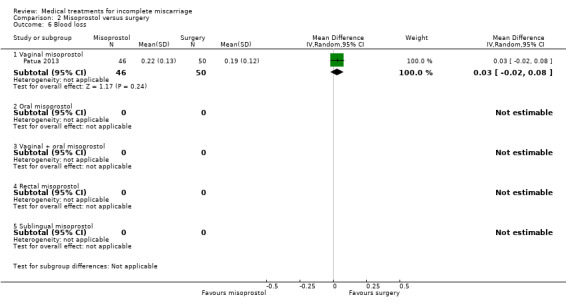
Comparison 2 Misoprostol versus surgery, Outcome 6 Blood loss.
2.12. Analysis.
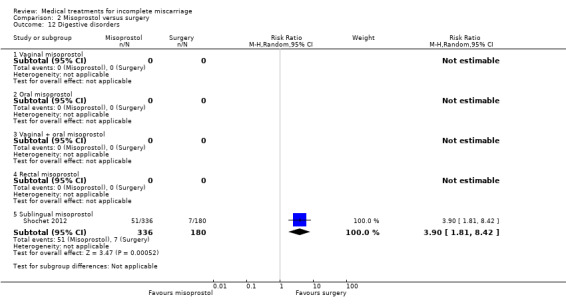
Comparison 2 Misoprostol versus surgery, Outcome 12 Digestive disorders.
Comparison 3. Vaginal misoprostol versus expectant care.
| Outcome or subgroup title | No. of studies | No. of participants | Statistical method | Effect size |
|---|---|---|---|---|
| 1 Complete miscarriage | 2 | Risk Ratio (M‐H, Random, 95% CI) | Subtotals only | |
| 1.1 Gestation < 13 weeks | 2 | 150 | Risk Ratio (M‐H, Random, 95% CI) | 1.23 [0.72, 2.10] |
| 1.2 Geststion 13‐23 weeks | 0 | 0 | Risk Ratio (M‐H, Random, 95% CI) | 0.0 [0.0, 0.0] |
| 1.3 Gestation not specified | 0 | 0 | Risk Ratio (M‐H, Random, 95% CI) | 0.0 [0.0, 0.0] |
| 2 Surgical evacuation | 2 | Risk Ratio (M‐H, Random, 95% CI) | Subtotals only | |
| 2.1 Gestation < 13 weeks | 2 | 308 | Risk Ratio (M‐H, Random, 95% CI) | 0.62 [0.17, 2.26] |
| 2.2 Gestation 13‐23 weeks | 0 | 0 | Risk Ratio (M‐H, Random, 95% CI) | 0.0 [0.0, 0.0] |
| 2.3 Gestation not specified | 0 | 0 | Risk Ratio (M‐H, Random, 95% CI) | 0.0 [0.0, 0.0] |
| 3 Death or serious complication | 1 | Risk Ratio (M‐H, Fixed, 95% CI) | Subtotals only | |
| 3.1 Gestation < 13 weeks | 1 | 126 | Risk Ratio (M‐H, Fixed, 95% CI) | 2.91 [0.12, 70.05] |
| 3.2 Gestation 13‐23 weeks | 0 | 0 | Risk Ratio (M‐H, Fixed, 95% CI) | 0.0 [0.0, 0.0] |
| 3.3 Gestation not specified | 0 | 0 | Risk Ratio (M‐H, Fixed, 95% CI) | 0.0 [0.0, 0.0] |
| 4 Unplanned surgical intervention | 2 | Risk Ratio (M‐H, Random, 95% CI) | Subtotals only | |
| 4.1 Gestation < 13 weeks | 2 | 308 | Risk Ratio (M‐H, Random, 95% CI) | 0.62 [0.17, 2.26] |
| 4.2 Gestation 13‐23 weeks | 0 | 0 | Risk Ratio (M‐H, Random, 95% CI) | 0.0 [0.0, 0.0] |
| 4.3 Gestation not specified | 0 | 0 | Risk Ratio (M‐H, Random, 95% CI) | 0.0 [0.0, 0.0] |
| 5 Blood transfusion | 3 | Risk Ratio (M‐H, Fixed, 95% CI) | Subtotals only | |
| 5.1 Gestation < 13 weeks | 3 | 332 | Risk Ratio (M‐H, Fixed, 95% CI) | 3.07 [0.13, 74.28] |
| 5.2 Gestation 13‐23 weeks | 0 | 0 | Risk Ratio (M‐H, Fixed, 95% CI) | 0.0 [0.0, 0.0] |
| 5.3 Gestation not specified | 0 | 0 | Risk Ratio (M‐H, Fixed, 95% CI) | 0.0 [0.0, 0.0] |
| 6 Pain relief | 2 | Risk Ratio (M‐H, Random, 95% CI) | Subtotals only | |
| 6.1 Gestation < 13 weeks | 2 | 308 | Risk Ratio (M‐H, Random, 95% CI) | 1.12 [0.67, 1.88] |
| 6.2 Gestation 13‐23 weeks | 0 | 0 | Risk Ratio (M‐H, Random, 95% CI) | 0.0 [0.0, 0.0] |
| 6.3 Gestation not specified | 0 | 0 | Risk Ratio (M‐H, Random, 95% CI) | 0.0 [0.0, 0.0] |
| 7 Pelvic infection < 14 days | 3 | Risk Ratio (M‐H, Fixed, 95% CI) | Subtotals only | |
| 7.1 Gestation < 13 weeks | 3 | 333 | Risk Ratio (M‐H, Fixed, 95% CI) | 2.81 [0.77, 10.33] |
| 7.2 Gestation 13‐23 weeks | 0 | 0 | Risk Ratio (M‐H, Fixed, 95% CI) | 0.0 [0.0, 0.0] |
| 7.3 Gestation not specified | 0 | 0 | Risk Ratio (M‐H, Fixed, 95% CI) | 0.0 [0.0, 0.0] |
Comparison 4. Vaginal misoprostol versus surgery.
| Outcome or subgroup title | No. of studies | No. of participants | Statistical method | Effect size |
|---|---|---|---|---|
| 1 Complete miscarriage | 5 | Risk Ratio (M‐H, Fixed, 95% CI) | Subtotals only | |
| 1.1 Gestation < 13 weeks | 5 | 364 | Risk Ratio (M‐H, Fixed, 95% CI) | 0.89 [0.84, 0.95] |
| 1.2 Gestation 13‐23 weeks | 0 | 0 | Risk Ratio (M‐H, Fixed, 95% CI) | 0.0 [0.0, 0.0] |
| 1.3 Gestation not specified | 0 | 0 | Risk Ratio (M‐H, Fixed, 95% CI) | 0.0 [0.0, 0.0] |
| 2 Surgical evacuation | 4 | Risk Ratio (M‐H, Random, 95% CI) | Subtotals only | |
| 2.1 Gestation < 13 weeks | 4 | 411 | Risk Ratio (M‐H, Random, 95% CI) | 0.16 [0.07, 0.35] |
| 2.2 Gestation 13‐23 weeks | 0 | 0 | Risk Ratio (M‐H, Random, 95% CI) | 0.0 [0.0, 0.0] |
| 2.3 Gestation not specified | 0 | 0 | Risk Ratio (M‐H, Random, 95% CI) | 0.0 [0.0, 0.0] |
| 3 Death or serious complication | 2 | Risk Ratio (M‐H, Fixed, 95% CI) | Subtotals only | |
| 3.1 Gestation < 13 weeks | 2 | 132 | Risk Ratio (M‐H, Fixed, 95% CI) | 1.0 [0.04, 22.64] |
| 3.2 Gestation 13‐23 weeks | 0 | 0 | Risk Ratio (M‐H, Fixed, 95% CI) | 0.0 [0.0, 0.0] |
| 3.3 Gestation not specified | 0 | 0 | Risk Ratio (M‐H, Fixed, 95% CI) | 0.0 [0.0, 0.0] |
| 4 Unplanned surgical intervention | 4 | Risk Ratio (M‐H, Random, 95% CI) | Subtotals only | |
| 4.1 Gestation < 13 weeks | 4 | 411 | Risk Ratio (M‐H, Random, 95% CI) | 4.29 [1.24, 14.87] |
| 4.2 Gestation 13‐23 weeks | 0 | 0 | Risk Ratio (M‐H, Random, 95% CI) | 0.0 [0.0, 0.0] |
| 4.3 Gestation not specified | 0 | 0 | Risk Ratio (M‐H, Random, 95% CI) | 0.0 [0.0, 0.0] |
| 5 Blood transfusion | 3 | Risk Ratio (M‐H, Fixed, 95% CI) | Subtotals only | |
| 5.1 Gestation < 13 weeks | 3 | 241 | Risk Ratio (M‐H, Fixed, 95% CI) | 1.82 [0.21, 15.70] |
| 5.2 Gestation 13‐23 weeks | 0 | 0 | Risk Ratio (M‐H, Fixed, 95% CI) | 0.0 [0.0, 0.0] |
| 5.3 Gestation not specified | 0 | 0 | Risk Ratio (M‐H, Fixed, 95% CI) | 0.0 [0.0, 0.0] |
| 6 Anaemia | 1 | Risk Ratio (M‐H, Fixed, 95% CI) | Subtotals only | |
| 6.1 Gestation < 13 weeks | 1 | 36 | Risk Ratio (M‐H, Fixed, 95% CI) | 1.71 [0.24, 12.24] |
| 6.2 Gestation 13‐23 weeks | 0 | 0 | Risk Ratio (M‐H, Fixed, 95% CI) | 0.0 [0.0, 0.0] |
| 6.3 Gestation not specified | 0 | 0 | Risk Ratio (M‐H, Fixed, 95% CI) | 0.0 [0.0, 0.0] |
| 7 Days of bleeding | 2 | Mean Difference (IV, Fixed, 95% CI) | Subtotals only | |
| 7.1 Gestation < 13 weeks | 2 | 131 | Mean Difference (IV, Fixed, 95% CI) | 2.76 [1.55, 3.97] |
| 7.2 Gestation 13‐23 weeks | 0 | 0 | Mean Difference (IV, Fixed, 95% CI) | 0.0 [0.0, 0.0] |
| 7.3 Gestation not specified | 0 | 0 | Mean Difference (IV, Fixed, 95% CI) | 0.0 [0.0, 0.0] |
| 8 Pain relief | 3 | Risk Ratio (M‐H, Fixed, 95% CI) | Subtotals only | |
| 8.1 Gestation < 13 weeks | 3 | 313 | Risk Ratio (M‐H, Fixed, 95% CI) | 1.75 [1.21, 2.54] |
| 8.2 Gestation 13‐23 weeks | 0 | 0 | Risk Ratio (M‐H, Fixed, 95% CI) | 0.0 [0.0, 0.0] |
| 8.3 Gestation not specified | 0 | 0 | Risk Ratio (M‐H, Fixed, 95% CI) | 0.0 [0.0, 0.0] |
| 9 Pelvic infection < 14 days | 4 | Risk Ratio (M‐H, Fixed, 95% CI) | Subtotals only | |
| 9.1 Gestation < 13 weeks | 4 | 338 | Risk Ratio (M‐H, Fixed, 95% CI) | 1.27 [0.37, 4.42] |
| 9.2 Gestation 13‐23 weeks | 0 | 0 | Risk Ratio (M‐H, Fixed, 95% CI) | 0.0 [0.0, 0.0] |
| 9.3 Gestation not specified | 0 | 0 | Risk Ratio (M‐H, Fixed, 95% CI) | 0.0 [0.0, 0.0] |
| 10 Women's views/satisfaction ‐ continuous data | 2 | Std. Mean Difference (IV, Random, 95% CI) | Subtotals only | |
| 10.1 Gestation < 13 weeks | 2 | 131 | Std. Mean Difference (IV, Random, 95% CI) | 1.01 [0.01, 2.00] |
| 10.2 Gestation 13‐23 weeks | 0 | 0 | Std. Mean Difference (IV, Random, 95% CI) | 0.0 [0.0, 0.0] |
| 10.3 Gestation not specified | 0 | 0 | Std. Mean Difference (IV, Random, 95% CI) | 0.0 [0.0, 0.0] |
| 11 Nausea | 3 | Risk Ratio (M‐H, Fixed, 95% CI) | Subtotals only | |
| 11.1 Gestation < 13 weeks | 3 | 156 | Risk Ratio (M‐H, Fixed, 95% CI) | 1.37 [0.58, 3.22] |
| 11.2 Gestation 13‐23 weeks | 0 | 0 | Risk Ratio (M‐H, Fixed, 95% CI) | 0.0 [0.0, 0.0] |
| 11.3 Gestation not specified | 0 | 0 | Risk Ratio (M‐H, Fixed, 95% CI) | 0.0 [0.0, 0.0] |
| 12 Vomiting | 2 | Risk Ratio (M‐H, Fixed, 95% CI) | Subtotals only | |
| 12.1 Gestation < 13 weeks | 2 | 131 | Risk Ratio (M‐H, Fixed, 95% CI) | 1.48 [0.25, 8.93] |
| 12.2 Gestation 13‐23 weeks | 0 | 0 | Risk Ratio (M‐H, Fixed, 95% CI) | 0.0 [0.0, 0.0] |
| 12.3 Gestation not specified | 0 | 0 | Risk Ratio (M‐H, Fixed, 95% CI) | 0.0 [0.0, 0.0] |
| 13 Diarrhoea | 2 | Risk Ratio (M‐H, Fixed, 95% CI) | Subtotals only | |
| 13.1 Gestation < 13 weeks | 2 | 131 | Risk Ratio (M‐H, Fixed, 95% CI) | 4.30 [0.52, 35.36] |
| 13.2 Gestation 13‐23 weeks | 0 | 0 | Risk Ratio (M‐H, Fixed, 95% CI) | 0.0 [0.0, 0.0] |
| 13.3 Gestation not specified | 0 | 0 | Risk Ratio (M‐H, Fixed, 95% CI) | 0.0 [0.0, 0.0] |
4.11. Analysis.
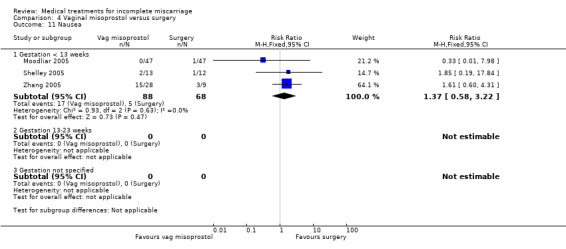
Comparison 4 Vaginal misoprostol versus surgery, Outcome 11 Nausea.
4.12. Analysis.

Comparison 4 Vaginal misoprostol versus surgery, Outcome 12 Vomiting.
4.13. Analysis.
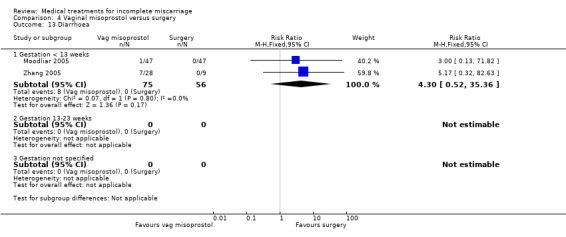
Comparison 4 Vaginal misoprostol versus surgery, Outcome 13 Diarrhoea.
Comparison 5. Oral misoprostol versus surgery.
| Outcome or subgroup title | No. of studies | No. of participants | Statistical method | Effect size |
|---|---|---|---|---|
| 1 Complete miscarriage | 7 | Risk Ratio (M‐H, Random, 95% CI) | Subtotals only | |
| 1.1 Gestation < 13 weeks | 7 | 1884 | Risk Ratio (M‐H, Random, 95% CI) | 0.98 [0.95, 1.00] |
| 1.2 Gestation 13‐23 weeks | 0 | 0 | Risk Ratio (M‐H, Random, 95% CI) | 0.0 [0.0, 0.0] |
| 1.3 Gestation not specified | 0 | 0 | Risk Ratio (M‐H, Random, 95% CI) | 0.0 [0.0, 0.0] |
| 2 Surgical evacuation | 7 | Risk Ratio (M‐H, Random, 95% CI) | Subtotals only | |
| 2.1 Gestation < 13 weeks | 7 | 1884 | Risk Ratio (M‐H, Random, 95% CI) | 0.04 [0.02, 0.07] |
| 2.2 Gestation 13‐23 weeks | 0 | 0 | Risk Ratio (M‐H, Random, 95% CI) | 0.0 [0.0, 0.0] |
| 2.3 Gestation not specified | 0 | 0 | Risk Ratio (M‐H, Random, 95% CI) | 0.0 [0.0, 0.0] |
| 3 Unplanned surgical intervention | 6 | Risk Ratio (M‐H, Fixed, 95% CI) | Subtotals only | |
| 3.1 Gestation < 13 weeks | 6 | 1584 | Risk Ratio (M‐H, Fixed, 95% CI) | 6.27 [2.57, 15.31] |
| 3.2 Gestation 13‐23 weeks | 0 | 0 | Risk Ratio (M‐H, Fixed, 95% CI) | 0.0 [0.0, 0.0] |
| 3.3 Gestation not specified | 0 | 0 | Risk Ratio (M‐H, Fixed, 95% CI) | 0.0 [0.0, 0.0] |
| 4 Blood transfusion | 1 | Risk Ratio (M‐H, Fixed, 95% CI) | Subtotals only | |
| 4.1 Gestation < 13 weeks | 1 | 189 | Risk Ratio (M‐H, Fixed, 95% CI) | 0.0 [0.0, 0.0] |
| 4.2 Gestation 13‐23 weeks | 0 | 0 | Risk Ratio (M‐H, Fixed, 95% CI) | 0.0 [0.0, 0.0] |
| 4.3 Gestation not specified | 0 | 0 | Risk Ratio (M‐H, Fixed, 95% CI) | 0.0 [0.0, 0.0] |
| 5 Pain relief | 1 | Risk Ratio (M‐H, Fixed, 95% CI) | Subtotals only | |
| 5.1 Gestation < 13 weeks | 1 | 212 | Risk Ratio (M‐H, Fixed, 95% CI) | 0.85 [0.77, 0.92] |
| 5.2 Gestation 13‐23 weeks | 0 | 0 | Risk Ratio (M‐H, Fixed, 95% CI) | 0.0 [0.0, 0.0] |
| 5.3 Gestation not specified | 0 | 0 | Risk Ratio (M‐H, Fixed, 95% CI) | 0.0 [0.0, 0.0] |
| 6 Pelvic infection | 2 | Risk Ratio (M‐H, Fixed, 95% CI) | Subtotals only | |
| 6.1 Gestation < 13 weeks | 2 | 489 | Risk Ratio (M‐H, Fixed, 95% CI) | 0.26 [0.03, 2.41] |
| 6.2 Gestation 13‐23 weeks | 0 | 0 | Risk Ratio (M‐H, Fixed, 95% CI) | 0.0 [0.0, 0.0] |
| 6.3 Gestation not specified | 0 | 0 | Risk Ratio (M‐H, Fixed, 95% CI) | 0.0 [0.0, 0.0] |
| 7 Cervical damage | 1 | Risk Ratio (M‐H, Fixed, 95% CI) | Subtotals only | |
| 7.1 Gestation < 13 weeks | 1 | 189 | Risk Ratio (M‐H, Fixed, 95% CI) | 0.07 [0.00, 1.25] |
| 7.2 Gestation 13‐23 weeks | 0 | 0 | Risk Ratio (M‐H, Fixed, 95% CI) | 0.0 [0.0, 0.0] |
| 7.3 Gestation not specified | 0 | 0 | Risk Ratio (M‐H, Fixed, 95% CI) | 0.0 [0.0, 0.0] |
| 8 Women's views/acceptability of method | 7 | Risk Ratio (M‐H, Fixed, 95% CI) | Subtotals only | |
| 8.1 Gestation < 13 weeks | 7 | 1875 | Risk Ratio (M‐H, Fixed, 95% CI) | 0.99 [0.98, 1.01] |
| 8.2 Gestation 13‐23 weeks | 0 | 0 | Risk Ratio (M‐H, Fixed, 95% CI) | 0.0 [0.0, 0.0] |
| 8.3 Gestation not specified | 0 | 0 | Risk Ratio (M‐H, Fixed, 95% CI) | 0.0 [0.0, 0.0] |
| 9 Nausea | 6 | Risk Ratio (M‐H, Fixed, 95% CI) | Subtotals only | |
| 9.1 Gestation < 13 weeks | 6 | 1700 | Risk Ratio (M‐H, Fixed, 95% CI) | 3.24 [2.10, 4.98] |
| 9.2 Gestation 13‐23 weeks | 0 | 0 | Risk Ratio (M‐H, Fixed, 95% CI) | 0.0 [0.0, 0.0] |
| 9.3 Gestation not specified | 0 | 0 | Risk Ratio (M‐H, Fixed, 95% CI) | 0.0 [0.0, 0.0] |
| 10 Vomiting | 6 | Risk Ratio (M‐H, Fixed, 95% CI) | Subtotals only | |
| 10.1 Gestation < 13 weeks | 6 | 1687 | Risk Ratio (M‐H, Fixed, 95% CI) | 1.99 [1.18, 3.34] |
| 10.2 Gestation 13‐23 weeks | 0 | 0 | Risk Ratio (M‐H, Fixed, 95% CI) | 0.0 [0.0, 0.0] |
| 10.3 Gestation not specified | 0 | 0 | Risk Ratio (M‐H, Fixed, 95% CI) | 0.0 [0.0, 0.0] |
| 11 Diarrhoea | 2 | Risk Ratio (M‐H, Fixed, 95% CI) | Subtotals only | |
| 11.1 Gestation < 13 weeks | 2 | 626 | Risk Ratio (M‐H, Fixed, 95% CI) | 5.79 [0.70, 47.64] |
| 11.2 Gestation 13‐23 weeks | 0 | 0 | Risk Ratio (M‐H, Fixed, 95% CI) | 0.0 [0.0, 0.0] |
| 11.3 Gestation not specified | 0 | 0 | Risk Ratio (M‐H, Fixed, 95% CI) | 0.0 [0.0, 0.0] |
Comparison 6. Vaginal + oral misoprostol versus surgery.
| Outcome or subgroup title | No. of studies | No. of participants | Statistical method | Effect size |
|---|---|---|---|---|
| 1 Complete miscarriage | 1 | Risk Ratio (M‐H, Fixed, 95% CI) | Subtotals only | |
| 1.1 Gestation < 13 weeks | 1 | 80 | Risk Ratio (M‐H, Fixed, 95% CI) | 0.95 [0.87, 1.04] |
| 1.2 Gestation 13‐23 weeks | 0 | 0 | Risk Ratio (M‐H, Fixed, 95% CI) | 0.0 [0.0, 0.0] |
| 1.3 Gestation not specified | 0 | 0 | Risk Ratio (M‐H, Fixed, 95% CI) | 0.0 [0.0, 0.0] |
| 2 Surgical evacuation | 1 | Risk Ratio (M‐H, Fixed, 95% CI) | Subtotals only | |
| 2.1 Gestation < 13 weeks | 1 | 80 | Risk Ratio (M‐H, Fixed, 95% CI) | 0.04 [0.01, 0.18] |
| 2.2 Gestation 13‐23 weeks | 0 | 0 | Risk Ratio (M‐H, Fixed, 95% CI) | 0.0 [0.0, 0.0] |
| 2.3 Gestation not specified | 0 | 0 | Risk Ratio (M‐H, Fixed, 95% CI) | 0.0 [0.0, 0.0] |
| 3 Days of bleeding | 1 | Mean Difference (IV, Fixed, 95% CI) | Subtotals only | |
| 3.1 Gestation < 13 weeks | 1 | 80 | Mean Difference (IV, Fixed, 95% CI) | 1.55 [0.58, 2.52] |
| 3.2 Gestation 13‐23 weeks | 0 | 0 | Mean Difference (IV, Fixed, 95% CI) | 0.0 [0.0, 0.0] |
| 3.3 Gestation not specified | 0 | 0 | Mean Difference (IV, Fixed, 95% CI) | 0.0 [0.0, 0.0] |
| 4 Pelvic infection | 1 | Risk Ratio (M‐H, Fixed, 95% CI) | Subtotals only | |
| 4.1 Gestation < 13 weeks | 1 | 80 | Risk Ratio (M‐H, Fixed, 95% CI) | 0.5 [0.05, 5.30] |
| 4.2 Gestation 13‐23 weeks | 0 | 0 | Risk Ratio (M‐H, Fixed, 95% CI) | 0.0 [0.0, 0.0] |
| 4.3 Gestation not specified | 0 | 0 | Risk Ratio (M‐H, Fixed, 95% CI) | 0.0 [0.0, 0.0] |
Comparison 7. Sublingual misoprostol versus surgery.
| Outcome or subgroup title | No. of studies | No. of participants | Statistical method | Effect size |
|---|---|---|---|---|
| 1 Complete miscarriage | 2 | Risk Ratio (M‐H, Fixed, 95% CI) | Subtotals only | |
| 1.1 Gestation < 13 weeks | 2 | 1534 | Risk Ratio (M‐H, Fixed, 95% CI) | 0.96 [0.95, 0.98] |
| 1.2 Gestation 13‐23 weeks | 0 | 0 | Risk Ratio (M‐H, Fixed, 95% CI) | 0.0 [0.0, 0.0] |
| 1.3 Gestation not specified | 0 | 0 | Risk Ratio (M‐H, Fixed, 95% CI) | 0.0 [0.0, 0.0] |
| 2 Surgical evacuation | 1 | Risk Ratio (M‐H, Fixed, 95% CI) | Subtotals only | |
| 2.1 Gestation <13 weeks | 1 | 695 | Risk Ratio (M‐H, Fixed, 95% CI) | 0.02 [0.01, 0.04] |
| 2.2 Gestation 13‐23 weeks | 0 | 0 | Risk Ratio (M‐H, Fixed, 95% CI) | 0.0 [0.0, 0.0] |
| 2.3 Gestation not specified | 0 | 0 | Risk Ratio (M‐H, Fixed, 95% CI) | 0.0 [0.0, 0.0] |
| 3 Unplanned surgical intervention | 1 | Risk Ratio (M‐H, Fixed, 95% CI) | Subtotals only | |
| 3.1 Gestation < 13 weeks | 1 | 695 | Risk Ratio (M‐H, Fixed, 95% CI) | 5.98 [0.72, 49.43] |
| 3.2 Gestation 13‐23 weeks | 0 | 0 | Risk Ratio (M‐H, Fixed, 95% CI) | 0.0 [0.0, 0.0] |
| 3.3 Gestation not specified | 0 | 0 | Risk Ratio (M‐H, Fixed, 95% CI) | 0.0 [0.0, 0.0] |
| 4 Anaemia | 1 | Risk Ratio (M‐H, Fixed, 95% CI) | Subtotals only | |
| 4.1 Gestation < 13 weeks | 1 | 695 | Risk Ratio (M‐H, Fixed, 95% CI) | 0.33 [0.03, 3.18] |
| 4.2 Gestation 13‐23 weeks | 0 | 0 | Risk Ratio (M‐H, Fixed, 95% CI) | 0.0 [0.0, 0.0] |
| 4.3 Gestation not specified | 0 | 0 | Risk Ratio (M‐H, Fixed, 95% CI) | 0.0 [0.0, 0.0] |
| 5 Digestive disorders | 1 | Risk Ratio (M‐H, Fixed, 95% CI) | Subtotals only | |
| 5.1 Gestation < 13 weeks | 1 | 516 | Risk Ratio (M‐H, Fixed, 95% CI) | 3.90 [1.81, 8.42] |
| 5.2 Gestation 13‐23 weeks | 0 | 0 | Risk Ratio (M‐H, Fixed, 95% CI) | 0.0 [0.0, 0.0] |
| 5.3 Gestation not specified | 0 | 0 | Risk Ratio (M‐H, Fixed, 95% CI) | 0.0 [0.0, 0.0] |
| 6 Women's views/acceptability of method | 2 | Risk Ratio (M‐H, Fixed, 95% CI) | Subtotals only | |
| 6.1 Gestation < 13 weeks | 2 | 1474 | Risk Ratio (M‐H, Fixed, 95% CI) | 0.99 [0.98, 1.01] |
| 6.2 Gestation 13‐23 weeks | 0 | 0 | Risk Ratio (M‐H, Fixed, 95% CI) | 0.0 [0.0, 0.0] |
| 6.3 Gestation not specified | 0 | 0 | Risk Ratio (M‐H, Fixed, 95% CI) | 0.0 [0.0, 0.0] |
| 7 Nausea | 2 | Risk Ratio (M‐H, Fixed, 95% CI) | Subtotals only | |
| 7.1 Gestation < 13 weeks | 2 | 1159 | Risk Ratio (M‐H, Fixed, 95% CI) | 1.86 [1.48, 2.32] |
| 7.2 Gestation 13‐23 weeks | 0 | 0 | Risk Ratio (M‐H, Fixed, 95% CI) | 0.0 [0.0, 0.0] |
| 7.3 Gestation not specified | 0 | 0 | Risk Ratio (M‐H, Fixed, 95% CI) | 0.0 [0.0, 0.0] |
| 8 Vomiting | 2 | Risk Ratio (M‐H, Fixed, 95% CI) | Subtotals only | |
| 8.1 Gestation < 13 weeks | 2 | 1159 | Risk Ratio (M‐H, Fixed, 95% CI) | 2.42 [1.43, 4.10] |
| 8.2 Gestation 13‐23 weeks | 0 | 0 | Risk Ratio (M‐H, Fixed, 95% CI) | 0.0 [0.0, 0.0] |
| 8.3 Gestation not specified | 0 | 0 | Risk Ratio (M‐H, Fixed, 95% CI) | 0.0 [0.0, 0.0] |
Comparison 8. Vaginal misoprostol versus oral misoprostol.
| Outcome or subgroup title | No. of studies | No. of participants | Statistical method | Effect size |
|---|---|---|---|---|
| 1 Complete miscarriage | 1 | Risk Ratio (M‐H, Fixed, 95% CI) | Subtotals only | |
| 1.1 Gestation < 13 weeks | 1 | 198 | Risk Ratio (M‐H, Fixed, 95% CI) | 0.94 [0.76, 1.16] |
| 1.2 Gestation 13‐23 weeks | 0 | 0 | Risk Ratio (M‐H, Fixed, 95% CI) | 0.0 [0.0, 0.0] |
| 1.3 Gestation not specified | 0 | 0 | Risk Ratio (M‐H, Fixed, 95% CI) | 0.0 [0.0, 0.0] |
| 2 Surgical evacuation | 1 | Risk Ratio (M‐H, Fixed, 95% CI) | Subtotals only | |
| 2.1 Gestation < 13 weeks | 1 | 198 | Risk Ratio (M‐H, Fixed, 95% CI) | 1.11 [0.77, 1.60] |
| 2.2 Gestation 13‐23 weeks | 0 | 0 | Risk Ratio (M‐H, Fixed, 95% CI) | 0.0 [0.0, 0.0] |
| 2.3 Gestation not specified | 0 | 0 | Risk Ratio (M‐H, Fixed, 95% CI) | 0.0 [0.0, 0.0] |
| 3 Unplanned surgical intervention | 1 | Risk Ratio (M‐H, Fixed, 95% CI) | Subtotals only | |
| 3.1 Gestation < 13 weeks | 1 | 186 | Risk Ratio (M‐H, Fixed, 95% CI) | 0.36 [0.01, 8.80] |
| 3.2 Gestation 13‐23 weeks | 0 | 0 | Risk Ratio (M‐H, Fixed, 95% CI) | 0.0 [0.0, 0.0] |
| 3.3 Gestation not specified | 0 | 0 | Risk Ratio (M‐H, Fixed, 95% CI) | 0.0 [0.0, 0.0] |
| 4 Pain relief | 1 | Risk Ratio (M‐H, Fixed, 95% CI) | Subtotals only | |
| 4.1 Gestation < 13 weeks | 1 | 186 | Risk Ratio (M‐H, Fixed, 95% CI) | 1.43 [0.93, 2.17] |
| 4.2 Gestation 13‐23 weeks | 0 | 0 | Risk Ratio (M‐H, Fixed, 95% CI) | 0.0 [0.0, 0.0] |
| 4.3 Gestation not specified | 0 | 0 | Risk Ratio (M‐H, Fixed, 95% CI) | 0.0 [0.0, 0.0] |
| 5 Nausea | 1 | Risk Ratio (M‐H, Fixed, 95% CI) | Subtotals only | |
| 5.1 Gestation < 13 weeks | 1 | 198 | Risk Ratio (M‐H, Fixed, 95% CI) | 0.63 [0.26, 1.54] |
| 5.2 Gestation 13‐23 weeks | 0 | 0 | Risk Ratio (M‐H, Fixed, 95% CI) | 0.0 [0.0, 0.0] |
| 5.3 Gestation not specified | 0 | 0 | Risk Ratio (M‐H, Fixed, 95% CI) | 0.0 [0.0, 0.0] |
| 6 Vomiting | 1 | Risk Ratio (M‐H, Fixed, 95% CI) | Subtotals only | |
| 6.1 Gestation < 13 weeks | 1 | 198 | Risk Ratio (M‐H, Fixed, 95% CI) | 0.36 [0.07, 1.75] |
| 6.2 Gestation 13‐23 weeks | 0 | 0 | Risk Ratio (M‐H, Fixed, 95% CI) | 0.0 [0.0, 0.0] |
| 6.3 Gestation not specified | 0 | 0 | Risk Ratio (M‐H, Fixed, 95% CI) | 0.0 [0.0, 0.0] |
| 7 Diarrhoea | 1 | Risk Ratio (M‐H, Fixed, 95% CI) | Subtotals only | |
| 7.1 Gestation < 13 weeks | 1 | 198 | Risk Ratio (M‐H, Fixed, 95% CI) | 0.21 [0.12, 0.36] |
| 7.2 Gestation 13‐23 weeks | 0 | 0 | Risk Ratio (M‐H, Fixed, 95% CI) | 0.0 [0.0, 0.0] |
| 7.3 Gestation not specified | 0 | 0 | Risk Ratio (M‐H, Fixed, 95% CI) | 0.0 [0.0, 0.0] |
Comparison 9. Oral misoprostol: 600 ug versus 1200 ug.
| Outcome or subgroup title | No. of studies | No. of participants | Statistical method | Effect size |
|---|---|---|---|---|
| 1 Complete miscarriage | 2 | Risk Ratio (M‐H, Fixed, 95% CI) | Subtotals only | |
| 1.1 Gestation < 13 weeks | 2 | 464 | Risk Ratio (M‐H, Fixed, 95% CI) | 1.00 [0.93, 1.07] |
| 1.2 Gestation 13‐23 weeks | 0 | 0 | Risk Ratio (M‐H, Fixed, 95% CI) | 0.0 [0.0, 0.0] |
| 1.3 Gestation not specified | 0 | 0 | Risk Ratio (M‐H, Fixed, 95% CI) | 0.0 [0.0, 0.0] |
| 2 Surgical evacuation | 1 | Risk Ratio (M‐H, Fixed, 95% CI) | Subtotals only | |
| 2.1 Gestation < 13 weeks | 1 | 295 | Risk Ratio (M‐H, Fixed, 95% CI) | 0.76 [0.29, 1.99] |
| 2.2 Gestation 13‐23 weeks | 0 | 0 | Risk Ratio (M‐H, Fixed, 95% CI) | 0.0 [0.0, 0.0] |
| 2.3 Gestation not specified | 0 | 0 | Risk Ratio (M‐H, Fixed, 95% CI) | 0.0 [0.0, 0.0] |
| 3 Death or serious complication | 1 | 295 | Risk Ratio (M‐H, Fixed, 95% CI) | 0.0 [0.0, 0.0] |
| 3.1 Gestation < 13 weeks | 1 | 295 | Risk Ratio (M‐H, Fixed, 95% CI) | 0.0 [0.0, 0.0] |
| 3.2 Gestation 13‐23 weeks | 0 | 0 | Risk Ratio (M‐H, Fixed, 95% CI) | 0.0 [0.0, 0.0] |
| 3.3 Gestation not specified | 0 | 0 | Risk Ratio (M‐H, Fixed, 95% CI) | 0.0 [0.0, 0.0] |
| 4 Unplanned surgical intervention | 1 | Risk Ratio (M‐H, Fixed, 95% CI) | Subtotals only | |
| 4.1 Gestation < 13 weeks | 1 | 295 | Risk Ratio (M‐H, Fixed, 95% CI) | 0.76 [0.29, 1.99] |
| 4.2 Gestation 13‐23 weeks | 0 | 0 | Risk Ratio (M‐H, Fixed, 95% CI) | 0.0 [0.0, 0.0] |
| 4.3 Gestation not specified | 0 | 0 | Risk Ratio (M‐H, Fixed, 95% CI) | 0.0 [0.0, 0.0] |
| 5 Women's views/acceptability of method | 2 | Risk Ratio (M‐H, Fixed, 95% CI) | Subtotals only | |
| 5.1 Gestation < 13 weeks | 2 | 460 | Risk Ratio (M‐H, Fixed, 95% CI) | 1.02 [0.96, 1.09] |
| 5.2 Gestation 13‐23 weeks | 0 | 0 | Risk Ratio (M‐H, Fixed, 95% CI) | 0.0 [0.0, 0.0] |
| 5.3 Gestation not specified | 0 | 0 | Risk Ratio (M‐H, Fixed, 95% CI) | 0.0 [0.0, 0.0] |
| 6 Nausea | 2 | Risk Ratio (M‐H, Random, 95% CI) | Subtotals only | |
| 6.1 Gestation < 13 weeks | 2 | 463 | Risk Ratio (M‐H, Random, 95% CI) | 1.19 [0.57, 2.46] |
| 6.2 Gestation 13‐23 weeks | 0 | 0 | Risk Ratio (M‐H, Random, 95% CI) | 0.0 [0.0, 0.0] |
| 6.3 Gestation not specified | 0 | 0 | Risk Ratio (M‐H, Random, 95% CI) | 0.0 [0.0, 0.0] |
| 7 Vomiting | 2 | Risk Ratio (M‐H, Fixed, 95% CI) | Subtotals only | |
| 7.1 Gestation < 13 weeks | 2 | 463 | Risk Ratio (M‐H, Fixed, 95% CI) | 1.01 [0.60, 1.72] |
| 7.2 Gestation 13‐23 weeks | 0 | 0 | Risk Ratio (M‐H, Fixed, 95% CI) | 0.0 [0.0, 0.0] |
| 7.3 Gestation not specified | 0 | 0 | Risk Ratio (M‐H, Fixed, 95% CI) | 0.0 [0.0, 0.0] |
| 8 Diarrhoea | 1 | Risk Ratio (M‐H, Fixed, 95% CI) | Subtotals only | |
| 8.1 Gestation < 13 weeks | 1 | 294 | Risk Ratio (M‐H, Fixed, 95% CI) | 0.73 [0.55, 0.97] |
| 8.2 Gestation 13‐23 weeks | 0 | 0 | Risk Ratio (M‐H, Fixed, 95% CI) | 0.0 [0.0, 0.0] |
| 8.3 Gestation not specified | 0 | 0 | Risk Ratio (M‐H, Fixed, 95% CI) | 0.0 [0.0, 0.0] |
9.5. Analysis.
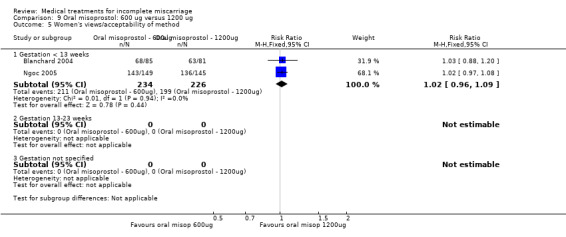
Comparison 9 Oral misoprostol: 600 ug versus 1200 ug, Outcome 5 Women's views/acceptability of method.
Comparison 10. Oral mifepristone + vaginal misoprostol versus surgery.
| Outcome or subgroup title | No. of studies | No. of participants | Statistical method | Effect size |
|---|---|---|---|---|
| 1 Complete miscarriage | 1 | 19 | Risk Ratio (M‐H, Fixed, 95% CI) | 1.0 [0.77, 1.31] |
| 1.1 Gestation < 13 weeks | 1 | 16 | Risk Ratio (M‐H, Fixed, 95% CI) | 1.0 [0.78, 1.27] |
| 1.2 Gestation 13‐23 weeks | 1 | 3 | Risk Ratio (M‐H, Fixed, 95% CI) | 1.0 [0.39, 2.58] |
| 1.3 Gestation not specified | 0 | 0 | Risk Ratio (M‐H, Fixed, 95% CI) | 0.0 [0.0, 0.0] |
| 2 Pelvic infection < 14 days | 1 | 19 | Risk Ratio (M‐H, Fixed, 95% CI) | 0.0 [0.0, 0.0] |
| 2.1 Gestation < 13 weeks | 1 | 16 | Risk Ratio (M‐H, Fixed, 95% CI) | 0.0 [0.0, 0.0] |
| 2.2 Gestation 13‐23 weeks | 1 | 3 | Risk Ratio (M‐H, Fixed, 95% CI) | 0.0 [0.0, 0.0] |
| 2.3 Gestation not specified | 0 | 0 | Risk Ratio (M‐H, Fixed, 95% CI) | 0.0 [0.0, 0.0] |
10.1. Analysis.
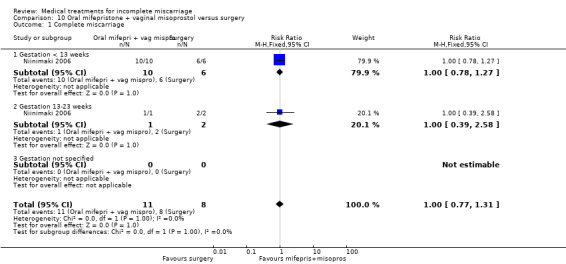
Comparison 10 Oral mifepristone + vaginal misoprostol versus surgery, Outcome 1 Complete miscarriage.
10.2. Analysis.
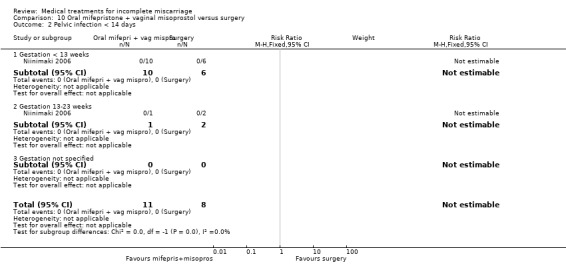
Comparison 10 Oral mifepristone + vaginal misoprostol versus surgery, Outcome 2 Pelvic infection < 14 days.
Comparison 11. Vaginal prostaglandin E1 (gemeprost) versus surgery.
| Outcome or subgroup title | No. of studies | No. of participants | Statistical method | Effect size |
|---|---|---|---|---|
| 1 Unplanned surgical intervention | 1 | 34 | Risk Ratio (M‐H, Fixed, 95% CI) | 0.0 [0.0, 0.0] |
| 1.1 Gestation < 13 weeks | 1 | 34 | Risk Ratio (M‐H, Fixed, 95% CI) | 0.0 [0.0, 0.0] |
| 1.2 Gestation 13‐23 weeks | 0 | 0 | Risk Ratio (M‐H, Fixed, 95% CI) | 0.0 [0.0, 0.0] |
| 1.3 Gestation not specified | 0 | 0 | Risk Ratio (M‐H, Fixed, 95% CI) | 0.0 [0.0, 0.0] |
Comparison 12. Sublingual misoprostol versus oral misoprostol.
| Outcome or subgroup title | No. of studies | No. of participants | Statistical method | Effect size |
|---|---|---|---|---|
| 1 Complete miscarriage | 2 | Risk Ratio (M‐H, Fixed, 95% CI) | Subtotals only | |
| 1.1 Gestation < 13 weeks | 2 | 358 | Risk Ratio (M‐H, Fixed, 95% CI) | 0.99 [0.94, 1.05] |
| 1.2 Gestation 13‐23 weeks | 0 | 0 | Risk Ratio (M‐H, Fixed, 95% CI) | 0.0 [0.0, 0.0] |
| 1.3 Gestation not specified | 0 | 0 | Risk Ratio (M‐H, Fixed, 95% CI) | 0.0 [0.0, 0.0] |
| 2 Surgical evacuation | 1 | Risk Ratio (M‐H, Fixed, 95% CI) | Subtotals only | |
| 2.1 Gestation < 13 weeks | 1 | 294 | Risk Ratio (M‐H, Fixed, 95% CI) | 1.01 [0.39, 2.63] |
| 2.2 Gestation 13‐23 weeks | 0 | 0 | Risk Ratio (M‐H, Fixed, 95% CI) | 0.0 [0.0, 0.0] |
| 2.3 Gestation not specified | 0 | 0 | Risk Ratio (M‐H, Fixed, 95% CI) | 0.0 [0.0, 0.0] |
| 3 Death or serious complication | 2 | 358 | Risk Ratio (M‐H, Fixed, 95% CI) | 0.0 [0.0, 0.0] |
| 3.1 Gestation < 13 weeks | 2 | 358 | Risk Ratio (M‐H, Fixed, 95% CI) | 0.0 [0.0, 0.0] |
| 3.2 Gestation 13‐23 weeks | 0 | 0 | Risk Ratio (M‐H, Fixed, 95% CI) | 0.0 [0.0, 0.0] |
| 3.3 Gestation not specified | 0 | 0 | Risk Ratio (M‐H, Fixed, 95% CI) | 0.0 [0.0, 0.0] |
| 4 Nausea | 2 | Risk Ratio (M‐H, Fixed, 95% CI) | Subtotals only | |
| 4.1 Gestation < 13 weeks | 2 | 358 | Risk Ratio (M‐H, Fixed, 95% CI) | 0.78 [0.49, 1.23] |
| 4.2 Gestation 13‐23 weeks | 0 | 0 | Risk Ratio (M‐H, Fixed, 95% CI) | 0.0 [0.0, 0.0] |
| 4.3 Gestation not specified | 0 | 0 | Risk Ratio (M‐H, Fixed, 95% CI) | 0.0 [0.0, 0.0] |
| 5 Vomiting | 2 | Risk Ratio (M‐H, Fixed, 95% CI) | Subtotals only | |
| 5.1 Gestation < 13 weeks | 2 | 358 | Risk Ratio (M‐H, Fixed, 95% CI) | 1.01 [0.14, 7.10] |
| 5.2 Gestation 13‐23 weeks | 0 | 0 | Risk Ratio (M‐H, Fixed, 95% CI) | 0.0 [0.0, 0.0] |
| 5.3 Gestation not specified | 0 | 0 | Risk Ratio (M‐H, Fixed, 95% CI) | 0.0 [0.0, 0.0] |
| 6 Diarrhoea | 2 | Risk Ratio (M‐H, Fixed, 95% CI) | Subtotals only | |
| 6.1 Gestation < 13 weeks | 2 | 358 | Risk Ratio (M‐H, Fixed, 95% CI) | 1.58 [0.66, 3.76] |
| 6.2 Gestation 13‐23 weeks | 0 | 0 | Risk Ratio (M‐H, Fixed, 95% CI) | 0.0 [0.0, 0.0] |
| 6.3 Gestation not specified | 0 | 0 | Risk Ratio (M‐H, Fixed, 95% CI) | 0.0 [0.0, 0.0] |
| 7 Women's views/acceptability of method | 2 | 358 | Risk Ratio (M‐H, Fixed, 95% CI) | 0.99 [0.95, 1.03] |
12.3. Analysis.
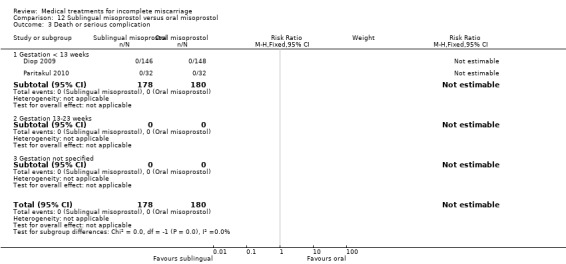
Comparison 12 Sublingual misoprostol versus oral misoprostol, Outcome 3 Death or serious complication.
Characteristics of studies
Characteristics of included studies [ordered by study ID]
Bique 2007.
| Methods | RCT with randomisation of individual women. Using computer‐generated random numbers in sequentially numbered opaque envelopes. | |
| Participants |
Inclusion criteria
Exclusion criteria
|
|
| Interventions |
Intervention: oral misoprostol
Comparison: surgery
|
|
| Outcomes | Complete miscarriage without recourse to additional surgical intervention, experience of side effects and acceptability of treatment.
|
|
| Notes |
|
|
| Risk of bias | ||
| Bias | Authors' judgement | Support for judgement |
| Random sequence generation (selection bias) | Low risk | "The randomisation scheme was generated by computer..." |
| Allocation concealment (selection bias) | Low risk | "...treatment allocations printed on cards inserted into sequentially numbered opaque envelopes...a member of the study staff opened the next envelope in the sequence and assigned to women to the indicated treatment group." |
| Blinding of participants and personnel (performance bias) All outcomes | High risk | It was not possible to blind people and this is discussed by authors. |
| Blinding of outcome assessment (detection bias) All outcomes | High risk | It was not possible to blind people and this is discussed by authors. |
| Incomplete outcome data (attrition bias) All outcomes | Low risk |
|
| Selective reporting (reporting bias) | Unclear risk | As far as can tell, outcomes reported were those prespecified, however the trial protocol was not assessed. |
| Other bias | Unclear risk | The 2 groups were comparable on background characteristics. But the paper mentioned that "in the process of monitoring the first 20 cases, it was noted that the randomisation scheme was not being appropriately followed ‐ the study was re‐started". More women were lost to follow‐up in the MVA group than the misoprostol group. |
Blanchard 2004.
| Methods | RCT with randomisation of individual women. Sequentially numbered opaque envelopes, using pseudo‐random number generator. | |
| Participants |
Inclusion criteria
Exclusion criteria
|
|
| Interventions |
Intervention: oral misoprostol
Comparison: oral misoprostol
|
|
| Outcomes | Complete miscarriage at 48 hours; surgical evacuation; side effects and acceptability.
|
|
| Notes |
|
|
| Risk of bias | ||
| Bias | Authors' judgement | Support for judgement |
| Random sequence generation (selection bias) | Low risk | "Pseudo‐random number generator in SSPS 9.0." |
| Allocation concealment (selection bias) | Low risk | Women given the next "...sequentially numbered opaque envelope; the number in the envelope became her study identification number". |
| Blinding of participants and personnel (performance bias) All outcomes | High risk | "Neither the provider nor the woman was blinded to the treatment regimes." |
| Blinding of outcome assessment (detection bias) All outcomes | High risk | "Neither the provider nor the woman was blinded to the treatment regimes." |
| Incomplete outcome data (attrition bias) All outcomes | Low risk | 2 women in single‐dose group and 1 woman in double‐dose group were lost to follow‐up. 1.8% of total, so no real impact. |
| Selective reporting (reporting bias) | Unclear risk | Appears to be free of selective reporting bias but we did not assess the trial protocol. |
| Other bias | Low risk | Appears to be free of other reporting bias. |
Blohm 2005.
| Methods | RCT with randomisation of individual women. | |
| Participants |
Inclusion criteria
Exclusion criteria
|
|
| Interventions |
Intervention: vaginal misoprostol
Comparison: placebo
|
|
| Outcomes | Complete miscarriage assessed at 6‐7 days; infection; bleeding; gastrointestinal side effects; subjective pain; use of analgesics and length of sick leave.
|
|
| Notes |
|
|
| Risk of bias | ||
| Bias | Authors' judgement | Support for judgement |
| Random sequence generation (selection bias) | Low risk | "...random table system..." |
| Allocation concealment (selection bias) | Low risk | "Patients were randomised...by drawing a sealed envelope from a box...tablets were delivered to the independent pharmacy where they were inserted by the pharmacy staff into numbered envelopes in blocks of 10...the randomisation list was retained by the hospital pharmacy and was not broken until after completion of the study when statistical analyses were performed." However, no mention of the envelopes being opaque ‐ so concealment allocation unclear but because tablets are identical, it seems unlikely there is a problem here. |
| Blinding of participants and personnel (performance bias) All outcomes | Low risk | The placebo tablets "...were identical in appearance to the active misoprostol tablets" and clinicians "...unaware of the randomisation sequence." |
| Blinding of outcome assessment (detection bias) All outcomes | Low risk | The placebo tablets "...were identical in appearance to the active misoprostol tablets" and clinicians "...unaware of the randomisation sequence." |
| Incomplete outcome data (attrition bias) All outcomes | Low risk | There was no loss to follow‐up and women received their appropriate allocation. The analysis appears to be ITT. |
| Selective reporting (reporting bias) | Unclear risk | Seems to be free of bias here, although the secondary outcome of 'total number of days of bleeding' was not reported. However, we did not assess the trial protocol. |
| Other bias | Unclear risk |
|
Chigbu 2012.
| Methods | Open‐label RCT with randomisation of individual women. | |
| Participants |
Inclusion criteria
Exclusion criteria
|
|
| Interventions |
Intervention: oral misoprostol
Control: surgical evacuation
|
|
| Outcomes | Primary outcome measure: complete uterine evacuation after initial treatment
Other outcome measures included adverse effects from the treatment and satisfaction/acceptability
|
|
| Notes | Setting: a small private clinic with a large rural catchment area in a resource‐poor country in sub‐Saharan Africa ‐ South‐Eastern Nigeria. Ekeakpara, a rural community in Osisioma Ngwa Local Government Area of Abia State, Nigeria. All participants, regardless of assigned treatment were given prophylactic antibiotics, and paracetamol tablets to help manage their pain. They were observed in the clinic for a maximum of 3 hours after treatment and, in absence of danger signs, discharged. Women allocated to MVA (Ipas, Chapel Hill, NC, USA) were given surgical evacuation by a trained doctor in the MVA room at the clinic using reassurance alone and no anaesthesia during the procedure. |
|
| Risk of bias | ||
| Bias | Authors' judgement | Support for judgement |
| Random sequence generation (selection bias) | Unclear risk | Sequentially numbered envelopes. When a new participant was enrolled in the study, a trained nurse would open the next envelope in the numbered series and the woman would receive the treatment specified therein. No mention of random number table or using a computer random number generator to order envelopes. |
| Allocation concealment (selection bias) | Unclear risk | Sealed envelopes ‐ no mention of opaque envelopes. |
| Blinding of participants and personnel (performance bias) All outcomes | High risk | Open‐label; no blinding. |
| Blinding of outcome assessment (detection bias) All outcomes | High risk | No blinding performed. |
| Incomplete outcome data (attrition bias) All outcomes | Low risk | No attrition. |
| Selective reporting (reporting bias) | Unclear risk | Trial protocol not published. |
| Other bias | Low risk | We did not identify any other biases. |
Clevin 2001.
| Methods | RCT with randomisation of individual women. | |
| Participants |
Inclusion criteria
Exclusion criteria
|
|
| Interventions |
Intervention: vaginal prostaglandin
Comparison 1: surgical management
Comparison 2: expectant management
|
|
| Outcomes | Duration of vaginal bleeding; pain; discomfort experienced; sick days and days of absence.
|
|
| Notes |
The participants were divided into 2 groups:
Group 1 was managed by expectancy and Group 2 was further divided into 2 groups again at random:
This review looked only at group 2A versus 2B. |
|
| Risk of bias | ||
| Bias | Authors' judgement | Support for judgement |
| Random sequence generation (selection bias) | Low risk | "The participating women were chosen at random by the drawing of lots into 2 parallel groups." |
| Allocation concealment (selection bias) | Unclear risk | "The participating women were chosen at random by the drawing of lots into 2 parallel groups." No further information. |
| Blinding of participants and personnel (performance bias) All outcomes | High risk | Not possible to blind women nor clinicians. |
| Blinding of outcome assessment (detection bias) All outcomes | Unclear risk | No mention of whether assessors were blinded or not. |
| Incomplete outcome data (attrition bias) All outcomes | Unclear risk | 4 women did not complete the trial period. 2 from gemeprost group and 0 from curettage group (2 from expectant group). 6% loss but both from the medical management group. |
| Selective reporting (reporting bias) | Unclear risk | There is no mention of the outcomes to be measured although there was a questionnaire sent to women and this may well have been designed before the study began. Also, we did not assess the trial protocol. |
| Other bias | Low risk | "The patients in all groups were comparable regarding age, previous births and previous spontaneous or instigated abortions." There was no other information which would suggest other biases. |
Dabash 2010.
| Methods | Randomised trial. | |
| Participants |
Inclusion criteria
|
|
| Interventions |
Intervention: misoprostol
Comparison: surgery
|
|
| Outcomes | Primary: completed miscarriage. Secondary: additional evacuation of uterus; drop in Hb by > 2 g/dL; satisfaction; adverse effects. | |
| Notes | Trial performed 2007‐2008. | |
| Risk of bias | ||
| Bias | Authors' judgement | Support for judgement |
| Random sequence generation (selection bias) | Low risk | Computer‐generated random number allocation in batches of 10. |
| Allocation concealment (selection bias) | Low risk | Sequentially numbered envelopes. |
| Blinding of participants and personnel (performance bias) All outcomes | High risk | No attempt at blinding. |
| Blinding of outcome assessment (detection bias) All outcomes | High risk | No attempt at blinding. |
| Incomplete outcome data (attrition bias) All outcomes | Low risk | 2/697 women lost to follow‐up. |
| Selective reporting (reporting bias) | Unclear risk | We did not assess the trial protocol. |
| Other bias | Low risk | No other apparent biases. |
Dao 2007.
| Methods | RCT with randomisation of individual women, in blocks of 10 and stratified by site (2 sites involved). | |
| Participants |
Inclusion criteria
Exclusion criteria
|
|
| Interventions |
Intervention: oral misoprostol
Comparison: surgery
|
|
| Outcomes | Complete miscarriage following initial treatment; adverse effects, bleeding; pain (7‐point Likert scale), acceptability (5‐point Likert scale).
|
|
| Notes |
|
|
| Risk of bias | ||
| Bias | Authors' judgement | Support for judgement |
| Random sequence generation (selection bias) | Low risk | "...computer‐generated random sequence provided by Genunity Health Projects..." |
| Allocation concealment (selection bias) | Low risk | "The assignment was concealed from providers and participants until after informed consent was given when the next sequential opaque sealed study envelope was opened to reveal allocation...” |
| Blinding of participants and personnel (performance bias) All outcomes | High risk | "Neither women nor providers were blinded to treatment assignment...” |
| Blinding of outcome assessment (detection bias) All outcomes | High risk | "Neither women nor providers were blinded to treatment assignment...” |
| Incomplete outcome data (attrition bias) All outcomes | Low risk |
|
| Selective reporting (reporting bias) | Unclear risk | Prespecified outcomes reported on, but the trial protocol not assessed. |
| Other bias | Low risk | No apparent biases from other sources. Baseline data showed no statistically significant differences between the groups. |
Diop 2009.
| Methods | RCT with randomisation of individual women. Non‐equivalence trial. | |
| Participants |
Inclusion criteria
|
|
| Interventions |
Intervention: sublingual misoprostol
Comparison: oral misoprostol
|
|
| Outcomes | Complete miscarriage, satisfaction, side effects and pain. | |
| Notes | Two settings: large tertiary maternity hospitals in Madagascar (n = 200) and Moldova (n = 100). | |
| Risk of bias | ||
| Bias | Authors' judgement | Support for judgement |
| Random sequence generation (selection bias) | Low risk | Computer‐generated random number allocation. |
| Allocation concealment (selection bias) | Low risk | Sealed opaque envelopes. |
| Blinding of participants and personnel (performance bias) All outcomes | High risk | No apparent attempt at blinding. |
| Blinding of outcome assessment (detection bias) All outcomes | High risk | No apparent attempt at blinding. |
| Incomplete outcome data (attrition bias) All outcomes | Low risk | No follow‐up on 6/300 participants (not included in analyses). |
| Selective reporting (reporting bias) | Unclear risk | We did not assess the trial protocol. |
| Other bias | Low risk | None apparent. |
Ganguly 2010.
| Methods | RCT with randomisation of individual women. Randomisation performed by computer‐generated random number list. Opaque sealed envelopes were sequentially numbered. Outcome assessors of the study were blinded. | |
| Participants |
Inclusion criteria
|
|
| Interventions |
Intervention: vaginal misoprostol
Control: surgery
|
|
| Outcomes | Success (complete uterine evacuation without need for vacuum aspiration for medical management group and without need for repeat aspiration in surgical management group), adverse events, acceptability. | |
| Notes | Setting was at RG Kar Medical College and Hospital in Kolkata, India. Study was conducted between 1 May 2007 and 30 April 2008. | |
| Risk of bias | ||
| Bias | Authors' judgement | Support for judgement |
| Random sequence generation (selection bias) | Low risk | Computer‐generated random number list. |
| Allocation concealment (selection bias) | Low risk | Opaque sealed envelopes with sequence generation and envelope preparation was not involved in the clinical assessment of the subjects. |
| Blinding of participants and personnel (performance bias) All outcomes | High risk | No attempt at blinding. |
| Blinding of outcome assessment (detection bias) All outcomes | Low risk | Outcome assessors were blinded. |
| Incomplete outcome data (attrition bias) All outcomes | Low risk | No loss to follow‐up. |
| Selective reporting (reporting bias) | Unclear risk | We did not assess the trial protocol. |
| Other bias | Low risk | We did not identify any other biases. |
Montesinos 2011.
| Methods | RCT with randomisation of individual women. Sequentially numbered sealed envelopes, using a computer‐generated number allocation. Stratified by site. | |
| Participants |
Inclusion criteria
|
|
| Interventions |
Intervention: oral misoprostol
Comparison: surgery
|
|
| Outcomes | Primary: completeness of miscarriage at one week (based on questioning about symptoms, pelvic examination +/‐ ultrasound). Secondary: further treatment, adverse effects, satisfaction. | |
| Notes | Two centres in Ecuador: large public tertiary maternity hospital (N = 200), small private clinic (N = 42). Set‐up as feasibility study aiming to recruit 500 women. Closed after a year with around half recruited. Recruitment 2006‐2007. |
|
| Risk of bias | ||
| Bias | Authors' judgement | Support for judgement |
| Random sequence generation (selection bias) | Low risk | Computer‐generated in blocks of 10. |
| Allocation concealment (selection bias) | Low risk | Sealed numbered envelopes opened after consent. |
| Blinding of participants and personnel (performance bias) All outcomes | High risk | No attempt at blinding. |
| Blinding of outcome assessment (detection bias) All outcomes | High risk | No attempt at blinding. |
| Incomplete outcome data (attrition bias) All outcomes | High risk | 39/242 (16.1%) women did not return for assessment and were not included in analyses. |
| Selective reporting (reporting bias) | Unclear risk | We did not assess the trial protocol. |
| Other bias | Low risk | We did not identify any other biases. |
Moodliar 2005.
| Methods | RCT with randomisation of individual women. Sequentially numbered sealed envelopes, using a computer‐generated number allocation. | |
| Participants | Women with spontaneous incomplete miscarriage after up to 13 weeks' gestation assessed by ultrasound. N = 94 women |
|
| Interventions |
Intervention: vaginal misoprostol
Comparison: surgery
|
|
| Outcomes | Women requiring ERPC after failed medical management; number of doses of misoprostol required; duration of bleeding; adverse effect profile (nausea, vomiting and/or diarrhoea); time spent away from work; use of analgesia. | |
| Notes |
|
|
| Risk of bias | ||
| Bias | Authors' judgement | Support for judgement |
| Random sequence generation (selection bias) | Low risk | "Computer‐generated patient number allocation." |
| Allocation concealment (selection bias) | Low risk | "The number was sealed consecutively numbered envelopes by staff not involved in the study. Sealed envelopes were opened and consecutively enrolled women had their allocated treatment. It is not clear, however, whether the envelopes were opaque or not." |
| Blinding of participants and personnel (performance bias) All outcomes | High risk | It was not possible to blind women nor clinicians, |
| Blinding of outcome assessment (detection bias) All outcomes | Unclear risk | It was unclear whether assessors were blinded for some of the outcomes. |
| Incomplete outcome data (attrition bias) All outcomes | Low risk | No loss of participants nor exclusions reported. |
| Selective reporting (reporting bias) | Unclear risk | It would appear so although the prespecified outcomes do not match the reported outcomes fully. Also we did not assess the trial protocol. |
| Other bias | Unclear risk | No figures given on baseline data, only reported as "those who were randomised were well matched for demographic and clinical data". Study not stopped early for benefit and no other apparent biases. |
Ngoc 2005.
| Methods | RCT with randomisation of individual women. | |
| Participants |
Inclusion criteria
Exclusion criteria
|
|
| Interventions |
Intervention: oral misoprostol
Comparison: oral misoprostol
|
|
| Outcomes | Complete evacuation without recourse to surgery; women’s satisfaction and acceptability. | |
| Notes |
|
|
| Risk of bias | ||
| Bias | Authors' judgement | Support for judgement |
| Random sequence generation (selection bias) | Low risk | "...computer generated random sequence.." |
| Allocation concealment (selection bias) | Unclear risk | "...opening the next study envelope..." |
| Blinding of participants and personnel (performance bias) All outcomes | High risk | Although comparing drug doses, because the comparator group were given second dose 4 hours later, this was not blinded from participants nor caregivers. |
| Blinding of outcome assessment (detection bias) All outcomes | High risk | Although comparing drug doses, because the comparator group were given second dose 4 hours later, this was not blinded from participants nor caregivers. |
| Incomplete outcome data (attrition bias) All outcomes | Low risk | 5 women lost to follow‐up: 1/150 for single‐dose and 4/150 for repeat dose. Authors made every effort to contact women, both by phone and visits but unsuccessfully for these 5 women. There were no exclusions reported, although some outcomes were only available on 145 of the women in the double‐dose group rather than 146. The analysis was not by ITT because of the lost data, but we considered the loss was small enough for there to be no important bias. |
| Selective reporting (reporting bias) | Unclear risk | Seem to have reported all prespecified outcomes, but we did not access the trial protocol. |
| Other bias | Low risk | There was nothing to suggest any other risk of bias. |
Niinimaki 2006.
| Methods | RCT with randomisation of individual women. | |
| Participants |
Inclusion criteria
Exclusion criteria
|
|
| Interventions |
Intervention: oral mifepristone + vaginal misoprostol
Comparison: surgery
|
|
| Outcomes | Complete abortion rate; bleeding; pain; satisfaction; complications including infection (clinical signs or elevated infection parameters in lab tests) treated with oral or intravenous antibiotics; continuous and heavy bleeding; blood transfusions; curettage for any reason; intense pain requiring admission. | |
| Notes | Setting: Oulu University Hospital, Finland. The 19 women with incomplete spontaneous miscarriage were part of a larger study of 98 women who had had various forms of miscarriage (incomplete spontaneous miscarriage; anembryonic pregnancy; missed miscarriage). Separate data were available from the authors for the women with incomplete spontaneous miscarriage. Of the 19 women, 16 were < 13 weeks' gestation and 3 were between 13 and 23 weeks' gestation. This information is held at the Cochrane Pregnancy and Childbirth Office. |
|
| Risk of bias | ||
| Bias | Authors' judgement | Support for judgement |
| Random sequence generation (selection bias) | Low risk | "...computer randomised program with the block length of 6." |
| Allocation concealment (selection bias) | Low risk | "An independent consult performed the randomisation and assigned the randomisation list to a secretary, who made the numbered opaque envelopes for the study. ...Allocation concealment was used to confirm that neither the clinician nor the patient knew the type of treatment in advance...After informed consent the next numbered envelope was opened to define the type of treatment of each patient." |
| Blinding of participants and personnel (performance bias) All outcomes | High risk | Cannot blind women nor clinicians to the treatment because this study compared medical versus surgical treatment. |
| Blinding of outcome assessment (detection bias) All outcomes | High risk | Cannot blind women nor clinicians to the treatment because this study compared medical versus surgical treatment. |
| Incomplete outcome data (attrition bias) All outcomes | Low risk | Authors randomised 98 women (19 with ICM and 79 with IUFD) with 49 in each group. Of these, they reported on 48 in medical and 47 in surgical groups because 1 woman in the medical management group had an ERPC and in the surgical group one woman had an emergency ERPC and one had a spontaneous complete miscarriage. Of these women only 19 had incomplete miscarriage (the remainder had intrauterine deaths) and of these all appear to be accounted for in the analysis. |
| Selective reporting (reporting bias) | Unclear risk | We did not assess the protocol, and additionally the authors did not report on bleeding; blood transfusions. |
| Other bias | Low risk | No apparent additional biases apparent. |
Pang 2001.
| Methods | RCT with randomisation of individual women. | |
| Participants |
Inclusion criteria
Exclusion criteria
|
|
| Interventions |
Intervention: vaginal misoprostol
Comparison: oral misoprostol
|
|
| Outcomes | Efficacy; side effects; short‐term complications.
|
|
| Notes |
|
|
| Risk of bias | ||
| Bias | Authors' judgement | Support for judgement |
| Random sequence generation (selection bias) | Low risk | Computer‐generated set of random numbers in blocks of 5. |
| Allocation concealment (selection bias) | Low risk | Opaque envelopes labelled serially. |
| Blinding of participants and personnel (performance bias) All outcomes | Unclear risk | No information and differing routes of administration suggest there was high risk of performance bias. |
| Blinding of outcome assessment (detection bias) All outcomes | Unclear risk | No information and differing routes of administration suggest there was high risk of detection bias. |
| Incomplete outcome data (attrition bias) All outcomes | High risk | Of the 201 women randomised, 198 got the treatment allocated, but only 186 were analysed because 12 were lost to follow‐up ‐ 7.5%. It is unclear whether ITT analysis was undertaken. |
| Selective reporting (reporting bias) | Unclear risk | No obvious outcome reporting bias but authors do not list their outcomes and although only report significant differences in abstract, in paper they report several adverse outcomes with data. We did not assess the trial protocol. |
| Other bias | Low risk | Significantly more women in oral group had a past history of termination, P < 0.001, but this was thought to probably not to create important bias. |
Paritakul 2010.
| Methods | RCT with randomisation of individual women. | |
| Participants |
Inclusion criteria
Exclusion criteria
|
|
| Interventions |
Intervention: misoprostol sublingually
Comparison: misoprostol orally
|
|
| Outcomes | Efficacy; side effects; short‐term complications.
|
|
| Notes | ||
| Risk of bias | ||
| Bias | Authors' judgement | Support for judgement |
| Random sequence generation (selection bias) | Low risk | Sequence generated from random number tables. |
| Allocation concealment (selection bias) | Low risk | Consecutively numbered, sealed envelopes. |
| Blinding of participants and personnel (performance bias) All outcomes | High risk | No attempt at blinding of participants or staff. |
| Blinding of outcome assessment (detection bias) All outcomes | High risk | No attempt at blinding of participants or staff. |
| Incomplete outcome data (attrition bias) All outcomes | Low risk | No loss to follow‐up. |
| Selective reporting (reporting bias) | Unclear risk | We did not assess the trial protocol. |
| Other bias | Low risk | We did not identify any other biases. |
Patua 2013.
| Methods | RCT with randomisation of individual women. | |
| Participants |
Inclusion criteria
Exclusion criteria
|
|
| Interventions |
Intervention: vaginal misoprostol
Control: surgical
|
|
| Outcomes | Primary outcome: success of the procedure = no POC in follow‐up scan (24 hours after last dose/surgical evacuation) OR no need for curettage/repeat curettage (failure defined as POC on follow‐up scan, necessary surgical evacuation due to retained POC or profuse bleeding following miso administration). Secondary outcome: amount of procedure‐related blood loss and side effects. The amount of blood loss was measured by the change in haemoglobin percentage and by the number of pads changed in first 24 hours following treatment allocation. Women were asked to change the pads only when the outer surface of the pads got stained. Complications related to the procedures were those which could be measured quantitatively (fever, i.e. temperature 100.4 °F) and subjectively (severe pain judged by VAS over 7 on a scale of 1‐10). |
|
| Notes | Study setting: Department of Gynecology and Obstetrics, Eden Hospital, Medical College, Kolkata, India, in 2009. | |
| Risk of bias | ||
| Bias | Authors' judgement | Support for judgement |
| Random sequence generation (selection bias) | Low risk | Random number table. |
| Allocation concealment (selection bias) | Unclear risk | Women were allocated to 2 groups using a random number table. No mention of using sealed opaque envelopes. |
| Blinding of participants and personnel (performance bias) All outcomes | High risk | Double‐blinding could not be done as observers were responsible for clinical management of the patients and had to know the treatment that each patient was offered. |
| Blinding of outcome assessment (detection bias) All outcomes | Low risk | Sonographer blinded to intervention or control group. |
| Incomplete outcome data (attrition bias) All outcomes | Unclear risk | 4 lost from the intervention group ‐ 1 woman was detected having pre‐existing jaundice. Another 1 left the hospital without intimation. 2 refused to continue treatment following administration of the first dose of misoprostol and urged for surgical clearance. All 4 of them were excluded from the study. |
| Selective reporting (reporting bias) | Unclear risk | Protocol not published. |
| Other bias | Low risk | We did not identify any other biases. |
Sahin 2001.
| Methods | RCT with randomisation of individual women. | |
| Participants |
Inclusion criteria
Exclusion criteria
|
|
| Interventions |
Intervention: oral + vaginal misoprostol
Comparison: surgical management
|
|
| Outcomes | Number of days of vaginal bleeding; rate of complications (fall in Hb, infection, perforation) and women’s satisfaction.
|
|
| Notes |
|
|
| Risk of bias | ||
| Bias | Authors' judgement | Support for judgement |
| Random sequence generation (selection bias) | Unclear risk | No information provided, except to say women were randomised. |
| Allocation concealment (selection bias) | Unclear risk | No information provided. |
| Blinding of participants and personnel (performance bias) All outcomes | High risk | Neither participants nor clinicians can be blinded. |
| Blinding of outcome assessment (detection bias) All outcomes | High risk | There is no mention as to whether the outcome assessor was blinded. For outcomes where participants assessed for themselves, these were not blinded. |
| Incomplete outcome data (attrition bias) All outcomes | Low risk | No losses and no exclusions were reported, but nothing is described. As there is no deviation from protocol it is assumed that analysis was by ITT. |
| Selective reporting (reporting bias) | Unclear risk | Seem to report on all outcomes specified in ‘Materials and methods’ but we did not assess the trial protocol. |
| Other bias | Unclear risk | No imbalances in baseline data identified (assessed: age, gravity, parity, gestational age, anterior‐posterior diameter). Study not stopped early and no apparent differential diagnosis. |
Shelley 2005.
| Methods | RCT with randomisation of individual women. Used a centralised computer‐based enrolment and randomisation service. The Co‐ordinating Centre used the biased coin method of maintaining balance between study arms, and was stratified by hospital and gestation (< 7 weeks; 8‐10 weeks; 11‐13 weeks). | |
| Participants |
Inclusion criteria
Exclusion criteria
|
|
| Interventions |
Intervention 1: vaginal misoprostol
Intervention 2: surgical management
Comparison: expectant care
|
|
| Outcomes | Successful evacuation; infection; haemorrhage; pain; bleeding; physical and emotional recovery; anxiety and depression.
|
|
| Notes |
|
|
| Risk of bias | ||
| Bias | Authors' judgement | Support for judgement |
| Random sequence generation (selection bias) | Low risk | "...a centralised computer‐based enrolment and randomisation service...using the biased coin method of maintaining balance between study arms, and was stratified by hospital and gestation (7 weeks or less, 8 ‐ 10 weeks, 11 ‐ 13 weeks)." |
| Allocation concealment (selection bias) | Low risk | "...a centralised computer‐based enrolment and randomisation service, available by telephone 24 hours a day." |
| Blinding of participants and personnel (performance bias) All outcomes | High risk | "Participants and clinicians could not be blinded." |
| Blinding of outcome assessment (detection bias) All outcomes | High risk | Unclear if outcome assessor blind or not, although not for outcomes assessed by women. Reports that "The data analyst had access to unblinded data but no contact with any study participant." |
| Incomplete outcome data (attrition bias) All outcomes | Low risk | One woman randomised to medical prescription (misoprostol) withdrew following randomisation and was not included in the analyses. Medical group: 1 woman was lost to follow‐up at 10 to 14 days; 1 woman was lost to follow‐up at 8 weeks. Surgical group: 1 woman was lost to follow‐up at 8 weeks. Expectant group: 1 woman was lost to follow‐up at 8 weeks. |
| Selective reporting (reporting bias) | Unclear risk | Outcome measures are listed in the methods section and are those reported in the results section. We did not assess the trial protocol. |
| Other bias | Low risk | Study was planned to recruit 831 women from power calculation 80% power to detect of 5% (99% to 91%) at 0.05 level, but staff were recruiting < 50% eligible women and of these only 22% agreed. So, in effect stopped early but not because of benefit, so probably no bias, just underpowered. No data provided on baseline balance, but reported that: "there were no marked or systematic differences between the groups at trial entry with regards to gestation, women’s age, reproductive history, methods of diagnosis, days of bleeding, pain, haemoglobin or white cell count." There seemed to be no differential diagnosis. |
Shochet 2012.
| Methods | RCT with randomisation of individual women. | |
| Participants |
Inclusion criteria
Exclusion criteria
|
|
| Interventions |
Intervention: sublingual misoprostol
Comparison: surgical evacuation
|
|
| Outcomes | Primary: complete abortion at follow‐up (success)
Additional outcomes: side effects, acceptability. |
|
| Notes | Study setting: data from 1 multi‐site (Mauritania, Niger, and Senegal) and 2 country‐level (Burkina Faso and Nigeria) randomised trials comparing sublingual misoprostol to standard surgical care for treatment of incomplete abortion were combined. Study sites were located in Guédiawaye, Senegal; Nouakchott, Mauritania; Niamey, Niger; Ibadan, Nigeria; and Ouagadougou and Bobo Dioulasso, Burkina Faso. | |
| Risk of bias | ||
| Bias | Authors' judgement | Support for judgement |
| Random sequence generation (selection bias) | Unclear risk | No details of randomisation. |
| Allocation concealment (selection bias) | Unclear risk | No details given. |
| Blinding of participants and personnel (performance bias) All outcomes | Unclear risk | No details given. |
| Blinding of outcome assessment (detection bias) All outcomes | Unclear risk | No details given. Use of ultrasound to determine outcome was more likely to occur with women in the misoprostol arm than with those in the surgical arm. |
| Incomplete outcome data (attrition bias) All outcomes | Unclear risk | 15 in intervention and 6 in MVA group ‐ no information on whether this group Is different. |
| Selective reporting (reporting bias) | Unclear risk | Protocol not published. |
| Other bias | Low risk | We did not identify any other biases. |
Shwekerela 2007.
| Methods | RCT with randomisation of individual women in blocks of 10. | |
| Participants |
Inclusion criteria
Exclusion criteria
|
|
| Interventions |
Intervention: oral misoprostol
Comparison: surgery
|
|
| Outcomes | Successful miscarriage; adverse effects; women’s satisfaction.
|
|
| Notes |
|
|
| Risk of bias | ||
| Bias | Authors' judgement | Support for judgement |
| Random sequence generation (selection bias) | Low risk | "....computer‐generated random code, created in bocks of 10 at Genunity Health Projects’ Office in New York City." |
| Allocation concealment (selection bias) | Low risk | "The code was used by a Genunity employee who was not part of the research team as a basis for sealing cards in consecutively numbered envelopes... staff would open the next envelope in the numbered series...". Although not opaque enveloped, we think the numbered series should be alright. |
| Blinding of participants and personnel (performance bias) All outcomes | High risk | Not able to blind participants or clinicians. |
| Blinding of outcome assessment (detection bias) All outcomes | High risk | Not able to blind participants or clinicians. |
| Incomplete outcome data (attrition bias) All outcomes | Low risk | No loss to follow‐up and no deviations from protocol allocation reported. ITT analysis. |
| Selective reporting (reporting bias) | Unclear risk | Report on prespecified outcomes, although we have not assessed the trial protocol. |
| Other bias | Low risk | On most characteristics, women did not differ significantly. But significantly more women in the misoprostol group had spontaneous miscarriage and were married. However, we considered that this probably will not have any impact on differences in outcome. |
Taylor 2011.
| Methods | Randomised controlled trial. | |
| Participants |
Inclusion criteria
Exclusion criteria
|
|
| Interventions |
Intervention: oral misoprostol
Comparison: surgery
|
|
| Outcomes | Efficacy; side effects; short‐term complications.
|
|
| Notes | ||
| Risk of bias | ||
| Bias | Authors' judgement | Support for judgement |
| Random sequence generation (selection bias) | Low risk | Computer‐generated random sequence in blocks of 10. |
| Allocation concealment (selection bias) | Low risk | Sealed sequential envelopes. |
| Blinding of participants and personnel (performance bias) All outcomes | High risk | No attempt at blinding. |
| Blinding of outcome assessment (detection bias) All outcomes | High risk | No attempt at blinding. |
| Incomplete outcome data (attrition bias) All outcomes | Low risk | 11/229 women lost to follow‐up. |
| Selective reporting (reporting bias) | Unclear risk | We did not assess the trial protocol. |
| Other bias | Low risk | We did not identify any other biases. |
Trinder 2006.
| Methods | RCT with randomisation of individual women. Randomisation was by a central telephone system at the Clinical Trials Unit using minimisation to ensure comparability. | |
| Participants |
Inclusion criteria
Exclusion criteria
|
|
| Interventions |
Intervention 1: vaginal misoprostol
Intervention 2: surgery
Comparison: expectant care
All women were given a specific information sheet, 30 co‐dydramol tablets, and an emergency telephone number. |
|
| Outcomes | Primary outcome: gynaecological infection within 14 days of trial entry. Secondary outcomes: antibiotics for presumed gynaecological infection within 14 days and within 8 weeks; duration of clinical symptoms (pain, additional analgesia, vaginal bleeding; days off work, days before return to usual daily activities); complications (fall in Hb at 10‐14 days, blood transfusion, unplanned consultations or admission within 14 days and within eight weeks); efficacy; psychological outcomes (depression and anxiety); and return to normal activity.
|
|
| Notes |
|
|
| Risk of bias | ||
| Bias | Authors' judgement | Support for judgement |
| Random sequence generation (selection bias) | Low risk | "Randomisation was by a central telephone system at the Clinical Trials Unit in Oxford. We used minimisation to ensure comparability between women with respect to participating centres, parity, type of miscarriage and gestation." |
| Allocation concealment (selection bias) | Low risk | Randomisation was by a central telephone system at the Clinical Trials Unit in Oxford, and although no specific information given on randomisation, clinical trials units generally use computer‐generated random numbers list. |
| Blinding of participants and personnel (performance bias) All outcomes | High risk | Not possible to blind women nor clinicians, because women given medical or surgical intervention were treatment in hospital and women in expectant arm were able to go home. Cannot blind surgery versus medical treatment or expectant care. |
| Blinding of outcome assessment (detection bias) All outcomes | High risk | Not possible to blind women nor clinicians, because women given medical or surgical intervention were treatment in hospital and women in expectant arm were able to go home. Cannot blind surgery versus medical treatment or expectant care. |
| Incomplete outcome data (attrition bias) All outcomes | Low risk | Loss of participants to follow‐up:
However, we do not know whether these women had ICM or IUFD, but at a maximum loss would be 10%. Exclusions after randomisation: In each of the surgical group and expectant care group, one woman with a viable pregnancy was excluded. Analysis was by ITT. |
| Selective reporting (reporting bias) | Unclear risk | All important prespecified outcomes were reported, but we have not assessed the trial protocol. |
| Other bias | Unclear risk | Study stopped early because struggling to recruit and not because of benefit, so bias unlikely. There were no important baseline differences between the 3 groups. However, the randomisation was not reported as stratified by women with ICM and women with IUFD and so these may not have similar groups for comparison. |
Weeks 2005.
| Methods | RCT with randomisation of individual women. Consecutively numbered sealed opaque envelopes, using a computer‐generated random number. | |
| Participants |
Inclusion criteria
Exclusion criteria
|
|
| Interventions |
Intervention: oral misoprostol
Comparison: surgery
|
|
| Outcomes | Completeness of evacuation; adverse effects, maximum pain and blood loss.
|
|
| Notes |
|
|
| Risk of bias | ||
| Bias | Authors' judgement | Support for judgement |
| Random sequence generation (selection bias) | Low risk | "Computer‐generated random numbers..." |
| Allocation concealment (selection bias) | Low risk | "The allocation was written on cards and placed in consecutively numbered opaque sealed envelopes." |
| Blinding of participants and personnel (performance bias) All outcomes | High risk | "Neither the patients, assessors, nor the data analysers were blinded to the allocation." It was not possible to blind women or clinicians because a drug was compared with surgery. |
| Blinding of outcome assessment (detection bias) All outcomes | High risk | "Neither the patients, assessors, nor the data analysers were blinded to the allocation." It was not possible to blind women or clinicians because a drug was compared with surgery. |
| Incomplete outcome data (attrition bias) All outcomes | High risk | Loss of participants to follow‐up from 317 women randomised was considerable and was discussed by authors. Many women in the rural communities of Uganda did not come for follow‐up after discharge.
5 women were excluded in the MVA group (3 for self‐discharge and 2 women were incorrectly excluded by the recruiter after randomisation but before treatment, 1 because she did not fit the entry criteria and 1 because no manual vacuum aspiration kit was available).
The study was analysed by ITT based on available data. |
| Selective reporting (reporting bias) | Unclear risk | Seem to report findings fully, there is just the problem of large losses to follow‐up ‐ due to the low‐income country setting probably. We have not assessed the trial protocol. |
| Other bias | Unclear risk | Study was stopped for pragmatic reasons and not for benefit (principle investigator moved) and os; probably no bias. Clinical characteristics at presentation were similar between the 2 groups, although no P values reported. Women in the MVA group were given routine analgesia, where women in the medical management group had analgesia on request. However, women in MVA still had more pain, so pain with MVA likely to be underestimated. |
Zhang 2005.
| Methods | RCT with randomisation of individual women in ratio of 3:1. | |
| Participants |
Inclusion criteria
Exclusion criteria
|
|
| Interventions |
Intervention: vaginal misoprostol
Comparison: surgery
|
|
| Outcomes | Success, Hb, fever, nausea, vomiting, diarrhoea, and acceptability.
|
|
| Notes |
|
|
| Risk of bias | ||
| Bias | Authors' judgement | Support for judgement |
| Random sequence generation (selection bias) | Low risk | "...centralised, computer‐automated telephone response system..." used to randomly assign women to groups in a 3:1 ratio. |
| Allocation concealment (selection bias) | Low risk | A centralised, computer‐automated telephone response system. It was considered that because it was an automated computer response, then allocation concealment would be good. |
| Blinding of participants and personnel (performance bias) All outcomes | High risk | Not possible to blind either women or clinicians. |
| Blinding of outcome assessment (detection bias) All outcomes | High risk | Not possible to blind either women or clinicians. |
| Incomplete outcome data (attrition bias) All outcomes | Low risk | One woman lost to follow‐up in the surgical group. |
| Selective reporting (reporting bias) | Unclear risk | Assessed all the prespecified outcomes from the paper, but the trial protocol was not assessed. |
| Other bias | Unclear risk | No significant difference in baseline data reported on the criteria assessed, but difficult to say anything about all other types of bias. |
D&C: dilation and curettage ERPC: evacuation of retained products of conception GA: general anaesthetic Hb: haemoglobin ICM: incomplete miscarriage ITT: intention‐to‐treat IUFD: intrauterine fetal death LMP: last menstrual period MVA: manual vacuum aspiration POC: product of conception RCT: randomised controlled trial SD: standard deviation US: ultrasound VAS: visual analogue scale
Characteristics of excluded studies [ordered by study ID]
| Study | Reason for exclusion |
|---|---|
| Abd‐El‐Maeboud 2012 | Participants were women with missed miscarriage. |
| Abdel 1997 | Participants were women with an intrauterine fetal death. |
| Al Inizi 2003 | Participants were women with an intrauterine fetal death. |
| Al‐Bdour 2007 | Participants were women with an intrauterine fetal death. |
| Almog 2005 | Participants were women having a termination of pregnancy. |
| Altaf 2006 | Mixed group of missed miscarriage, incomplete miscarriage, and termination of pregnancy for other reasons. |
| Amjad 1999 | Participants were women with an intrauterine fetal death. |
| Anderman 2000 | Participants were women with an intrauterine fetal death. |
| Anderson 2009 | Medical treatment for non‐viable pregnancies. |
| Ara 2009 | Medical treatment for non‐viable pregnancies. |
| Autry 1999 | Participants were women with an intrauterine fetal death. |
| Avila‐Vergara 1997 | Participants were women with an intrauterine fetal death. |
| Ayudhaya 2006 | Participants were women with an intrauterine fetal death. |
| Azra 2007 | Termination of pregnancy for various reasons. |
| Bagratee 2004 | Study included women with ICM and women with IUFD. We have tried to contact the authors to ask if they could provide their data spilt by women with ICM and women with IUFD. To date we have not had a response. |
| Bani‐Irshaid 2006 | Participants were women having a termination of pregnancy. |
| Bebbington 2002 | Participants were women having a termination of pregnancy. |
| Behrashi 2008 | Participants were women having a termination of pregnancy. |
| Ben‐Meir 2009 | Participants mainly undergoing termination of pregnancy. Some with "late missed abortions". |
| Biswas 2007 | Participants were women having a termination of pregnancy. |
| Cabrol 1990 | Participants were women with an intrauterine fetal death. |
| Caliskan 2005 | Participants were women having a termination of pregnancy. |
| Caliskan 2009 | Participants were women having a second trimester termination of pregnancy, some of whom had an intrauterine fetal death. |
| Chittacharoen 2003 | Participants were women having a termination of pregnancy. |
| Chung 1999 | Study included women with ICM and women with IUFD. We contacted the authors who were extremely helpful and did provide additional data which are held at the Pregnancy and Childbirth editorial office. However, unfortunately they could not provide their data split by women with ICM and women with IUFD so we were unable to include their data in this review. |
| Cleeve 2015 | A RCT comparing groups by provider type. |
| Creinin 1997 | Participants were women with an intrauterine fetal death. |
| David 2003 | Participants were women with an intrauterine fetal death. |
| David 2005 | Participants were women with an intrauterine fetal death. |
| de Jonge 1995 | Quasi‐RCT. |
| Demetroulis 2001 | Study included women with ICM and women with IUFD. We have contacted the authors who have tried to help us but are unable to separate their data by women with ICM and women with IUFD. |
| Dickinson 1998 | Participants were women having a termination of pregnancy, including some with intrauterine fetal death. |
| Dickinson 2002 | Participants were women having a termination of pregnancy, including some with intrauterine fetal death. |
| Dickinson 2003 | Participants were women having a termination of pregnancy for fetal abnormality. |
| Egarter 1995 | Participants were women with an intrauterine fetal death. |
| Elhassan 2008 | Participants were women having a termination of pregnancy, including some with intrauterine fetal death. |
| Eng 1997 | Participants were women with an intrauterine fetal death in the 2nd trimester. |
| Eppel 2005 | Participants were women having a termination of pregnancy in the 2nd trimester, including some with intrauterine fetal death. |
| Fadalla 2004 | Participants were women having a termination of pregnancy in the 2nd trimester, including some with intrauterine fetal death. |
| Fang 2009 | Participants were women with an intrauterine fetal death. |
| Feldman 2003 | Participants were women having a termination of pregnancy in the 2nd trimester, including some with intrauterine fetal death. |
| Fiala 2005 | Participants were women having a termination of pregnancy for fetal malformations and socioeconomic reasons. |
| Gazvani 2000 | Study was of women with incomplete miscarriage, but it assessed surgery versus expectant care, rather than medical management. |
| Ghorab 1998 | Participants were women having a termination of pregnancy for fetal malformations or intrauterine fetal death. |
| Gilles 2004 | Participants were women with an intrauterine fetal death. |
| Gonzalez 2001 | Participants were women having a termination of pregnancy for intrauterine fetal death or medical or genetic reasons. |
| Graziosi 2004 | Participants were women with an intrauterine fetal death. |
| Grimes 2005 | Participants were women having a termination of pregnancy, including some with intrauterine fetal death. |
| Gronlund 2002 | Not a RCT, but a prospective cross‐over study by alternate regimes every 4 months. |
| Guix 2005 | Participants were women having a termination of pregnancy. Also allocated to different treatments at the discretion of the clinician, so not a RCT. |
| Hassan 2007 | Quasi‐RCT, women allocated to groups based on alternate sequence. |
| Hausler 1997 | Participants were women with complete spontaneous miscarriage and endometrial width up to 8 mm. |
| Heard 2002 | Participants were women with an intrauterine fetal death. |
| Herabutya 1997a | Participants were women with an intrauterine fetal death. |
| Herabutya 1997b | Participants were women with an intrauterine fetal death. |
| Herabutya 2005 | Participants were women having a termination of pregnancy. |
| Hernandez‐Valencia 2003 | Participants were women with an intrauterine fetal death. |
| Hidar 2001 | Participants were women having a termination of pregnancy. |
| Hidar 2005 | Participants were women having a termination of pregnancy for intrauterine fetal death. |
| Hill 1991 | Participants were women with an intrauterine fetal death. |
| Hinshaw 1997 | Study included women with ICM and women with IUFD. We have tried to contact the authors to ask if they could provide their data spilt by women with ICM and women with IUFD. To date we have not had a response. |
| Hogg 2000 | Participants were women having a termination of pregnancy, with some for intrauterine fetal death but mostly for fetal anomalies. |
| Hombalegowda 2015 | Reference refers to a conference abstract. |
| Igogo 2015 | Reference refers to a conference abstract. |
| IRCT138902053797N1 | Trial of techniques for termination of pregnancy for various reasons. |
| Islam 2006 | Participants were women with an intrauterine fetal death. |
| Jabir 2009 | Randomised trial of medical treatments to ripen the cervix before surgical evacuation of the uterus. |
| Jain 1994 | Participants were women having a termination of pregnancy for intrauterine fetal death. |
| Jain 1996 | Participants were women having a termination of pregnancy for intrauterine fetal death or fetal anomalies. |
| Jain 1999 | Participants were women having a termination of pregnancy. |
| Johnson 1997 | Study included women with ICM and women with IUFD. We have tried to contact the authors to ask if they could provide their data spilt by women with ICM and women with IUFD. To date we have not had a response. |
| Kaluaarachchi 2015 | Reference refers to a conference abstract. |
| Kanhai 1989 | Participants were women with an intrauterine fetal death. |
| Kapp 2007 | Participants were women having a termination of pregnancy, including women with an intrauterine fetal death. |
| Kara 1999 | Participants were women with an intrauterine fetal death. |
| Klingberg 2015 | A RCT comparing groups by provider type. |
| Klingberg‐Allvin 2015 | A RCT comparing groups by provider type. |
| Kong 2013 | Study included women with ICM and women with IUFD. We have tried to contact the authors to ask if they could provide their data spilt by women with ICM and women with IUFD. To date we have not had a response. |
| Kovavisarach 2002 | Participants were women with an intrauterine fetal death. |
| Kovavisarach 2005 | Participants were women with an intrauterine fetal death. |
| Kushwah 2009 | Participants were women with an intrauterine fetal death. |
| Kushwah 2011 | Participants were women with an intrauterine fetal death. |
| Lelaidier 1993 | Participants were women with an intrauterine fetal death. |
| Lippert 1978 | Not a RCT. Women were divided into 2 groups. |
| Lister 2005 | Participants were women with an intrauterine fetal death. |
| Louey 2000 [pers comm] | Study included women with ICM and women with IUFD. We have tried to contact the authors to ask if they could provide their data spilt by women with ICM and women with IUFD. To date we have not had a response. |
| Lu 2014 | Participants were women with missed miscarriage. |
| Lughmani 2008 | Participants were women with an intrauterine fetal death. |
| Machtinger 2004 | Study included women with ICM and women with IUFD. We have tried to contact the authors to ask if they could provide their data spilt by women with ICM and women with IUFD. To date we have not had a response. |
| Makhlouf 2003 | Participants were women having a termination of pregnancy. |
| Martin 1955 | Not a RCT; alternate allocation. |
| Moran 2005 | Medical treatment of 'pregnancies of undetermined location'. |
| Mostafa‐Gharebaghi 2010 | Termination of pregnancy. |
| Muffley 2002 | Participants were women with an intrauterine fetal death. |
| Mulayim 2009 | Participants were women with an intrauterine fetal death and some having a termination of pregnancy. |
| Nakintu 2001 | Participants were women with an intrauterine fetal death. |
| Nasreen 2009 | Participants were women with non‐viable pregnancies. |
| NCT00141895 | Participants were women with an intrauterine fetal death. |
| NCT00190294 | Participants were women with an intrauterine fetal death. |
| NCT00468299 | Participants were women with an intrauterine fetal death. |
| Ng 2015 | A RCT comparing inpatient versus outpatient treatment. |
| Ngai 2001 | Study included women with ICM and women with IUFD. We have tried to contact the authors to ask if they could provide their data spilt by women with ICM and women with IUFD. To date we have not had a response. |
| Ngoc 2004 | Participants were women with an intrauterine fetal death, classified as 'missed abortion'. |
| Nielsen 1999 | Study included women with ICM and women with IUFD. We have tried to contact the authors to ask if they could provide their data spilt by women with ICM and women with IUFD. To date we have had no response but we are still trying to contact the authors using a different email address. |
| Niromanesh 2005 | Participants were women with an intrauterine fetal death. |
| Nor Azlin 2006 | Participants were women having a termination of pregnancy, including women with an intrauterine fetal death. |
| Nuthalapaty 2005 | Participants were women having a termination of pregnancy, including women with an intrauterine fetal death. |
| Nuutila 1997 | Participants were women having a termination of pregnancy, including women with an intrauterine fetal death. |
| Owen 1999 | Participants were women with indication for termination of pregnancy. |
| Pansky 2011 | Pilot RCT of Intercoat gel versus control for proventing adhesion. |
| Paraskevaides 1992 | Included both women with incomplete miscarriage and women with intrauterine fetal death. We were unable to contact the authors to request split data. |
| Perry 1999 | Participants were women with indication for termination of pregnancy. |
| Petersen 2013 | Study included women with ICM and women with IUFD. We contacted the authors who were extremely helpful and did provide additional data. However, unfortunately they could not provide their data split by women with ICM and women with IUFD so we were unable to include their data in this review. |
| Piotrowski 1979 | Participants were women with an intrauterine fetal death. |
| Pongsatha 2004 | Participants were women with indication for termination of pregnancy. |
| Ramsey 2004 | Participants were women with indication for termination of pregnancy. |
| Rausch 2012 | Secondary analysis of study that included women with both incomplete miscarriages and non‐viable pregnancies. |
| Rita 2006 | Participants were women with an intrauterine fetal death. |
| Rivero‐Lopez 1998 | Participants were women with an intrauterine fetal death. |
| Roy 2003 | Participants were women with indication for termination of pregnancy. |
| Ruangchainikhom 2006 | Participants were women with indication for termination of pregnancy. |
| Saichua 2009 | Participants were women with an intrauterine fetal death. |
| Salamalekis 1990 | Not a RCT; no mention of randomisation. |
| Sathapanachai 2000 | Participants were women with an intrauterine fetal death. |
| Shah 2010 | Participants were women with an intrauterine fetal death. |
| Shaikh 2008 | Participants were combined group women with an intrauterine fetal death and those with miscarriage. Abstract only. |
| Shobeira 2007 | Participants were women with an intrauterine fetal death. |
| Shokry 2009 | Trial of misoprostol after evacuation of uterus to try to decrease blood loss. |
| Shuaib 2013 | Participants were women with missed miscarriage. |
| Sonsanoh 2014 | Participants were women with missed miscarriage. |
| Sripramote 2000 | Trial of misoprostol to prime cervix before routine surgical uterine evacuation. |
| Stockheim 2006 | Participants were women with an intrauterine fetal death. |
| Su 2005 | Participants were women with indication for termination of pregnancy. |
| Suchonwanit 1999 | Participants were women with an intrauterine fetal death. |
| Surita 1997 | Participants were women with an intrauterine fetal death. |
| Tang 2003 | Participants were women with 'silent miscarriage' and women with complete and incomplete miscarriages were excluded. |
| Tang 2006a | Participants were women with 'silent miscarriage' and women with incomplete miscarriages were excluded. |
| Tanha 2010 | Trial of treatment for non‐viable pregnancies. |
| Thavarasah 1986 | Participants were women with an intrauterine fetal death. |
| Thida 2015 | Reference refers to a conference abstract. |
| Toppozada 1994 | Participants were women with indication for termination of pregnancy for intrauterine fetal death. |
| Torre 2012 | Trial of treatment for combined incomplete miscarriages and non‐viable pregnancies. |
| Wood 2002 | Participants were women with an intrauterine fetal death. |
| Yapar 1996 | Participants were women with indication for termination of pregnancy including women with intrauterine fetal death. |
| Yilmaz 2005 | Participants were women with indication for termination of pregnancy including women with intrauterine fetal death. |
| Yilmaz 2007 | Participants were women having termination of pregnancy, some of whom had an intrauterine fetal death. |
| Yu 2000 | Participants were women with missed miscarriage. |
| Zhang 2000 | Study of techniques of induction of labour. |
ICM: incomplete miscarriage IUFD: intrauterine fetal death RCT: randomised controlled trial
Characteristics of ongoing studies [ordered by study ID]
ISRCTN65305620.
| Trial name or title | Is misoprostol a safe alternative to manual vacuum aspiration in women with incomplete abortions in developing countries? |
| Methods | Evaluator‐blinded, single‐centre, randomised controlled non‐inferiority trial |
| Participants | Women with first trimester pregnancy loss |
| Interventions | Intervention: sublingual misoprostol ‐ 600 mcg (3 doses of 200 ug each every 4 hours) Comparison: surgery (MVA) |
| Outcomes | Ultrasonagraphic thickness; change in Hb; pain; adverse effects; women's satisfaction and acceptability |
| Starting date | 11 February 2008 |
| Contact information | Dr Regina Unkels, PO Box 97, Lindi, Tanzania |
| Notes | Study No: ISRCTN65305620 Website: www.tgpsh.or.tz |
NCT01033903.
| Trial name or title | Which is the optimal treatment for miscarriage with a gestational sac in the uterus and which factors can predict if the treatment will be successful? |
| Methods | Open‐label, randomised controlled trial |
| Participants | Women with incomplete miscarriage before 14 weeks and a gestational sac retained in the uterus |
| Interventions | Intervention: misoprostol 800 mcg intravaginally once Comparison: expectant management |
| Outcomes | Primary outcome: complete miscarriage at 10 day follow‐up Secondary outcome: complete miscarriage at 17 days, 24 days, 31 days follow‐up |
| Starting date | October 2008 |
| Contact information | Contact information no longer displayed due to end of recruitment |
| Notes | Location: Sweden Study identifier: NCT01033903 |
Hb: haemoglobin MVA: manual vacuum aspiration
Differences between protocol and review
We have modified the wording in the Methods sections for Assessment of heterogeneity, Assessment of reporting biases, and Data synthesis to update them with the new methods being used by Cochrane Pregnancy and Childbirth, developed in conjunction with Cochrane Pregnancy and Childbirth's statisticians, Simon Gates and Richard Riley. We have used these new methods in the review.
We have added GRADE methods for assessing the quality of the evidence for this update (2016) and the secondary outcomes death and serious morbidity have been removed as both of these appear in the composite primary outcome "Death or serious complications".
Contributions of authors
JP Neilson, J Vazquez, and M Hickey prepared the first draft of the Background section of the original publication. L Dou did the data extraction. L Dou checked the data and all authors checked the text and contributed to the discussions and conclusions. For the update, trials were assessed for inclusion and data were extracted independently by C Kim and S Barnard. All review authors reviewed the final text.
Sources of support
Internal sources
The University of Liverpool, UK.
External sources
No sources of support supplied
Declarations of interest
Caron Kim: This author reports no conflicts of interest. Sharmani Barnard: This author reports no conflicts of interest. James P Neilson: This author reports no conflicts of interest. Martha Hickey: This author reports no conflicts of interest. Juan C Vazquez: This author reports no conflicts of interest. Lixia Dou: This author reports no conflicts of interest.
New search for studies and content updated (no change to conclusions)
References
References to studies included in this review
Bique 2007 {published data only}
- Bique C, Usta M, Debora B, Chong E, Westheimer E, Winikoff B. Comparison of misoprostol and manual vacuum aspiration for the treatment of incomplete abortion. International Journal of Gynecology and Obstetrics 2007;98(3):222‐6. [DOI] [PubMed] [Google Scholar]
Blanchard 2004 {published data only}
- Blanchard K, Taneepanichskul S, Kiriwat O, Sirimai K, Svirirojana N, Mavimbela N, et al. Two regimens of misoprostol for treatment of incomplete abortion. Obstetrics and Gynecology 2004;103(5 Pt 1):860‐5. [DOI] [PubMed] [Google Scholar]
- Phupong V, Taneepanichskul S, Kriengsinyot R, Sriyirojana N, Blanchard K, Winikoff B. Comparative study between single dose 600 mg and repeated dose oral misoprostol for treatment of incomplete abortion. Contraception 2004;70:307‐11. [DOI] [PubMed] [Google Scholar]
Blohm 2005 {published data only}
Chigbu 2012 {published data only}
- Chigbu B, Onwere S, Aluka C, Kamanu C, Ezenobi O. Is misoprostol a suitable alternative to the surgical evacuation of incomplete abortion in rural South‐Eastern Nigeria?. East African Medical Journal 2012;89(5):172‐7. [PubMed] [Google Scholar]
Clevin 2001 {published data only}
- Clevin L, Munk T, Hansen TR. Spontaneous abortion. Drug treatment versus surgery [Spontan abort. Medicinsk versus kirurgisk behandling]. Ugeskrift for Laeger 2001;163(15):2136‐9. [PubMed] [Google Scholar]
Dabash 2010 {published data only}
- Dabash R, Cherine M, Darwish E, Blum J, Hassanein N, Abdel Daiem T, et al. Bleeding following surgical (MVA) and medical (400 ug sublingual misoprostol) treatment of incomplete abortion. International Journal of Gynecology and Obstetrics 2009;107(Suppl 2):S150‐1. [Google Scholar]
- Dabash R, Ramadan MC, Darwish E, Hassanein N, Blum J, Winikoff B. A randomized controlled trial of 400‐μg sublingual misoprostol versus manual vacuum aspiration for the treatment of incomplete abortion in two Egyptian hospitals. International Journal of Gynecology and Obstetrics 2010;111(2):131‐5. [DOI] [PubMed] [Google Scholar]
- Ramadan MC. Misoprostol versus MVA for incomplete abortion: results from a randomized controlled trial in Egypt. International Journal of Gynecology and Obstetrics 2009;107(Suppl 2):S68‐9. [Google Scholar]
Dao 2007 {published data only}
- Dao B, Blum J, Thieba B, Raghavan S, Ouedraego M, Lankoande J, et al. Is misoprostol a safe, effective and acceptable alternative to manual vacuum aspiration for postabortion care? Results from a randomised trial in Burkina Faso, West Africa. BJOG: an international journal of obstetrics and gynaecology 2007;114(11):1368‐75. [DOI] [PubMed] [Google Scholar]
Diop 2009 {published data only}
- Diop A, Raghavan S, Rakotovao JP, Comendant R, Blumenthal PD, Winikoff B. Two routes of administration for misoprostol in the treatment of incomplete abortion: a randomized clinical trial. Contraception 2009;79(6):456‐62. [DOI] [PubMed] [Google Scholar]
Ganguly 2010 {published data only}
- Ganguly RP, Mukhopadhyay S, Burman SK, Patra KK, Jha T, Mukherji J. A randomized trial of misoprostol compared with manual vacuum aspiration for early pregnancy failure. Nepal Journal of Obstetrics and Gynaecology 2010;5(2):8‐13. [Google Scholar]
Montesinos 2011 {published data only}
- Arellano M, Durocher J, Leon W, Montesinos R, Pena M, Winikoff B. Introduction of misoprostol for incomplete abortion care in Latin America: evidence from Ecuador. International Journal of Gynecology and Obstetrics 2009;107(Suppl 2):S49. [DOI] [PubMed] [Google Scholar]
- Montesinos R, Durocher J, Leon W, Arellano M, Pena M, Pinto E, et al. Oral misoprostol for the management of incomplete abortion in Ecuador. International Journal of Gynecology and Obstetrics 2011;115(2):135‐9. [DOI] [PubMed] [Google Scholar]
Moodliar 2005 {published data only}
- Bagratee J, Regan L, Khullar V, Moodley J, Connolly C. Does the volume of retained products of conception and hormonal parameters influence the success of conservative methods of management of first trimester miscarriage?. International Journal of Gynecology and Obstetrics 2009;107(Suppl 2):S116. [Google Scholar]
- Moodliar S, Bagratee JS, Moodley J. Medical vs. surgical evacuation of first‐trimester spontaneous abortion. International Journal of Gynecology and Obstetrics 2005;91:21‐6. [DOI] [PubMed] [Google Scholar]
Ngoc 2005 {published data only}
Niinimaki 2006 {published data only}
- Niinimaki M, Jouppila P, Martikainen H, Talvensaari‐Mattila A. A randomized study comparing efficacy and patient satisfaction in medical or surgical treatment of miscarriage. Fertility and Sterility 2006;86(2):367‐72. [DOI] [PubMed] [Google Scholar]
- Niinimaki M, Karinen P, Hartikainen AL, Pouta A. Treating miscarriages: a randomised study of cost‐effectiveness in medical or surgical choice. BJOG: an international journal of obstetrics and gynaecology 2009;116(7):984‐90. [DOI] [PubMed] [Google Scholar]
Pang 2001 {published data only}
- Pang MW, Chung T. Incomplete miscarriage: a randomized controlled trial comparing oral with vaginal misoprostol for medical evacuation. Human Reproduction 2001;16(11):2283‐7. [DOI] [PubMed] [Google Scholar]
- Pang SMW, Chung TKH. A randomized clinical trial comparing oral and vaginal misoprostol for medical evacuation of spontaneous abortion [abstract]. XVI FIGO World Congress of Obstetrics and Gynecology (Book 3); 2000 Sept 3‐8; Washington DC, USA. 2000:69.
Paritakul 2010 {published data only}
- Paritakul P, Phupong V. Comparative study between oral and sublingual 600 µg misoprostol for the treatment of incomplete abortion. Journal of Obstetrics and Gynaecology Research 2010;36(5):978‐83. [DOI] [PubMed] [Google Scholar]
Patua 2013 {published data only}
- Patua B, Dasgupta M, Bhattacharyya SK, Bhattacharya S, Hasan SH, Saha S. An approach to evaluate the efficacy of vaginal misoprostol administered for a rapid management of first trimester spontaneous onset incomplete abortion, in comparison to surgical curettage. Archives of Gynecology and Obstetrics 2013;288(6):1243‐8. [DOI] [PubMed] [Google Scholar]
Sahin 2001 {published data only}
- Sahin HG, Sahin HA, Kocer M. Randomized outpatient clinical trial of medical evacuation and surgical curettage in incomplete miscarriage. European Journal of Contraception & Reproductive Health Care 2001;6(3):141‐4. [PubMed] [Google Scholar]
Shelley 2005 {published data only}
Shochet 2012 {published data only}
- Shochet T, Diop A, Gaye A, Nayama M, Sall AB, Bukola F, et al. Sublingual misoprostol versus standard surgical care for treatment of incomplete abortion in five sub‐Saharan African countries. BMC Pregnancy and Childbirth 2012;12:127. [DOI] [PMC free article] [PubMed] [Google Scholar]
Shwekerela 2007 {published data only}
- Shwekerela B, Kalumuna R, Kipingili R, Mashaka N, Westheimer E, Clark W, et al. Misoprostol for treatment of incomplete abortion at the regional hospital level: results from Tanzania. BJOG: an international journal of obstetrics and gynaecology 2007;114(11):1363‐7. [DOI] [PubMed] [Google Scholar]
Taylor 2011 {published data only}
- Taylor J, Diop A, Blum J, Dolo O, Winikoff B. Oral misoprostol as an alternative to surgical management for incomplete abortion in Ghana. International Journal of Gynecology and Obstetrics 2011;112(1):40‐4. [DOI] [PubMed] [Google Scholar]
Trinder 2006 {published data only}
- Petrou S, Trinder J, Brocklehurst P, Smith L. Economic evaluation of alternative management methods of first‐trimester miscarriage based on results from the MIST trial. BJOG: an international journal of obstetrics and gynaecology 2006;113(8):879‐89. [DOI] [PubMed] [Google Scholar]
- Smith L. Extension to: randomised controlled trial of expectant, medical and surgical management of early miscarriage. www.refer.nhs.uk (accessed 7 March 2006).
- Smith LF, Frost J, Levitas R, Bradley H, Garcia J. Women's experiences of three early miscarriage management options: a qualitative study. British Journal of General Practice 2006;56(524):198‐205. [PMC free article] [PubMed] [Google Scholar]
- Smith LFP, Ewings PD, Quinlan C. Incidence of pregnancy after expectant, medical, or surgical management of spontaneous first trimester miscarriage: long term follow‐up of miscarriage treatment (MIST) randomised controlled trial. BMJ 2009;339(1766):b3827. [DOI] [PMC free article] [PubMed] [Google Scholar]
- Trinder J, Brocklehurst P, Porter R, Read M, Vyas S, Smith L. Management of miscarriage: expectant, medical, or surgical? Results of randomised controlled trial (miscarriage treatment (MIST) trial). BMJ 2006;332(7552):1235‐40. [DOI] [PMC free article] [PubMed] [Google Scholar]
Weeks 2005 {published data only}
- Weeks A, Alia G, Blum J, Blanchard K, Winikoff B. A randomised trial of oral misoprostol (600 mcg) versus manual vacuum aspiration in the treatment of incomplete miscarriage in Kampala, Uganda. 30th British Congress of Obstetrics and Gynaecology; 2004 July 7‐9; Glasgow, UK. 2004:27.
- Weeks A, Alia G, Blum J, Winikoff B, Ekwaru P, Durocher J, et al. A randomized trial of misoprostol compared with manual vacuum aspiration for incomplete abortion. Obstetrics and Gynecology 2005;106(3):540‐7. [DOI] [PubMed] [Google Scholar]
Zhang 2005 {published data only}
- Chen BA, Reeves MF, Creinin MD, Gilles JM, Barnhart K, Westhoff C, et al. Misoprostol for treatment of early pregnancy failure in women with previous uterine surgery. American Journal of Obstetrics and Gynecology 2008;198(6):626.e1‐5. [DOI] [PMC free article] [PubMed] [Google Scholar]
- Creinin MD, Huang X, Westhoff C, Barnhart K, Gilles JM, Zhang J, et al. Factors related to successful misoprostol treatment for early pregnancy failure. Obstetrics and Gynecology 2006;107(4):901‐7. [DOI] [PMC free article] [PubMed] [Google Scholar]
- Harwood B, Nansel T, National Institute of Child Health and Human Development Management of Early Pregnancy Failure Trial. Quality of life and acceptability of medical versus surgical management of early pregnancy failure. BJOG: an international journal of obstetrics and gynaecology 2008;115(4):501‐8. [DOI] [PMC free article] [PubMed] [Google Scholar]
- Reeves MF, Lohr PA, Harwood B, Creinin MD. Sonographic findings after misoprostol or vacuum aspiration for early pregnancy failure. Contraception 2006;74(2):182. [Google Scholar]
- Reeves MF, Lohr PA, Harwood BJ, Creinin MD. Ultrasonographic endometrial thickness after medical and surgical management of early pregnancy failure. Obstetrics and Gynecology 2008;111(1):106‐12. [DOI] [PubMed] [Google Scholar]
- Robledo C, Zhang J, Troendle J, Barnhart K, Creinin MD, Westhoff C, et al. Clinical indicators for success of misoprostol treatment after early pregnancy failure. International Journal of Gynecology and Obstetrics 2007;99(1):46‐51. [DOI] [PMC free article] [PubMed] [Google Scholar]
- Zhang J, Gilles J, Barnhart K, Creinin M, Westhoff C, Frederick MM. Medical management with misoprostol for early pregnancy failure: a multicenter, randomized equivalence trial [abstract]. Fertility and Sterility 2004;82 Suppl 2:S53‐4. [Google Scholar]
- Zhang J, Gilles JM, Barnhart K, Creinin MD, Westhoff C, Frederick MM, et al. A comparison of medical management with misoprostol and surgical management for early pregnancy failure. New England Journal of Medicine 2005;353(8):761‐9. [DOI] [PubMed] [Google Scholar]
References to studies excluded from this review
Abdel 1997 {published data only}
- Abdel Fattah IH. PGE1 analogue for the induction of midtrimester abortion in cases of intrauterine fetal death. Acta Obstetricia et Gynecologica Scandinavica Supplement 1997;76(167):26. [Google Scholar]
Abd‐El‐Maeboud 2012 {published data only}
- Abd‐El‐Maeboud KH, Ghazy A, Ibrahim A, Hassan N, El‐Bohoty A, Gamal‐El‐Din I. Vaginal acidity enhancement with a 3% acetic acid gel prior to misoprostol treatment for pregnancy termination in the midtrimester. International Journal of Gynecology and Obstetrics 2012;119(3):248‐52. [DOI] [PubMed] [Google Scholar]
Al‐Bdour 2007 {published data only}
- Al‐Bdour AN, Akasheh H, Al‐Jayousi T. Missed abortion: termination using single‐dose versus two doses of vaginal misoprostol tablets. Pakistan Journal of Medical Sciences 2007;23(6):920‐3. [Google Scholar]
Al Inizi 2003 {published data only}
- Al Inizi SA, Ezimokhai M. Vaginal misoprostol versus dinoprostone for the management of missed abortion. International Journal of Gynecology and Obstetrics 2003;83:73‐4. [DOI] [PubMed] [Google Scholar]
Almog 2005 {published data only}
- Almog B, Levin I, Winkler N, Fainaru O, Pauzner D, Lessing JB, et al. The contribution of laminaria placement for cervical ripening in second trimester termination of pregnancy induced by intra‐amniotic injection of prostaglandin f(2)alpha followed by concentrated oxytocin infusion. European Journal of Obstetrics, Gynecology, and Reproductive Biology 2005;118:32‐5. [DOI] [PubMed] [Google Scholar]
Altaf 2006 {published data only}
- Altaf F, Sultana N, Iqbal N. Therapeutic abortions; efficacy of intra‐vaginal misoprostol in comparison to extra amniotically administered prostaglandin f2a. Professional Medical Journal 2006;13(3):417‐22. [Google Scholar]
Amjad 1999 {published data only}
- Amjad T, Akhtar S. Termination of pregnancy with foetal death in second trimester: Foley's catheter versus extra amniotic prostaglandins. Journal of the College of Physicians and Surgeons Pakistan 1999;9:403‐5. [Google Scholar]
Anderman 2000 {published data only}
- Anderman S, Jaschevatzky OE, Ballas S. Comparison between a double balloon device and the foley catheter in extraamniotic prostaglandin F2a infusion for termination of midtrimester missed abortion [abstract]. XVI FIGO World Congress of Obstetrics and& Gynecology (Book 2); 2000 Sept 3‐8; Washington DC, USA. 2000:161.
Anderson 2009 {published data only}
- Anderson J, Gouk E, Young L, Turnbull L, Sayeed G, Elattar A, et al. A randomised controlled trial of oral versus vaginal misoprostol for medical management of early fetal demise. International Journal of Gynecology and Obstetrics 2009;107(Suppl 2):S533. [Google Scholar]
Ara 2009 {published data only}
- Ara G, Nargis S, Khatun R, Saha A. Vaginal misoprostol as a medical management in early pregnancy loss. International Journal of Gynecology and Obstetrics 2009;107(Suppl 2):S533‐4. [Google Scholar]
Autry 1999 {published data only}
Avila‐Vergara 1997 {published data only}
- Avila‐Vergara MA, Morgan‐Ortiz F, Fragoza‐Sosa O, Haro‐Garcia L. Cervical labor induction with prostaglandin E2 in patients with fetal death [Maduracion cervical con prostaglandina E2 en pacientes con feto muerto]. Ginecologia y Obstetricia de Mexico 1997;65:155‐8. [PubMed] [Google Scholar]
Ayudhaya 2006 {published data only}
- Ayudhaya OP, Herabutya Y, Chanrachakul B, Ayuthaya NI, O‐Prasertsawat P. A comparison of the efficacy of sublingual and oral misoprostol 400 microgram in the management of early pregnancy failure: a randomized controlled trial. Journal of the Medical Association of Thailand 2006;89(Suppl 4):S5‐S10. [PubMed] [Google Scholar]
Azra 2007 {published data only}
- Azra B, Shakeel S, Nilofer M. A comparison of two protocols of intra vaginal misoprostol for second trimester medical termination of pregnancy. Pakistan Armed Forces Medical Journal 2007;57(1):61‐5. [Google Scholar]
Bagratee 2004 {published data only}
- Bagratee JS, Khullar V, Regan L, Moodley J, Kagoro H. A randomized controlled trial comparing medical and expectant management of first trimester miscarriage. Human Reproduction 2004;19(2):266‐71. [DOI] [PubMed] [Google Scholar]
Bani‐Irshaid 2006 {published data only}
- Bani‐Irshaid I, Athamneh TZ, Bani‐Khaled D, Al‐Momani M, Dahamsheh H. Termination of second and early third trimester pregnancy: comparison of 3 methods. Eastern Mediterranean Health Journal 2006;12(5):605‐9. [PubMed] [Google Scholar]
Bebbington 2002 {published data only}
- Bebbington MW, Kent N, Lim K, Gagnon A, Delisle MF, Tessier F, et al. A randomized controlled trial comparing two protocols for the use of misoprostol in midtrimester pregnancy termination. American Journal of Obstetrics and Gynecology 2002;187(4):853‐7. [DOI] [PubMed] [Google Scholar]
Behrashi 2008 {published data only}
- Behrashi M. Comparison between the oral and vaginal misoprostol effects on pregnancy termination in second trimester. en.search.irct.ir/view/90 Date first received: 27 September 2008.
- Behrashi M, Mahdian M. Vaginal versus oral misoprostol for second‐trimester pregnancy termination: a randomized trial. Pakistan Journal of Biological Sciences 2008;11(21):2505‐8. [DOI] [PubMed] [Google Scholar]
Ben‐Meir 2009 {published data only}
- Ben‐Meir A, Erez Y, Feigenberg T, Hamani Y, Laufer N, Rojansky N. Mifepristone followed by high‐dose oxytocin drip for second‐trimester abortion: a randomized, double‐blind, placebo‐controlled, pilot study. Journal of Reproductive Medicine 2009;54(8):511‐6. [PubMed] [Google Scholar]
Biswas 2007 {published data only}
- Biswas SC, Dey R, Jana R, Chattopadhyay N. Comparative study of intravaginal misoprostol and extra amniotic ethacridine lactate instillation for mid trimester pregnancy termination. Journal of Obstetrics and Gynaecology of India 2007;57(3):211‐3. [Google Scholar]
Cabrol 1990 {published data only}
- Cabrol D, Dubois C, Cronje H, Gonnet JM, Guillot M, Maria B, et al. Induction of labor with mifepristone (RU 486) in intrauterine fetal death. American Journal of Obstetrics and Gynecology 1990;163:540‐2. [DOI] [PubMed] [Google Scholar]
Caliskan 2005 {published data only}
- Caliskan E, Dilbaz S, Doger E, Ozeren S, Dilbaz B. Randomized comparison of 3 misoprostol protocols for abortion induction at 13‐20 weeks of gestation. Journal of Reproductive Medicine 2005;50(3):173‐80. [PubMed] [Google Scholar]
Caliskan 2009 {published data only}
- Caliskan E, Doger E, Cakiroglu Y, Corakci A, Yucesoy I. Sublingual misoprostol 100 microgram versus 200 microgram for second trimester abortion: a randomised trial. European Journal of Contraception & Reproductive Health Care 2009;14(1):55‐60. [DOI] [PubMed] [Google Scholar]
Chittacharoen 2003 {published data only}
- Chittacharoen A, Herabutya Y, Punyavachira P. A randomized trial of oral and vaginal misoprostol to manage delivery in cases of fetal death. Obstetrics and Gynecology 2003;101:70‐3. [DOI] [PubMed] [Google Scholar]
Chung 1999 {published data only}
- Chung TKH, Cheung LP, Haines CJ. Spontaneous abortion: A randomized controlled trial of misoprostol versus routine surgical evacuation. Acta Obstetricia et Gynecologica Scandinavica 1997;76(167):72. [PubMed] [Google Scholar]
- Chung TKH, Cheung LP, Lee DTS, Haines CJ. Spontaneous abortion: a randomized controlled trial of misoprostol versus routine uterine curettage. British Journal of Obstetrics and Gynaecology 1998;105 Suppl 17:127. [Google Scholar]
- Chung TKH, Lee DTC. A randomised controlled clinical trial involving women who have aborted spontaneously: the health, social and operational cost outcomes of conservative and routine management protocols. Personal communication 1998.
- Chung TKH, Lee DTS, Cheung LP, Haines CJ, Chang AMZ. Spontaneous abortion: a randomised controlled trial comparing surgical evacuation with conservative management using misoprostol. Fertility and Sterility 1999;71(6):1054‐9. [DOI] [PubMed] [Google Scholar]
- Lee DTS, Cheung LP, Haines CJ, Chan KPM, Chung TKH. A comparison of the psychologic impact and client satisfaction of surgical treatment with medical treatment of spontaneous abortion: a randomized controlled trial. American Journal of Obstetrics and Gynecology 2001;185:953‐8. [DOI] [PubMed] [Google Scholar]
- Tam WH, Lau WC, Cheung LP, Yuen PM, Chung TK. Intrauterine adhesions after conservative and surgical management of spontaneous abortion. Journal of the American Association of Gynecologic Laparoscopists 2002;9(2):182‐5. [DOI] [PubMed] [Google Scholar]
- Tam WH, Tsui MH, Lok IH, Yip SK, Yuen PM, Chung TK. Long‐term reproductive outcome subsequent to medical versus surgical treatment for miscarriage. Human Reproduction 2005;20(12):3355‐9. [DOI] [PubMed] [Google Scholar]
Cleeve 2015 {published data only}
- Cleeve A, Byamugisha J, Gemzell‐Danielsson K, Mbona Tumwesigye N, Atuhairwe S, Faxelid E, et al. Women's acceptability of misoprostol treatment for incomplete abortion by midwives and physicians ‐ a randomized controlled equivalence trial at district level, Uganda. International Journal of Gynecology and Obstetrics 2015;131(Suppl 5):E295. [DOI] [PMC free article] [PubMed] [Google Scholar]
Creinin 1997 {published data only}
- Creinin MD, Moyer R, Guido R. Misoprostol for medical evacuation of early pregnancy failure. Obstetrics and Gynecology 1997;89:768‐72. [DOI] [PubMed] [Google Scholar]
David 2003 {published data only}
- David M, Chen FCK, Lichtenegger W. NO‐donor nitroglycerin versus the prostaglandin gemeprost for cervical ripening in first trimester missed abortion. International Journal of Gynecology and Obstetrics 2003;83:71‐2. [DOI] [PubMed] [Google Scholar]
David 2005 {published data only}
- David M, Chen FCK. Comparison of isosorbide mononitrate (Mono Mack) and misoprostol (Cytotec) for cervical ripening in the first trimester missed abortion. Archives of Gynecology and Obstetrics 2005;273(3):144‐5. [DOI] [PubMed] [Google Scholar]
de Jonge 1995 {published data only}
- Jonge ET, Makin JD, Manefeldt E, Wet GH, Pattinson RC. Randomised clinical trial of medical evacuation and surgical curettage for incomplete miscarriage. BMJ 1995;311(7006):662. [DOI] [PMC free article] [PubMed] [Google Scholar]
Demetroulis 2001 {published data only}
- Demetroulis C, Saridogan E, Kunde D, Naftalin AA. A prospective randomized control trial comparing medical and surgical treatment for early pregnancy failure. Human Reproduction 2001;16(2):365‐9. [DOI] [PubMed] [Google Scholar]
- Demetroulis C, Saridogan E, Kunde D, Naftalin AA. A prospective randomized control trial comparing medical and surgical treatment for early pregnancy failure [abstract]. XVI FIGO World Congress of Obstetrics and Gynecology (Book 3); 2000 Sept 3‐8; Washington DC, USA. 2000:69. [DOI] [PubMed]
Dickinson 1998 {published data only}
- Dickinson JE, Godfrey M, Evans SF. Efficacy of intravaginal misoprostol in second‐trimester pregnancy termination: a randomized controlled trial. Journal of Maternal‐Fetal Medicine 1998;7:115‐9. [DOI] [PubMed] [Google Scholar]
Dickinson 2002 {published data only}
Dickinson 2003 {published data only}
- Dickinson JE, Evans SF. A comparison of oral misoprostol with vaginal misoprostol administration in second‐trimester pregnancy termination for fetal abnormality. Obstetrics and Gynecology 2003;101:1294‐9. [DOI] [PubMed] [Google Scholar]
Egarter 1995 {published data only}
- Egarter C, Lederhilger J, Kurz C, Karas H, Reisenberger K. Gemeprost for first trimester missed abortion. Archives of Gynecology and Obstetrics 1995;256(1):29‐32. [DOI] [PubMed] [Google Scholar]
Elhassan 2008 {published data only}
- Elhassan EM, Abubaker MS, Adam I. Sublingual compared with oral and vaginal misoprostol for termination of pregnancy with second‐trimester fetal demise. International Journal of Gynecology and Obstetrics 2008;100(1):82‐3. [DOI] [PubMed] [Google Scholar]
Eng 1997 {published data only}
- Eng NS, Guan AC. Comparative study of intravaginal misoprostol with gemeprost as an abortifacient in second trimester missed abortion. Australian and New Zealand Journal of Obstetrics and Gynaecology 1997;37(3):331‐4. [DOI] [PubMed] [Google Scholar]
Eppel 2005 {published data only}
- Eppel W, Facchinetti F, Schleussner E, Piccinini F, Pizzi C, Gruber DM, et al. Second trimester abortion using isosorbide mononitrate in addition to gemeprost compared with gemeprost alone: a double‐blind randomized, placebo‐controlled multicenter trial. American Journal of Obstetrics and Gynecology 2005;192:856‐61. [DOI] [PubMed] [Google Scholar]
Fadalla 2004 {published data only}
- Fadalla F, Mirghani OA, Adam I. Oral misoprostol vs. vaginal misoprostol for termination of pregnancy with intrauterine fetal demise in the second‐trimester. International Journal of Gynecology and Obstetrics 2004;86:52‐3. [DOI] [PubMed] [Google Scholar]
Fang 2009 {published data only}
- Fang AH, Chen QF, Zheng W, Li YH, Chen RY. Termination of missed abortion in a combined procedure: a randomized controlled trial. Journal of Reproduction and Contraception 2009;20(1):45‐9. [Google Scholar]
Feldman 2003 {published data only}
Fiala 2005 {published data only}
Gazvani 2000 {published data only}
- Gazvani R, Templeton A. A pilot study for the use of manual vacuum aspiration in early pregnancy loss. Journal of Obstetrics and Gynaecology 2000;20(1):105. [Google Scholar]
Ghorab 1998 {published data only}
- Ghorab MN, Helw BA. Second‐trimester termination of pregnancy by extra‐amniotic prostaglandin F2alpha or endocervical misoprostol A comparative study. Acta Obstetricia et Gynecologica Scandinavica 1998;77:429‐32. [PubMed] [Google Scholar]
Gilles 2004 {published data only}
- Barnhart KT, Bader T, Huang X, Frederick MM, Timbers KA, Zhang JJ. Hormone pattern after misoprostol administration for a nonviable first‐trimester gestation. Fertility and Sterility 2004;81(4):1099‐105. [DOI] [PubMed] [Google Scholar]
- Creinin MD, Harwood B, Guido RS, Fox MC, Zhang J, NICHD Management of Early Pregnancy Failure Trial. Endometrial thickness after misoprostol use for early pregnancy failure. International Journal of Gynecology and Obstetrics 2004;86(1):22‐6. [DOI] [PMC free article] [PubMed] [Google Scholar]
- Davis AR, Robilotto CM, Westhoff CL, Forman S, Zhang J, NICHD Management of Early Pregnancy Failure Trial. Bleeding patterns after vaginal misoprostol for treatment of early pregnancy failure. Human Reproduction 2004;19(7):1655‐8. [DOI] [PubMed] [Google Scholar]
- Gilles J, Creinin MM, Barnhart KT, Westhoff C, Frederick MM, Zang J. Wet versus dry intravaginal misoprostol application for treatment of early pregnancy failure [abstract]. Fertility and Sterility 2002;78(3 Suppl 1):S64‐5. [Google Scholar]
- Gilles JM, Creinin MD, Barnhart K, Westhoff C, Frederick MM, Zhang J. A randomized trial of saline solution‐moistened misoprostol versus dry misoprostol for first‐trimester pregnancy failure. American Journal of Obstetrics and Gynecology 2004; Vol. 190:389‐94. [DOI] [PMC free article] [PubMed]
Gonzalez 2001 {published data only}
- Gonzalez JA, Carlan SJ, Alverson MW. Outpatient second trimester pregnancy termination. Contraception 2001;63(2):89‐93. [DOI] [PubMed] [Google Scholar]
Graziosi 2004 {published data only}
- Graziosi G, Bruinse HW, Reuwer PJH, Teteringen O, Mol BJW. Fertility outcome after a randomized trial comparing curettage with misoprostol for treatment of early pregnancy failure. Human Reproduction 2005;20:1749‐50. [DOI] [PubMed] [Google Scholar]
- Graziosi GC, Steeg JW, Reuwer PH, Drogtrop AP, Bruinse HW, Mol BW. Economic evaluation of misoprostol in the treatment of early pregnancy failure compared to curettage after an expectant management. Human Reproduction 2005;20(4):1067‐71. [DOI] [PubMed] [Google Scholar]
- Graziosi GCM, Bruinse HW, Reuwer PJH, Kessel PH, Westerweel PE, Mol BW. Misoprostol versus curettage in women with early pregnancy failure: impact on women's health‐related quality life. A randomized controlled trial. Human Reproduction 2005;20(8):2340‐7. [DOI] [PubMed] [Google Scholar]
- Graziosi GCM, Mol BWJ, Reuwer PJH, Drogtrop A, Bruinse HW. Misoprostol versus curettage in women with early pregnancy failure after initial expectant management: a randomized trial. Human Reproduction 2004;19(8):1894‐9. [DOI] [PubMed] [Google Scholar]
Grimes 2005 {published data only}
- Grimes DA, Smith MS, Witham AD. Mifepristone and misoprostol versus dilation and evacuation for midtrimester abortion: a pilot randomised controlled trial. BJOG: an international journal of obstetrics and gynaecology 2005;111:148‐53. [DOI] [PubMed] [Google Scholar]
Gronlund 2002 {published data only}
- Gronlund A, Gronlund L, Clevin L, Andersen B, Palmgren N, Lidegaard O. Management of missed abortion: comparison of medical treatment with either mifepristone + misoprostol or misoprostol alone with surgical evacuation. A multi‐center trial in Copenhagen county, Denmark. Acta Obstetricia et Gynecologica Scandinavica 2002;81:1060‐5. [PubMed] [Google Scholar]
Guix 2005 {published data only}
- Guix C, Palacio M, Figueras F, Bennasar M, Zamora L, Coll O, et al. Efficacy of two regimens of misoprostol for early second‐trimester pregnancy termination. Fetal Diagnosis and Therapy 2005;20(6):544‐8. [DOI] [PubMed] [Google Scholar]
Hassan 2007 {published data only}
- Hassan FI, Mostapha MK, Sattar MA, Marouf E, Azim SA. Oral versus rectal route of misoprostol administration: a randomized controlled trial. Middle East Fertility Society Journal 2007;12(1):53‐6. [Google Scholar]
Hausler 1997 {published data only}
- Hausler MCH, Koroschetz F, Tamussino K, Walcher W. Is a curettage after spontaneous abortion still relevant? [Ist eine currettage nach abortus completus noch zeitgemals?]. Geburtshilfe und Frauenheilkunde 1997;57:396‐9. [Google Scholar]
Heard 2002 {published data only}
- Heard MJ, Stewart GM, Buster JE, Carson SA, Miller HJ. Outpatient management of missed abortion with vaginal misoprostol [abstract]. Obstetrics and Gynecology 2002;99(4 Suppl):20S. [Google Scholar]
Herabutya 1997a {published data only}
- Herabutya Y, O‐Prasertsawat P. Misoprostol in the management of missed abortion. International Journal of Gynecology and Obstetrics 1997;56(3):263‐6. [DOI] [PubMed] [Google Scholar]
Herabutya 1997b {published data only}
- Herabutya Y, O‐Prasertsawat P. A comparison of intravaginal misoprostol with intracervical prostaglandin E2 gel for the management of dead fetus in utero. Thai Journal of Obstetrics and Gynaecology 1997; Vol. 9, issue 2:95‐8.
Herabutya 2005 {published data only}
- Herabutya Y, Chanrachakul B, Punyavachira P. A randomised controlled trial of 6 and 12 hourly administration of vaginal misoprostol for second trimester pregnancy termination. BJOG: an international journal of obstetrics and gynaecology 2005;112(9):1297‐301. [DOI] [PubMed] [Google Scholar]
Hernandez‐Valencia 2003 {published data only}
- Hernandez‐Valencia M. Cervical ripening with prostaglandin E1: how an ambulatory method decreases the hospital stay in abortus with intrauterine fetal demise. Fetal Diagnosis and Therapy 2003;18(1):54‐8. [DOI] [PubMed] [Google Scholar]
Hidar 2001 {published data only}
- Hidar S, Fekih M, Chaieb A, Bibi M, Mellouli R, Khairi H. Oxytocin and misoprostol administered intravaginally for termination of pregnancy at 13 to 29 weeks of amenorrhea A prospective randomized trial [Apport de l'association d'ocytocine au misoprostol administre en intravaginal au cours des interruptions de grossesses entre 13 et 29 semaines d'amenorrhee. Essai clinique prospectif randomise]. Journal de Gynecologie, Obstetrique et Biologie de la Reproduction 2001;30(5):439‐43. [PubMed] [Google Scholar]
Hidar 2005 {published data only}
- Hidar S, Bouddebous M, Chaieb A, Jerbi M, Bibi M, Khairi H. Randomized controlled trial of vaginal misoprostol versus vaginal misoprostol and isosorbide dinitrate for termination of pregnancy at 13‐29 weeks. Archives of Gynecology and Obstetrics 2005;273(3):157‐60. [DOI] [PubMed] [Google Scholar]
Hill 1991 {published data only}
- Hill NCW, Selinger M, Ferguson J, MacKenzie IZ. Management of intra‐uterine fetal death with vaginal administration of gemeprost or prostaglandin E2: a random allocation controlled trial. Journal of Obstetrics and Gynaecology 1991;11:422‐6. [Google Scholar]
Hinshaw 1997 {published data only}
- Davis AR, Hendlish SK, Westhoff C, Frederick MM, Zhang J, Gilles JM, et al. Bleeding patterns after misoprostol vs surgical treatment of early pregnancy failure: results from a randomized trial. American Journal of Obstetrics and Gynecology 2007;196(1):31. [DOI] [PubMed] [Google Scholar]
- Henshaw RC, Hinshaw K, Smith NC, Templeton AA. The medical management of miscarriage. Fertility Society of Australia/Australasian Gynaecological Endoscopy Society; 1995 November 19‐25; Melbourne, Australia. 1995:FSA75.
- Hinshaw HKS. Medical management of miscarriage. In: Grundzinkas JG editor(s). Problems in Early Pregnancy ‐ Advances in Diagnosis and Management. London: RCOG, 1997. [Google Scholar]
- Hinshaw K, Rispin R, Henshaw R, Smith N, Templeton A. Medical versus surgical uterine evacuation in first trimester miscarriage: a prospective, pragmatic randomised trial. 27th British Congress of Obstetrics and Gynaecology; 1995 July 4‐7; Dublin, Ireland. 1995:4.
- Hinshaw K, Rispin R, Smith N, Templeton A. Medical vs surgical management in first trimester miscarriage: a prospective, pragmatic random allocation trial. Journal of Obstetrics and Gynaecology 1993;13(5):404‐5. [Google Scholar]
- Hughes J, Ryan M, Hinshaw K, Henshaw R, Rispin R, Templeton A. The costs of treating miscarriage: a comparison of medical and surgical management. British Journal of Obstetrics and Gynaecology 1996;103(12):1217‐21. [DOI] [PubMed] [Google Scholar]
- Rispin R, Hinshaw K, Henshaw R, Smith N, Templeton A. New aspects of care in the management of miscarriage. Research in Midwifery Conference; 1993 Sept 14; Birmingham, UK. 1993.
Hogg 2000 {published data only}
- Hogg B, Owen J. Laminaria versus extraamniotic saline infusion (EASI) for cervical ripening and mid‐trimester labor induction [abstract]. American Journal of Obstetrics and Gynecology 2000;182(1 Pt 2):S135. [DOI] [PubMed] [Google Scholar]
Hombalegowda 2015 {published data only}
- Hombalegowda RB, Samapthkumar S, Vana H, Jogi P, Ramaiah R. A randomized controlled trial comparing different doses of intravaginal misoprostol for early pregnancy failure. Contraception 2015;92(4):364‐5. [Google Scholar]
Igogo 2015 {published data only}
- Igogo P, Karanja J, Kamau K, Tamooh H. Use of misoprostol for incomplete abortion in resource‐poor settings. Contraception 2015;92(4):370. [Google Scholar]
IRCT138902053797N1 {published data only}
- IRCT138902053797N1. Comparing the effects of multiple doses of misoprostol with single dose of misoprostol plus oxytocin in induction of second trimester abortion [Comparing effects of different doses of misoprostol in induction of second trimester abortion]. irct.ir/138902053797N1 (first received 12 June 2010).
Islam 2006 {published data only}
- Islam A, Abbasi AN, Sarwar I. Use of Foley's catheter and prostaglandin F‐2 alpha in second trimester termination of pregnancy. Journal of Ayub Medical College, Abbottabad 2006;18(3):35‐9. [PubMed] [Google Scholar]
Jabir 2009 {published data only}
- Jabir M, Smeet R. Comparison of oral and vaginal misoprostol for cervical ripening before evacuation of first trimester missed miscarriage. International Journal of Gynecology and Obstetrics 2009;107(Suppl 2):S209. [PubMed] [Google Scholar]
- Jabir M, Smeet RI. Comparison of oral and vaginal misoprostol for cervical ripening before evacuation of first trimester missed miscarriage. Saudi Medical Journal 2009;30(1):82‐7. [PubMed] [Google Scholar]
Jain 1994 {published data only}
- Jain JK, Mishell DR. A comparison of intravaginal misoprostol with prostaglandin E2 for termination of second‐trimester pregnancy. New England Journal of Medicine 1994;331:290‐3. [DOI] [PubMed] [Google Scholar]
Jain 1996 {published data only}
- Jain JK, Mishell DR. A comparison of misoprostol with and without laminaria tents for induction of second‐trimester abortion. American Journal of Obstetrics and Gynecology 1996;175:173‐7. [DOI] [PubMed] [Google Scholar]
Jain 1999 {published data only}
- Jain JK, Mishell DR. A comparison of two dosing regimens of intravaginal misoprostol for second‐trimester pregnancy termination. Obstetrics and Gynecology 1999;93:571‐5. [DOI] [PubMed] [Google Scholar]
Johnson 1997 {published data only}
- Johnson N, Priestnall M, Marsay T, Ballard P, Watters J. A randomised trial evaluating pain and bleeding after a first trimester miscarriage treated surgically or medically. European Journal of Obstetrics, Gynecology, and Reproductive Biology 1997;72(2):213‐5. [DOI] [PubMed] [Google Scholar]
Kaluaarachchi 2015 {published data only}
- Kaluaarachchi A, Kopalakrishnan M. Surgical, medical or expectant management of first trimester miscarriage and its implications on clinical and psychological outcomes ‐ a randomized controlled trial. Sri Lanka Journal of Obstetrics and Gynaecology 2015;37(Suppl 1):17. [Google Scholar]
Kanhai 1989 {published data only}
- Kanhai HHH, Keirse MJNC. Induction of labour after fetal death: a randomized controlled trial of two prostaglandin regimens. British Journal of Obstetrics and Gynaecology 1989;96:1400‐4. [DOI] [PubMed] [Google Scholar]
- Kanhai HHH, Keirse MJNC. Intravenous administration of sulprostone for the induction of labour after fetal death: a randomized comparison of two dose schedules. 12th FIGO World Congress of Gynecology and Obstetrics; 1988 October 23‐28; Brazil. 1988:201‐2.
- Kanhai HHH, Keirse MJNC. Intravenous administration of sulprostone for the induction of labour after fetal death: a randomized comparison of two dose schedules. First European Congress on Prostaglandins in Reproduction; 1988 July 6‐9; Vienna, Austria. 1988:45.
Kapp 2007 {published data only}
- Kapp N, Todd CS, Yadgarova KT, Alibayeva G, Nazarova D, Loza O, et al. A randomized comparison of misoprostol to intrauterine instillation of hypertonic saline plus a prostaglandin F2alpha analogue for second‐trimester induction termination in Uzbekistan. Contraception 2007;76(6):461‐6. [DOI] [PubMed] [Google Scholar]
Kara 1999 {published data only}
- Kara M, Ozden S, Eroglu M, Cetin A, Arioglu P. Comparison of misoprostol and dinoproston administration for the induction of labour in second trimester pregnancies in cases of intrauterine fetal loss. Italian Journal of Gynaecology and Obstetrics 1999;11:13‐6. [Google Scholar]
Klingberg 2015 {published data only}
- Klingberg‐Allvin M, Cleeve A, Atuhairwe S, Mbona Tumwesigye N, Faxelid E, Byamugisha J, et al. Comparison of treatment of incomplete abortion with misoprostol by physicians and midwives at district level in Uganda: a randomised controlled equivalence trial. International Journal of Gynecology and Obstetrics 2015;131(Suppl 5):E86. [DOI] [PubMed] [Google Scholar]
Klingberg‐Allvin 2015 {published data only}
- Klingberg‐Allvin M, Cleeve A, Atuhairwe S, Tumwesigye NM, Faxelid E, Byamugisha J, et al. Comparison of treatment of incomplete abortion with misoprostol by physicians and midwives at district level in Uganda: a randomised controlled equivalence trial. Lancet 2015;385(9985):2392‐8. [DOI] [PubMed] [Google Scholar]
Kong 2013 {published data only}
- Kong GW, Lok IH, Yiu AK, Hui AS, Lai BP, Chung TK. Clinical and psychological impact after surgical, medical or expectant management of first‐trimester miscarriage ‐ a randomised controlled trial. Australian & New Zealand Journal of Obstetrics & Gynaecology 2013;53(2):170‐7. [DOI] [PubMed] [Google Scholar]
Kovavisarach 2002 {published data only}
- Kovavisarach E, Sathapanachai U. Intravaginal 400 micrograms misoprostol for pregnancy termination in cases of blighted ovum: a randomised controlled trial. Australian & New Zealand Journal of Obstetrics & Gynaecology 2002;42(2):161‐3. [DOI] [PubMed] [Google Scholar]
Kovavisarach 2005 {published data only}
- Kovavisarach E, Jamnansiri C. Intravaginal misoprostol 600 ug and 800 ug for the treatment of early pregnancy failure. International Journal of Gynecology and Obstetrics 2005;90(3):208‐12. [DOI] [PubMed] [Google Scholar]
Kushwah 2009 {published data only}
- Kushwah B, Singh A. Sublingual versus oral misoprostol for uterine evacuation following early pregnancy failure. International Journal of Gynecology and Obstetrics 2009;106(1):43‐5. [DOI] [PubMed] [Google Scholar]
Kushwah 2011 {published data only}
- Kushwah DS, Kushwah B, Salman MT, Verma VK. Acceptability and safety profile of oral and sublingual misoprostol for uterine evacuation following early fetal demise. Indian Journal of Pharmacology 2011;43(3):306‐10. [DOI] [PMC free article] [PubMed] [Google Scholar]
Lelaidier 1993 {published data only}
- Lelaidier C, Baton‐Saint‐Mleux C, Fernandez H, Bourget P, Frydman R. Mifepristone (RU486) induces embryo expulsion in first trimester non‐developing pregnancies: a prospective randomized trial. Human Reproduction 1993;8(3):492‐5. [DOI] [PubMed] [Google Scholar]
Lippert 1978 {published data only}
- Lippert TH, Luthi A. Induction of labour with prostaglandin E2 gel in cases of intrauterine fetal death. Prostaglandins 1978;15:533‐42. [DOI] [PubMed] [Google Scholar]
Lister 2005 {published data only}
- Lister MS, Shaffer LET, Bell JG, Lutter KQ, Moorma KH. Randomized, double‐blind, placebo‐controlled trial of vaginal misoprostol for management of early pregnancy failures. American Journal of Obstetrics and Gynecology 2005;193:1338‐43. [DOI] [PubMed] [Google Scholar]
Louey 2000 [pers comm] {published data only}
- Louey K. Misoprostol for the medical management of miscarriage (ongoing trial). Personal communication 2000.
Lu 2014 {published data only}
- Lu PH, Lu J, Zou S. Comparisons of the effects of misoprostol by two different application on the treatment of missed abortion. Chinese Journal of Pharmaceutical Biotechnology 2014;21(2):159‐61. [Google Scholar]
Lughmani 2008 {published data only}
- Lughmani ST. A comparison of intravaginal misoprostol with prostaglandin E2 for termination of 1st trimester pregnancy. BJOG: an international journal of obstetrics and gynaecology 2008;115(s1):179. [Google Scholar]
- Lughmani ST. A comparison of intravaginal misoprostol with prostaglandin E2 for termination of 1st trimester pregnancy. Double blind randomized trial [abstract]. 31st British International Congress of Obstetrics and Gynaecology; 2007 July 4‐6; London, UK. 2007:209.
Machtinger 2004 {published data only}
- Machtinger R, Stockheim D, Goldenberg M, Soriano D, Atlas M, Seidman DS. A randomized prospective study of misoprostol alone or combined with mifepristone for treatment of first trimester spontaneous abortion [abstract]. Fertility and Sterility 2002; Vol. 78, issue 3 Suppl 1:S64.
- Machtinger R, Stockheim D, Shulman A, Dulitzki M, Schiff E, Seidman DS. A randomized prospective study comparing the effectiveness of four protocols for treatment of first trimester spontaneous abortion [abstract]. Fertility and Sterility 2004;82 Suppl 2:S80. [Google Scholar]
Makhlouf 2003 {published data only}
- Makhlouf AM, Al‐Hussaini TK, Habib DM, Makarem MH. Second‐trimester pregnancy termination: comparison of three different methods. Journal of Obstetrics and Gynaecology 2003;23:407‐11. [DOI] [PubMed] [Google Scholar]
Martin 1955 {published data only}
- Martin RH, Menzies DN. Oestrogen therapy in missed abortion and labour. Journal of Obstetrics and Gynaecology of the British Commonwealth 1955;62:256‐8. [DOI] [PubMed] [Google Scholar]
Moran 2005 {published data only}
- Moran T, Deutsch R. Methotrexate/misoprostol vs. a more standard approach for termination of pregnancies of undetermined location: a randomized, controlled trial. Journal of Reproductive Medicine 2005;50(10):784‐92. [PubMed] [Google Scholar]
Mostafa‐Gharebaghi 2010 {published data only}
- Mostafa‐Gharebaghi P, Mansourfar M, Sadeghi‐Bazargani H. Low dose vaginal misoprostol versus prostaglandin E2 suppository for early uterine evacuation: a randomized clinical trial. Pakistan Journal of Biological Sciences 2010;13(19):946‐50. [DOI] [PubMed] [Google Scholar]
Muffley 2002 {published data only}
- Muffley PE, Stitely ML, Gherman RB. Early intrauterine pregnancy failure: a randomized trial of medical versus surgical treatment. American Journal of Obstetrics and Gynecology 2002;187:321‐6. [DOI] [PubMed] [Google Scholar]
Mulayim 2009 {published data only}
- Mulayim B, Celik NY, Onalan G, Zeyneloglu HB, Kuscu E. Sublingual misoprostol after surgical management of early termination of pregnancy. Fertility and Sterility 2009;92(2):678‐81. [DOI] [PubMed] [Google Scholar]
Nakintu 2001 {published data only}
- Nakintu N. A comparative study of vaginal misoprostol and intravenous oxytocin for induction of labour in women with intra uterine fetal death in Mulago Hospital, Uganda. African Health Sciences 2001;1(2):55‐9. [PMC free article] [PubMed] [Google Scholar]
Nasreen 2009 {published data only}
- Nasreen Z. What for early pregnancy failure manual vacuum aspiration (MVA) with small dose misoprostol or misoprostol alone?. International Journal of Gynecology and Obstetrics 2009;107(Suppl 2):S539‐40. [Google Scholar]
NCT00141895 {published data only}
- NCT00141895. A randomized trial of two regimens of misoprostol for second trimester termination for intrauterine fetal death. clinicaltrials.gov/ct2/show/NCT00141895 (first received 1 September 2005).
NCT00190294 {published data only}
- NCT00190294. Expectant versus immediate medical management for the evacuation of the nonevolutives pregnancies before 13 GW. clinicaltrials.gov/ct2/show/NCT00190294 (first received 12 September 2005).
NCT00468299 {published data only}
- NCT00468299. MiMi: a randomized trial of mifepristone and misoprostol for treatment of early pregnancy failure. clinicaltrials.gov/show/NCT00468299 (first received 1 May 2007).
Ng 2015 {published data only}
- Ng BK, Annamalai R, Lim PS, Aqmar Suraya S, Nur Azurah AG, Muhammad Abdul Jamil MY. Outpatient versus inpatient intravaginal misoprostol for the treatment of first trimester incomplete miscarriage: a randomised controlled trial. Archives of Gynecology and Obstetrics 2015;291:105‐13. [DOI] [PubMed] [Google Scholar]
Ngai 2001 {published data only}
- Ngai SW, Chan YM, Tang OS, Ho PC. Vaginal misoprostol as medical treatment for first trimester spontaneous miscarriage. Human Reproduction 2001;16(7):1493‐6. [DOI] [PubMed] [Google Scholar]
Ngoc 2004 {published data only}
- Ngoc NTN, Blum J, Westheimer E, Quan TV, Winikoff B. Medical treatment of missed abortion using misoprostol. International Journal of Gynecology and Obstetrics 2004;87:138‐42. [DOI] [PubMed] [Google Scholar]
Nielsen 1999 {published data only}
- Nielsen S, Hahlin M, Platz‐Christensen J. Expectant management or pharmacological treatment for first trimester spontaneous abortion: a randomised trial. Acta Obstetricia et Gynecologica Scandinavica 1997; Vol. 76, issue 167:77.
- Nielsen S, Hahlin M, Platz‐Christensen J. Randomised trial comparing expectant with medical management for first trimester miscarriages. British Journal of Obstetrics and Gynaecology 1999;106(8):804‐7. [DOI] [PubMed] [Google Scholar]
Niromanesh 2005 {published data only}
- Niromanesh S, Hashemi‐Fesharaki M, Mosavi‐Jarrahi A. Second trimester abortion using intravaginal misoprostol. International Journal of Gynecology and Obstetrics 2005;89:276‐7. [DOI] [PubMed] [Google Scholar]
Nor Azlin 2006 {published data only}
- Nor Azlin MI, Abdullah HS, Zainul Rashid MR, Jamil MA. Misoprostol (alone) in second trimester terminations of pregnancy: as effective as Gemeprost?. Journal of Obstetrics and Gynaecology 2006;26(6):546‐9. [DOI] [PubMed] [Google Scholar]
Nuthalapaty 2005 {published data only}
- Nuthalapaty F, Ramsey P, Biggio J, Owen J. Comparative efficacy of high dose vaginal misoprostol for mid‐trimester labor induction [abstract]. American Journal of Obstetrics and Gynecology 2004;191(6 Suppl 1):S73. [Google Scholar]
- Nuthalapaty FS, Ramsey PS, Biggio JR, Owen JO. High‐dose vaginal misoprostol versus concentrated oxytocin plus low‐dose vaginal misoprostol for midtrimester labor induction: a randomized trial. American Journal of Obstetrics and Gynecology 2005;193:1065‐70. [DOI] [PMC free article] [PubMed] [Google Scholar]
Nuutila 1997 {published data only}
- Nuutila M, Toivonen J, Ylikorkala O, Halmesmaki E. A comparison between two doses of intravaginal misoprostol and gemeprost for induction of second‐trimester abortion. Obstetrics and Gynecology 1997;90(6):896‐900. [DOI] [PubMed] [Google Scholar]
Owen 1999 {published data only}
- Owen J, Hauth JC. Vaginal misoprostol vs. concentrated oxytocin plus low‐dose prostaglandin E2 for second trimester pregnancy termination. Journal of Maternal‐Fetal Medicine 1999;8(2):48‐50. [DOI] [PubMed] [Google Scholar]
Pansky 2011 {published data only}
- Pansky M, Fuchs N, Ben AI, Tovbin Y, Halperin R, Vaknin Z, et al. Intercoat (Oxiplex/AP Gel) for preventing intrauterine adhesions following operative hysteroscopy for suspected retained products of conception ‐ A pilot study. Journal of Minimally Invasive Gynecology 2011;18(6 Suppl 1):S21. [DOI] [PubMed] [Google Scholar]
Paraskevaides 1992 {published data only}
- Paraskevaides E, Prendiville W, Stuart B, Scanaill SN, Walsh D, McGuinness N, et al. Medical evacuation of first trimester (twelve weeks gestation) incomplete abortion and missed abortion. Journal of Gynecologic Surgery 1992;8(3):159‐63. [Google Scholar]
Perry 1999 {published data only}
- Perry KG, Rinehart BK, Terrone DA, Martin RW, May WL, Roberts WE. Second‐trimester uterine evacuation: a comparison of intra‐amniotic (15S)‐15‐methyl‐prostaglandin F2alpha and intravaginal misoprostol. American Journal of Obstetrics and Gynecology 1999;181:1057‐61. [DOI] [PubMed] [Google Scholar]
Petersen 2013 {published data only}
- Petersen SG, Perkins A, Gibbons K, Bertolone J, Devenish‐Meares P, Cave D, et al. Can we use a lower intravaginal dose of misoprostol in the medical management of miscarriage? A randomised controlled study. Australian & New Zealand Journal of Obstetrics & Gynaecology 2013;53(1):64‐73. [DOI] [PubMed] [Google Scholar]
Piotrowski 1979 {published data only}
- Piotrowski J, Basta A, Klimczyk K, Malolepazy A, Dluzniewska M, Splawinski JA. Indomethacin increases abortifacient effect of PGE2 in man. Prostaglandins 1979;17:451‐9. [DOI] [PubMed] [Google Scholar]
Pongsatha 2004 {published data only}
- Pongsatha S, Tongsong T. Intravaginal misoprostol for pregnancy termination. International Journal of Gynecology and Obstetrics 2004;87:176‐7. [DOI] [PubMed] [Google Scholar]
Ramsey 2004 {published data only}
- Ramsey PS, Savage K, Lincoln T, Owen J. Vaginal misoprostol versus concentrated oxytocin and vaginal PGE2 for second‐trimester labor induction. Obstetrics and Gynecology 2004;104(1):138‐45. [DOI] [PubMed] [Google Scholar]
Rausch 2012 {published data only}
- Rausch M, Lorch S, Chung K, Frederick M, Zhang J, Barnhart K. A cost‐effectiveness analysis of surgical versus medical management of early pregnancy loss. Fertility and Sterility 2012;97(2):355‐60.e1. [DOI] [PMC free article] [PubMed] [Google Scholar]
Rita 2006 {published data only}
- Rita Gupta S, Kumar S. A randomised comparison of oral and vaginal misoprostol for medical management of first trimester missed abortion. JK Science 2006;8(1):35‐8. [Google Scholar]
Rivero‐Lopez 1998 {published data only}
- Rivero‐Lopez E, Marquez‐Maraver F, Duenas‐Diez JL, Cabezas‐Sanchez B. Deferred miscarriage: effectiveness of intravaginal misoprostol versus laminaria stems [Aborto diferido: eficacia del misoprostol intravaginal versus la aplicación de tallos de laminaria]. Progresos de Obstetricia y Ginecologia 1998;41:579‐81. [Google Scholar]
Roy 2003 {published data only}
- Roy G, Ferreira E, Hudon L, Marquette G. The efficacy of oral versus vaginal misoprostol for second‐trimester termination of pregnancy: a double‐blind, randomized, placebo controlled trial [abstract]. American Journal of Obstetrics and Gynecology 2003;189(6 Suppl 1):S70. [Google Scholar]
Ruangchainikhom 2006 {published data only}
- Ruangchainikhom W, Phongphissanou E, Bhekasuta J, Sarapak S. Effectiveness of 400 or 600 micrograms of vaginal misoprostol for terminations of early pregnancies. Journal of the Medical Association of Thailand 2006;89(7):928‐33. [PubMed] [Google Scholar]
Saichua 2009 {published data only}
- Saichua C, Phupong V. A randomized controlled trial comparing powdery sublingual misoprostol and sublingual misoprostol tablet for management of embryonic death or anembryonic pregnancy. Archives of Gynecology and Obstetrics 2009;280(3):431‐5. [DOI] [PubMed] [Google Scholar]
Salamalekis 1990 {published data only}
- Salamalekis E, Loghis C, Kassanos D, Traka A, Zourlas PA. Comparison of extra‐amniotic prostaglandin F2alpha and dinoprostone use for labor induction after second trimester intrauterine fetal death. 12th European Congress of Perinatal Medicine; 1990 Sept 11‐14; Lyon, France. 1990:228.
Sathapanachai 2000 {published data only}
- Sathapanachai U. Intravaginal 400 micrograms misoprostol for pregnancy termination in cases of blighted ovum. Thai Journal of Obstetrics and Gynaecology 2000;12(4):363. [DOI] [PubMed] [Google Scholar]
Shah 2010 {published data only}
- Shah N, Azam SI, Khan NH. Sublingual versus vaginal misoprostol in the management of missed miscarriage. JPMA ‐ Journal of the Pakistan Medical Association 2010;60(2):113‐6. [PubMed] [Google Scholar]
Shaikh 2008 {published data only}
- Shaikh ZAN. Comparison between misoprostol alone and misoprostol with manual vacuum aspiration for the treatment of missed and incomplete miscarriage. BJOG: an international journal of obstetrics and gynaecology 2008;115(s1):83. [Google Scholar]
Shobeira 2007 {published data only}
- Shobeira JM, Atashkhoii S. Second trimester pregnancy termination by intravaginal and parenteral form of prostaglandin E2 [abstract]. 31st British International Congress of Obstetrics and Gynaecology; 2007 July 4‐6; London, UK. 2007:210.
Shokry 2009 {published data only}
- Shokry M, Shahin AY, Fathalla MM, Shaaban OM. Oral misoprostol reduces vaginal bleeding following surgical evacuation for first trimester spontaneous abortion. International Journal of Gynecology and Obstetrics 2009;107(2):117‐20. [DOI] [PubMed] [Google Scholar]
Shuaib 2013 {published data only}
- Shuaib AA, Alharazi AH. Medical versus surgical termination of the first trimester missed miscarriage. Alexandria Journal of Medicine 2013;49:13‐6. [Google Scholar]
Sonsanoh 2014 {published data only}
- Sonsanoh A, Chullapram T. Comparison of sublingual and vaginal misoprostol for termination of early pregnancy failure: a randomized controlled trial. Thai Journal of Obstetrics and Gynaecology 2014;22(3):128‐36. [Google Scholar]
Sripramote 2000 {published data only}
- Sripramote M, Chatsuphang W. A randomized comparison of oral and vaginal misoprostol for cervical priming before uterine curettage in the first trimester of pregnancy. Vajira Medical Journal 2000;44(3):207‐15. [Google Scholar]
Stockheim 2006 {published data only}
- Stockheim D, Machtinger R, Wiser A, Dulitzky M, Soriano D, Goldenberg M, et al. A randomized prospective study of misoprostol or mifepristone followed by misoprostol when needed for the treatment of women with early pregnancy failure. Fertility and Sterility 2006; Vol. 86, issue 4:956‐60. [DOI] [PubMed]
Su 2005 {published data only}
- Su L‐L, Biswas A, Choolani M, Kalaichelvan V, Singh K. A prospective, randomized comparison of vaginal misoprostol versus intra‐amniotic prostaglandins for midtrimester termination of pregnancy. American Journal of Obstetrics and Gynecology 2005;193:1410‐4. [DOI] [PubMed] [Google Scholar]
Suchonwanit 1999 {published data only}
- Suchonwanit P. Comparative study between vaginal misoprostol 200 mg and 400 mg in first trimester intrauterine fetal death and anembryonic gestation. Thai Journal of Obstetrics and Gynaecology 1999;11(4):263. [Google Scholar]
Surita 1997 {published data only}
- Surita FGC. Misoprostol versus laminaria for cervical ripening in intrauterine fetal death. Acta Obstetricia et Gynecologica Scandinavica Supplement 1997;76(167):32. [Google Scholar]
Tang 2003 {published data only}
- Tang OS, Lau WNT, Ng EHY, Lee SWH, Ho PCH. A prospective randomized study to compare the use of repeated doses of vaginal with sublingual misoprostol in the management of first trimester silent miscarriage. Human Reproduction 2003;18(1):176‐81. [DOI] [PubMed] [Google Scholar]
Tang 2006a {published data only}
- Tang OS, Ong CY, Tse KY, Ng EH, Lee SW, Ho PC. A randomized trial to compare the use of sublingual misoprostol with or without an additional 1 week course for the management of first trimester silent miscarriage. Human Reproduction 2006;21(1):189‐92. [DOI] [PubMed] [Google Scholar]
Tanha 2010 {published data only}
- Tanha FD. Comparison of the efficacy of two routes of misoprostol administration (sublingual and vaginal) for termination of second trimester pregnancy. en.search.irct.ir/view/1614 Date first received: 28 November 2010.
- Tanha FD, Feizi M, Shariat M. Sublingual versus vaginal misoprostol for the management of missed abortion. Journal of Obstetrics and Gynaecology Research 2010;36(3):525‐32. [DOI] [PubMed] [Google Scholar]
Thavarasah 1986 {published data only}
- Thavarasah AS, Almohdzar SA. Prostaglandin (F2 alpha) in missed abortion Intravenous, extra‐amniotic and intramuscular administration‐‐a randomized study. Biological Research in Pregnancy and Perinatology 1986;7:106‐10. [PubMed] [Google Scholar]
Thida 2015 {published data only}
- Thida M, Shwe MM, Htun KT, Maung NM, Khine EP, Win KSM, et al. A randomised clinical trial comparing different routes of administration of repeated doses of 400ug misoprostol for management of missed miscarriages and anembryonic gestations in North Okkalapa General Hospital, Yangon, Myanmar. BJOG: an international journal of obstetrics and gynaecology 2015;122(Suppl S1):26‐7. [Google Scholar]
Toppozada 1994 {published data only}
- Toppozada MK, Shaala SA, Anwar MY, Haiba NA, Abdrabbo S, El‐Absy HM. Termination of pregnancy with fetal death in the second and third trimesters ‐ the double balloon versus extra‐amniotic prostaglandin. International Journal of Gynecology and Obstetrics 1994;45:269‐73. [DOI] [PubMed] [Google Scholar]
Torre 2012 {published data only}
- Torre A, Huchon C, Bussieres L, Machevin E, Camus E, Fauconnier A. Immediate versus delayed medical treatment for first‐trimester miscarriage: a randomized trial. American Journal of Obstetrics and Gynecology 2012;206(3):215.e1‐6. [DOI] [PubMed] [Google Scholar]
Wood 2002 {published data only}
- Wood SL, Brain PH. Medical management of missed abortion: a randomized clinical trial. Obstetrics and Gynecology 2002;99(4):563‐6. [DOI] [PubMed] [Google Scholar]
Yapar 1996 {published data only}
- Yapar EG, Senoz S, Urkutur M, Batioglu S, Gokmen O. Second trimester pregnancy termination including fetal death: comparison of five different methods. European Journal of Obstetrics, Gynecology, and Reproductive Biology 1996;69:97‐102. [DOI] [PubMed] [Google Scholar]
Yilmaz 2005 {published data only}
- Yilmaz B, Kelekci S, Ertas IE, Kahyaoglu S, Ozel M, Sut N, et al. Misoprostol moistened with acetic acid or saline for second trimester pregnancy termination: a randomized prospective double‐blind trial. Human Reproduction 2005;20(11):3067‐71. [DOI] [PubMed] [Google Scholar]
Yilmaz 2007 {published data only}
- Yilmaz B, Kelekci S, Ertas IE, Ozel M, Sut N, Mollamahmutoglu L, et al. Randomized comparison of second trimester pregnancy termination utilizing saline moistened or dry misoprostol. Archives of Gynecology and Obstetrics 2007;276(5):511‐6. [DOI] [PubMed] [Google Scholar]
Yu 2000 {published data only}
- Yu X H. Clinical observation of 42 cases of mifepristone and Misoprostol in missed abortion. Journal of Chinese Medical Writing 2000;7(5):552‐3. [Google Scholar]
Zhang 2000 {published data only}
- Zhang C, Cheng W. A contrastive analysis of the efficacy of misoprostol and li fan nuo in intermediate term of pregnancy. Journal of Wuhan University of Science and Technology (Natural Science Edition) 2000;23(4):409‐11. [Google Scholar]
References to ongoing studies
ISRCTN65305620 {published data only}
- ISRCTN65305620. Is misoprostol a safe alternative to manual vacuum aspiration in women with early pregnancy failure in a low resource setting?. www.isrctn.com/ISRCTN65305620 (first received 1 February 2008).
NCT01033903 {published data only}
- NCT01033903. Which is the optimal treatment for miscarriage with a gestational sac in the uterus and which factors can predict if the treatment will be successful? [Optimal treatment of miscarriage]. clinicaltrials.gov/show/NCT01033903 (first received 16 December 2009).
Additional references
Aleman 2005
- Aleman A, Althabe F, Belizán J, Bergel E. Bed rest during pregnancy for preventing miscarriage. Cochrane Database of Systematic Reviews 2005, Issue 2. [DOI: 10.1002/14651858.CD003576.pub2] [DOI] [PMC free article] [PubMed] [Google Scholar]
Alfirevic 2014
- Alfirevic Z, Alfaifel N, Weeks A. Oral misoprostol for induction of labour. Cochrane Database of Systematic Reviews 2014, Issue 6. [DOI: 10.1002/14651858.CD001338.pub3] [DOI] [PMC free article] [PubMed] [Google Scholar]
Ankum 2001
- Ankum WM, Wieringa‐de Waard M, Bindels PJE. Management of spontaneous miscarriage in the first trimester: an example of putting informed shared decision making into practice. BMJ 2001;322:1343‐6. [DOI] [PMC free article] [PubMed] [Google Scholar]
Arthur 2007
- Arthur P, Taggart MJ, Mitchell BF. Oxytocin and parturition: a role for increased myometrial calcium and calcium sensitization?. Frontiers in Bioscience 2007;12:619‐33. [DOI] [PubMed] [Google Scholar]
Atkins 2004
- Atkins D, Best D, Briss PA, Eccles M, Falck‐Ytter Y, Flottorp S, et al. GRADE Working Group. Grading quality of evidence and strength of recommendations. BMJ 2008;328(7454):1490. [DOI] [PMC free article] [PubMed] [Google Scholar]
Balogun 2016
- Balogun O, Silva Lopes K, Ota E, Takemoto Y, Rumbold A, Takegata M, et al. Vitamin supplementation for preventing miscarriage. Cochrane Database of Systematic Reviews 2016, Issue 5. [DOI: 10.1002/14651858.CD004073.pub4] [DOI] [PMC free article] [PubMed] [Google Scholar]
Bamigboye 2003
- Bamigboye AA, Morris J. Oestrogen supplementation, mainly diethylstilbestrol, for preventing miscarriages and other adverse pregnancy outcomes. Cochrane Database of Systematic Reviews 2003, Issue 3. [DOI: 10.1002/14651858.CD004353] [DOI] [PMC free article] [PubMed] [Google Scholar]
Calvache 2012
- Calvache JA, Delgado‐Noguera MF, Lesaffre E, Stolker RJ. Anaesthesia for evacuation of incomplete miscarriage. Cochrane Database of Systematic Reviews 2012, Issue 4. [DOI: 10.1002/14651858.CD008681.pub2] [DOI] [PMC free article] [PubMed] [Google Scholar]
Chung 1995
- Chung TKH, Cheung LP, Leung TY, Haines CJ, Chang AMZ. Misoprostol in the management of spontaneous abortion. British Journal of Obstetrics and Gynaecology 1995;102:832‐5. [DOI] [PubMed] [Google Scholar]
Costa 1993
- Costa SH, Vessey MP. Misoprostol and illegal abortion in Rio de Janeiro, Brazil. Lancet 1993;341:1258‐61. [DOI] [PubMed] [Google Scholar]
de Jong PG 2014
- Jong PG, Kaandorp S, Nisio M, Goddijn M, Middeldorp S. Aspirin and/or heparin for women with unexplained recurrent miscarriage with or without inherited thrombophilia. Cochrane Database of Systematic Reviews 2014, Issue 7. [DOI: 10.1002/14651858.CD004734.pub4] [DOI] [PMC free article] [PubMed] [Google Scholar]
Dodd 2010
- Dodd JM, Crowther CA. Misoprostol for induction of labour to terminate pregnancy in the second or third trimester for women with a fetal anomaly or after intrauterine fetal death. Cochrane Database of Systematic Reviews 2010, Issue 4. [DOI: 10.1002/14651858.CD004901] [DOI] [PMC free article] [PubMed] [Google Scholar]
Empson 2005
- Empson M, Lassere M, Craig J, Scott J. Prevention of recurrent miscarriage for women with antiphospholipid antibody or lupus anticoagulant. Cochrane Database of Systematic Reviews 2005, Issue 2. [DOI: 10.1002/14651858.CD002859.pub2] [DOI] [PMC free article] [PubMed] [Google Scholar]
Fonseca 1991
- Fonseca W, Alencar AJC, Mota FSB, Coelho HLL. Misoprostol and congenital malformations. Lancet 1991;338:56. [DOI] [PubMed] [Google Scholar]
Haas 2013
- Haas DM, Ramsey PS. Progestogen for preventing miscarriage. Cochrane Database of Systematic Reviews 2013, Issue 10. [DOI: 10.1002/14651858.CD003511.pub3] [DOI] [PubMed] [Google Scholar]
Harris 2007
- Harris LH, Dalton VK, Johnson TRB. Surgical management of early pregnancy failure: history, politics, and safe, cost‐effective care. American Journal of Obstetrics and Gynecology 2007;196(5):445.e1‐5. [DOI] [PubMed] [Google Scholar]
Harwood 2008
- Harwood B, Nansel T, the National Institute of Child Health and Human Development Management of Early Pregnancy Failure Trial. Quality of life and acceptability of medical versus surgical management of early pregnancy failure. BJOG: an international journal of obstetrics and gynaecology 2008;115(4):501‐8. [DOI] [PMC free article] [PubMed] [Google Scholar]
Hawk 1985
- Hawk HW, Conley HH. Effect of prostaglandin F2 alpha, phenylephrine and ergonovine on uterine contractions in the ewe. Journal of Animal Science 1985;60(2):537‐43. [DOI] [PubMed] [Google Scholar]
Higgins 2011
- Higgins JP, Green S, editor(s). Cochrane Handbook for Systematic Reviews of Interventions Version 5.1.0 (updated March 2011). The Cochrane Collaboration, 2011. Available from handbook.cochrane.org.
Hofmeyr 2010
- Hofmeyr GJ, Gülmezoglu AM, Pileggi C. Vaginal misoprostol for cervical ripening and induction of labour. Cochrane Database of Systematic Reviews 2010, Issue 10. [DOI: 10.1002/14651858.CD000941] [DOI] [PMC free article] [PubMed] [Google Scholar]
Jain 2002
- Jain JK, Dutton C, Harwood B, Meckstroth KR, Mishell DR Jr. A prospective randomized, double‐blinded, placebo‐controlled trial comparing mifepristone and vaginal misoprostol to vaginal misoprostol alone for elective termination of early pregnancy. Human Reproduction 2002;17(6):1477‐82. [DOI] [PubMed] [Google Scholar]
Kawarabayashi 1990
- Kawarabayashi T, Kishikawa T, Sugimori H. Effect of methylergometrine maleate (methergin) on electrical and mechanical activities of pregnant human myometrium. Gynecologic and Obstetric Investigation 1990;24(4):246‐9. [DOI] [PubMed] [Google Scholar]
Klier 2002
- Klier CM, Geller PA, Ritsher JB. Affective disorders in the aftermath of miscarriage: a comprehensive review. Archives of Women's Mental Health 2002;5:129‐49. [DOI] [PubMed] [Google Scholar]
Kulier 2011
- Kulier R, Kapp N, Gülmezoglu AM, Hofmeyr GJ, Cheng LN, Campana A. Medical methods for first trimester abortion. Cochrane Database of Systematic Reviews 2011, Issue 11. [DOI: 10.1002/14651858.CD002855.pub3] [DOI] [PMC free article] [PubMed] [Google Scholar]
Lewis 2007
- Lewis G, editor. The Confidential Enquiry into Maternal and Child Health (CEMACH). Saving mothers' lives: reviewing maternal deaths to make motherhood safer ‐ 2003‐2005. The seventh report on confidential enquiries into maternal deaths in the United Kingdom. London: CEMACH, 2007. [Google Scholar]
Lohr 2008
- Lohr PA, Hayes JL, Gemzell‐Danielsson K. Surgical versus medical methods for second trimester induced abortion. Cochrane Database of Systematic Reviews 2008, Issue 1. [DOI: 10.1002/14651858.CD006714.pub2] [DOI] [PubMed] [Google Scholar]
Lok 2007
- Lok IH, Neugebauer R. Psychological morbidity following miscarriage. Best Practice & Research. Clinical Obstetrics & Gynaecology 2007;21(2):229‐47. [DOI] [PubMed] [Google Scholar]
Luise 2002
- Luise C, Jermy K, May C, Costello G, Collins WP, Bourne TH. Outcome of expectant management of spontaneous first trimester miscarriage: observational study. BMJ 2002;324:873‐5. [DOI] [PMC free article] [PubMed] [Google Scholar]
Mota‐Rojas 2007
- Mota‐Rojas D, Villanueva‐García D, Velazquez‐Armenta EY, Nava‐Ocampo AA, Ramírez‐Necoechea R, Alonso‐Spilsbury M, et al. Influence of time at which oxytocin is administered during labor on uterine activity and perinatal death in pigs. Biological Research 2007;40(1):55‐63. [DOI] [PubMed] [Google Scholar]
Murphy 2012
- Murphy FA, Lipp A, Powles DL. Follow‐up for improving psychological well being for women after a miscarriage. Cochrane Database of Systematic Reviews 2012, Issue 3. [DOI: 10.1002/14651858.CD008679.pub2] [DOI] [PMC free article] [PubMed] [Google Scholar]
Nanda 2012
- Nanda K, Lopez LM, Grimes DA, Peloggia A, Nanda G. Expectant care versus surgical treatment for miscarriage. Cochrane Database of Systematic Reviews 2012, Issue 3. [DOI: 10.1002/14651858.CD003518.pub3] [DOI] [PMC free article] [PubMed] [Google Scholar]
Neilson 2006
- Neilson JP, Hickey M, Vazquez J. Medical treatment for early fetal death (less than 24 weeks). Cochrane Database of Systematic Reviews 2006, Issue 3. [DOI: 10.1002/14651858.CD002253.pub3] [DOI] [PMC free article] [PubMed] [Google Scholar]
Norman 1991
- Norman JE, Thong KJ, Baird DT. Uterine contractility and induction of abortion in early pregnancy by misoprostol and mifepristone. Lancet 1991;338:1233‐6. [DOI] [PubMed] [Google Scholar]
Ramphal 2006
- Ramphal SR, Moodley J. Emergency gynaecology. Best Practice & Research. Clinical Obstetrics & Gynaecology 2006;20(5):729‐50. [DOI] [PubMed] [Google Scholar]
RCOG 2006
- Royal College of Obstetricians and Gynaecologists. The Management of Early Pregnancy Loss. Royal College of Obstetricians and Gynaecologists, Guideline No. 25. London: RCOG, 2006. [Google Scholar]
RevMan 2014 [Computer program]
- Nordic Cochrane Centre, The Cochrane Collaboration. Review Manager 5 (RevMan 5). Version 5.3. Copenhagen: Nordic Cochrane Centre, The Cochrane Collaboration, 2014.
Sawyer 2007
- Sawyer E, Ofuasia E, Ofili‐Yebovi D, Helmy S, Gonzalez J, Jurkovic D. The value of measuring endometrial thickness and volume on transvaginal ultrasound scan for the diagnosis of incomplete miscarriage. Ultrasound in Obstetrics & Gynecology 2007;29(2):205‐9. [DOI] [PubMed] [Google Scholar]
Say 2010
- Say L, Brahmi D, Kulier R, Campana A, Gülmezoglu M. Medical versus surgical methods for first trimester termination of pregnancy. Cochrane Database of Systematic Reviews 2010, Issue 3. [DOI: 10.1002/14651858.CD003037.pub2] [DOI] [Google Scholar]
Shiers 2003
- Shiers C. Abnormalities of early pregnancy. In: Fraser DM, Cooper MA editor(s). Myles Textbook for Midwives. 14th Edition. Edinburgh: Churchill Livingstone, 2003. [Google Scholar]
Smith 2009
- Smith LFP, Ewings PD, Quinlan C. Incidence of pregnancy after expectant, medical, or surgical management of spontaneous first trimester miscarriage: long term follow‐up of miscarriage treatment (MIST) randomised controlled trial. BMJ 2009;339(1766):b3827. [DOI] [PMC free article] [PubMed] [Google Scholar]
Swanson 1999
- Swanson KM. Effects of caring, measurement, and time on miscarriage impact and women's well‐being. Nursing Research 1999;48(6):288‐98. [DOI] [PubMed] [Google Scholar]
Tang 2006b
- Tang OS, Ho PC. The use of misoprostol for early pregnancy failure. Current Opinion in Obstetrics and Gynecology 2006;18(6):581‐6. [DOI] [PubMed] [Google Scholar]
Thapar 1992
- Thapar AK, Thapar A. Psychological sequelae of miscarriage: a controlled study using the general health questionnaire and the hospital anxiety and depression scale. British Journal of General Practice 1992;42(356):94‐6. [PMC free article] [PubMed] [Google Scholar]
Tuncalp 2010
- Tuncalp O, Gülmezoglu AM, Souza JP. Surgical procedures for evacuating incomplete miscarriage. Cochrane Database of Systematic Reviews 2010, Issue 9. [DOI: 10.1002/14651858.CD001993.pub2] [DOI] [PMC free article] [PubMed] [Google Scholar]
Tuncalp 2012
- Tunçalp Ö, Hofmeyr GJ, Gülmezoglu AM. Prostaglandins for preventing postpartum haemorrhage. Cochrane Database of Systematic Reviews 2012, Issue 8. [DOI: 10.1002/14651858.CD000494.pub4] [DOI] [PMC free article] [PubMed] [Google Scholar]
Weeks 2001
- Weeks A, Alia G. Ultrasonography may have role in assessing spontaneous miscarriage. BMJ 2001;323:694. [PMC free article] [PubMed] [Google Scholar]
Wildschut 2011
- Wildschut HIJ, Both MI, Medema S, Thomee E, Wildhagen MF, Kapp N. Medical methods for mid‐trimester termination of pregnancy. Cochrane Database of Systematic Reviews 2011, Issue 1. [DOI: 10.1002/14651858.CD005216.pub2] [DOI] [PMC free article] [PubMed] [Google Scholar]
Wong 2014
- Wong LF, Porter TF, Scott JR. Immunotherapy for recurrent miscarriage. Cochrane Database of Systematic Reviews 2014, Issue 10. [DOI: 10.1002/14651858.CD000112.pub3] [DOI] [PMC free article] [PubMed] [Google Scholar]
Zieman 1997
- Zieman M, Fong SK, Benowitz NL, Bankster D, Darney PD. Absorption kinetics of misoprostol with oral or vaginal administration. Obstetrics and Gynecology 1997;90:88‐92. [DOI] [PubMed] [Google Scholar]
References to other published versions of this review
Neilson 2008
- Neilson JP, Gyte GML, Hickey M, Vazquez JC. Medical treatments for incomplete miscarriage (less than 24 weeks). Cochrane Database of Systematic Reviews 2008, Issue 3. [DOI: 10.1002/14651858.CD007223] [DOI] [PMC free article] [PubMed] [Google Scholar]
Neilson 2010
- Neilson JP, Gyte GML, Hickey M, Vazquez JC, Dou L. Medical treatments for incomplete miscarriage (less than 24 weeks). Cochrane Database of Systematic Reviews 2010, Issue 1. [DOI: 10.1002/14651858.CD007223.pub2] [DOI] [PMC free article] [PubMed] [Google Scholar]
Neilson 2013
- Neilson JP, Gyte GML, Hickey M, Vazquez JC, Dou L. Medical treatments for incomplete miscarriage. Cochrane Database of Systematic Reviews 2013, Issue 3. [DOI: 10.1002/14651858.CD007223.pub3] [DOI] [PubMed] [Google Scholar]


